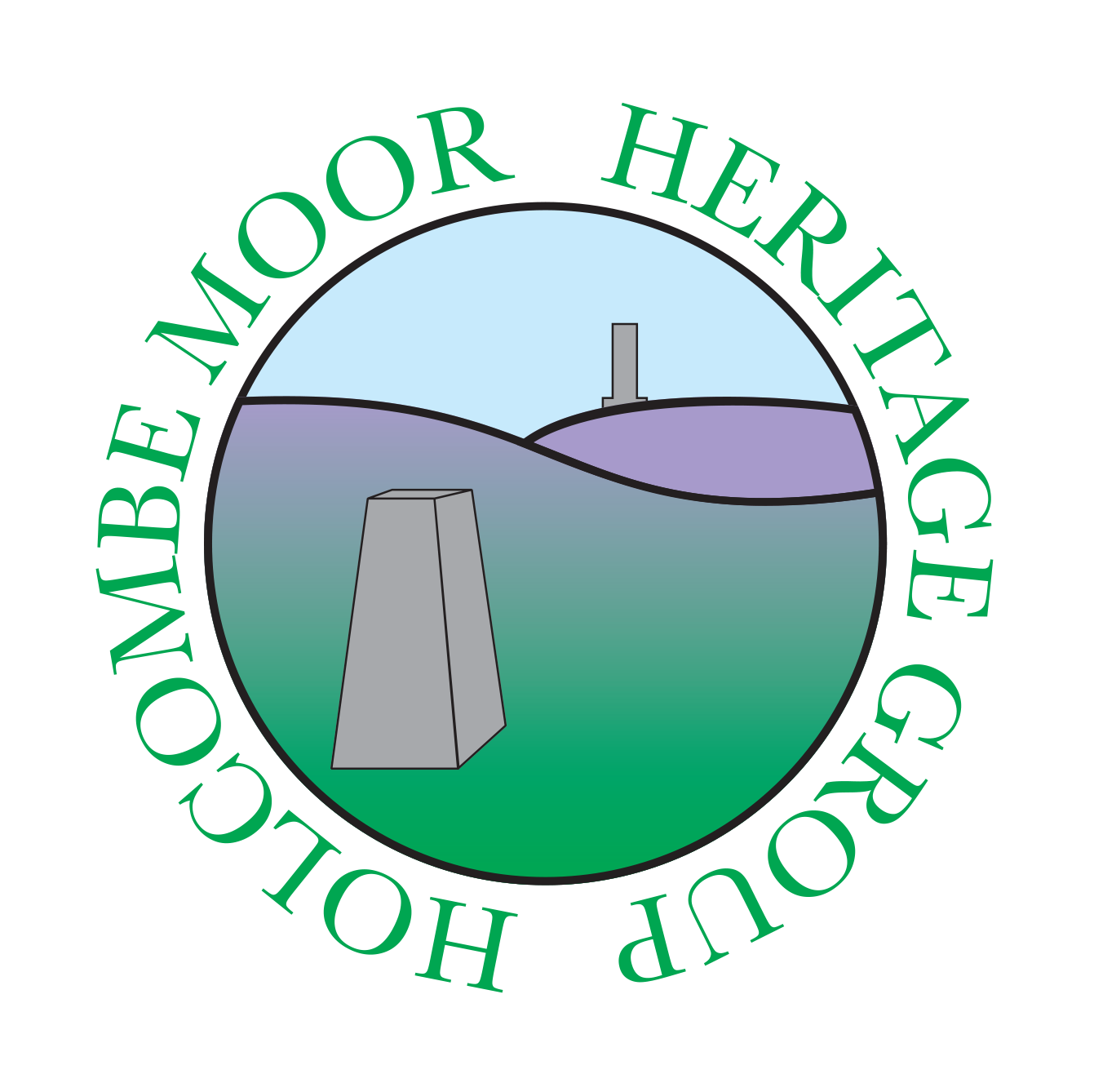

Several trenches were marked out and de-turfed ready for the opening weekend.
Thursday was one of those days which we have not seen very often this year, sunny and warm; perfect conditions for digging.
As there were only 4 diggers on site the decision was taken to have everyone working in trench 1, which is large enough to maintain social distancing. Photo 1.
Trench 1 was laid out to investigate the 2nd furnace located at the end of the 2019 dig. The furnace is still covered from 2019, and lies under a black plastic sheet and the 2019 backfill. The corner of the plastic is just visible near the top of photo 2. In photo 3, there is a distinct cobbled edge running east to west to the left of the vertical ranging pole. This, together with the archaeology uncovered in the excavation running north to south to the right of the vertical ranging pole, would tend to indicate that the furnace tapping channel runs from east to west from the furnace. This hypothesis will be determined once further excavations are carried out.
Investigations in the southern end of the trench were on a small concentration of slag uncovered during the previous weekend’s dig. By the end of the day a number of stacked, roughly circular pancakes of thick slag, with high concentrations of iron, were uncovered. One theory is the slag layers could be the remains of abandoned furnace bases. It is interesting to note that the layers are fused together and the lower layers are brittle compared to the very solid upper layers. Photo 4. Hopefully, once the remaining topsoil between this slag deposit and the furnace is removed, we will have a better understanding as to the origins of the layers.
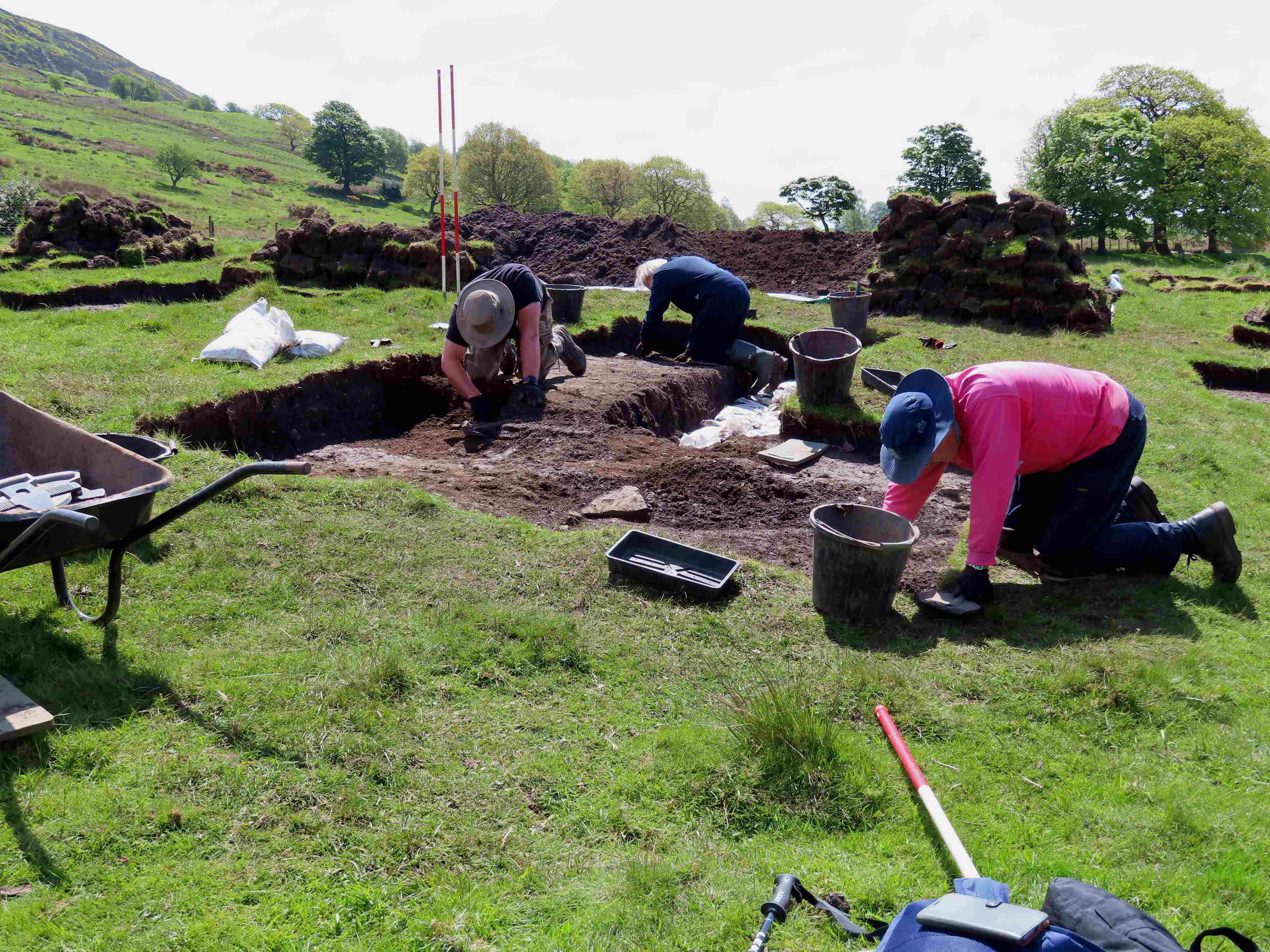
Photo 1
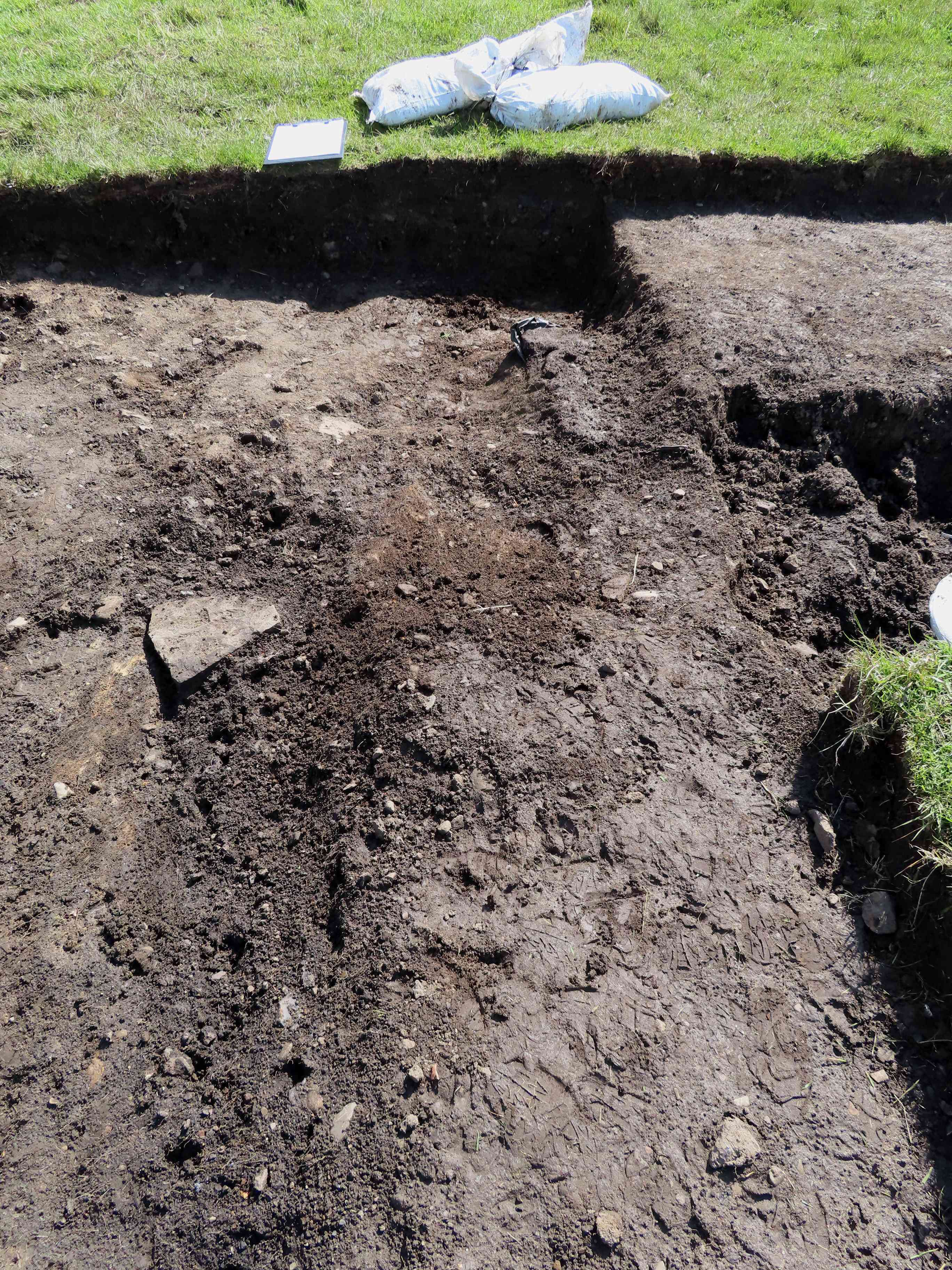
Photo 2
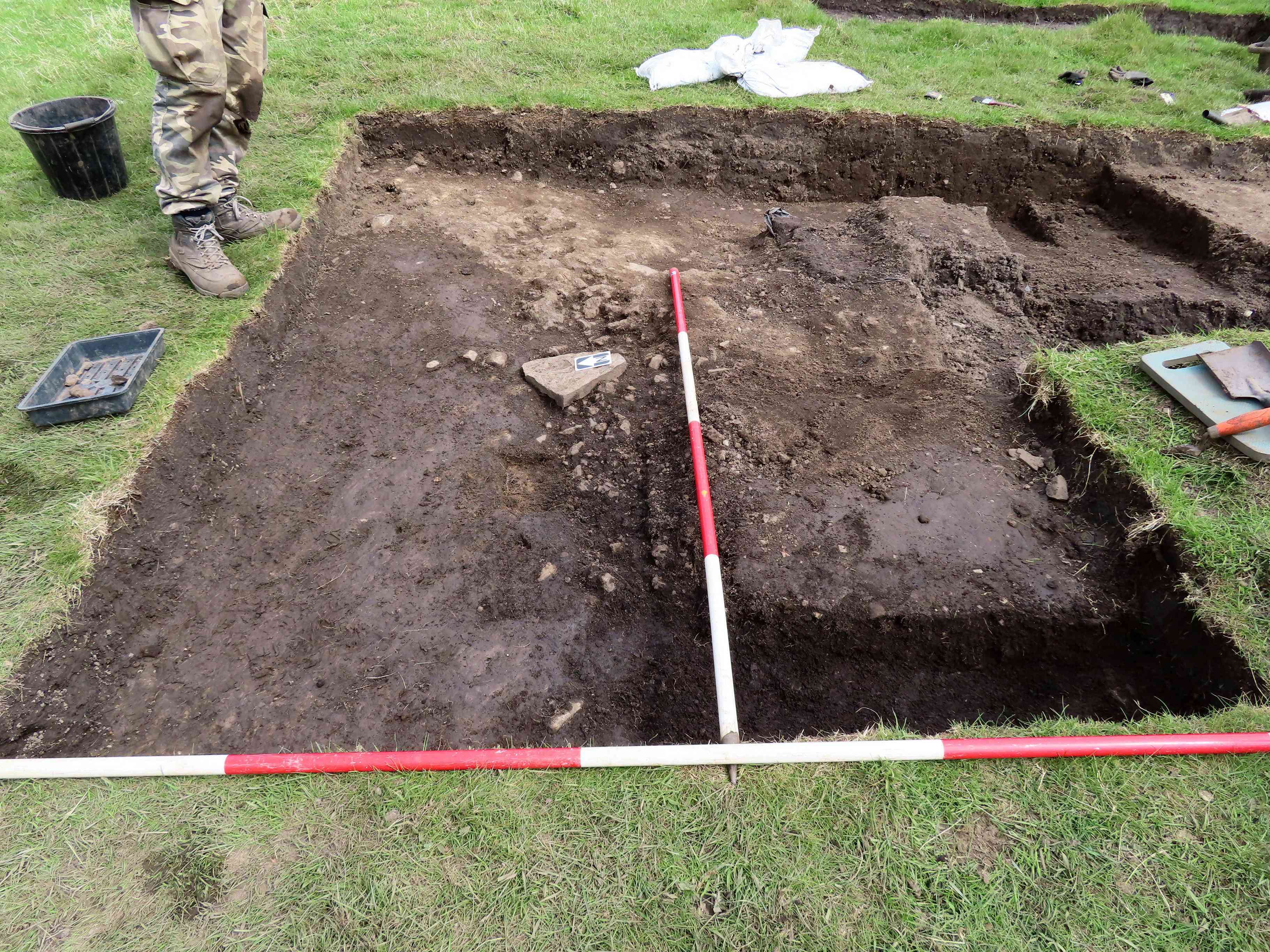
Photo 3
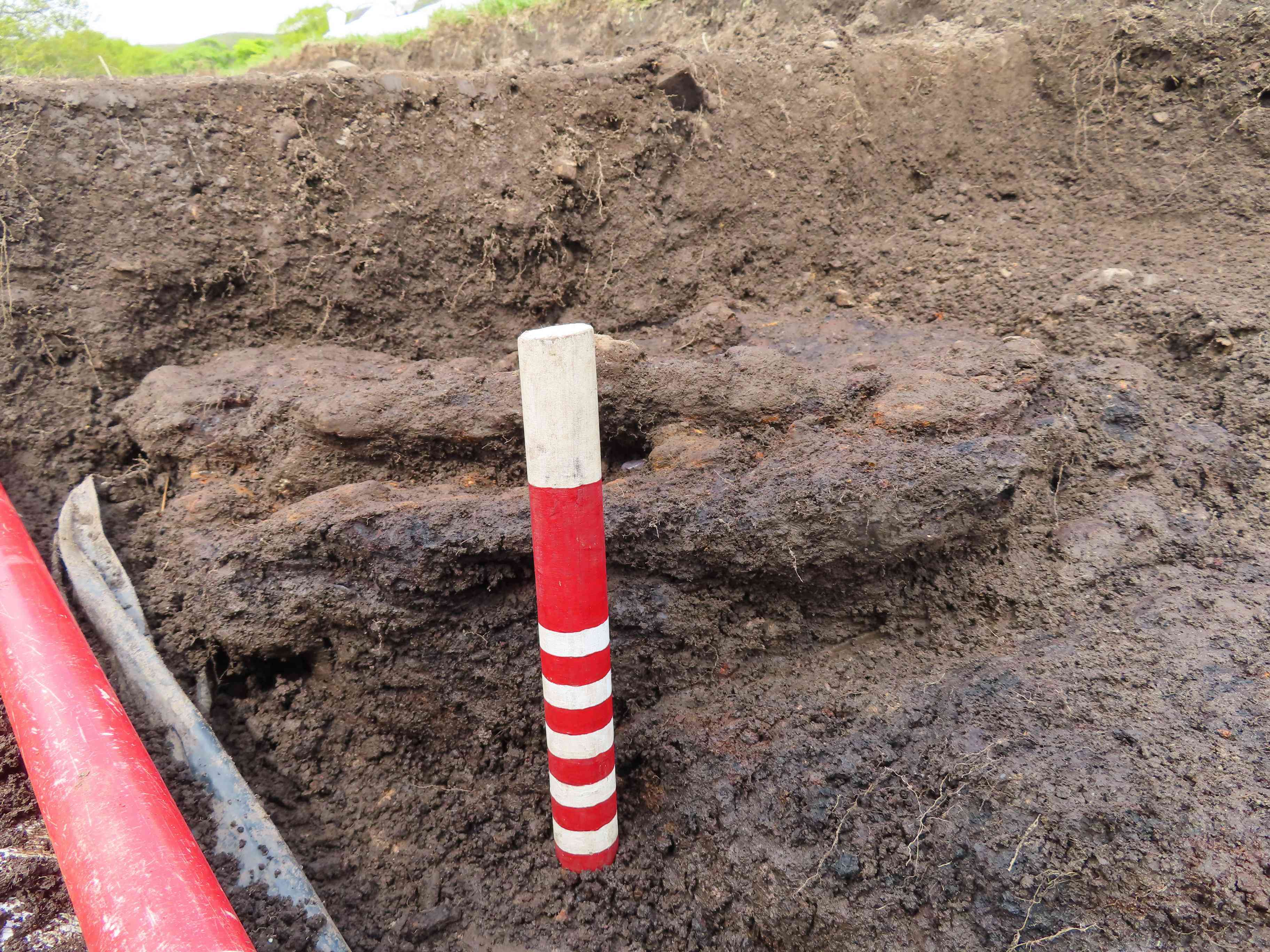
Photo 4
Weather wise it was a sunny, hot day, but perhaps a bit too warm at times.
Attendance numbers meant it was possible to work on 4 trenches these being trenches 5, 6, 1 and 9. Please refer to the attached trench positions plan for identification purposes.
The good weather which has prevailed for a number of weeks has unfortunately baked the exposed soil in the trenches, leaving it very hard and difficult to excavate. Another disadvantage is the overall bleached colour of the ground makes it very difficult to detect slight changes in colour which could indicate different contexts.
Trench 5 Photos 1 & 2
Work concentrated on the west end of the trench clearing to the east. Unfortunately, due to the conditions described above, progress was very slow. It was, however, possible to identify 4 possible post holes mainly due to the lack of stones and slight changes in context in 4 particular locations. These features will have to be investigated further. Unfortunately, due to the state of the soil, it was not possible to get any photographic evidence of the 4 features. It may be necessary to spray the area with a fine mist of water to try to bring out the features.
No finds other than 1 small sherd of pottery were recovered from this trench.
Trench 6 Photos 3 & 4
As with trench 5 the compacted, baked condition of the soil made for slow and tedious excavations. The only finds were a couple of small sherds of late pottery, and a few chunks of slag. Very poor returns for a day’s work.
Trench 1 Photo 5
Work continued removing the topsoil from the stacked, roughly circular pancakes of thick slag northwards to the 2nd bloomery. Photo 6. The section of topsoil removed was completely devoid of any finds.
Fortunately, the northern section of the trench had been covered with a tarpaulin, so the ground was fairly moist and easier to work. Further cleaning of the run of slag from the west side of the 2nd bloomery to the west end of the trench was carried out. This would appear to be the tapping channel from the furnace. Confirmation of this should be available once the bloomery base is excavated further. Photo 7.
The second bloomery furnace base was uncovered and lightly cleaned. The remains of the various circular walls of the bloomery are starting to show up very clearly. Photo 8.
Trench 9 Photo 9
Unfortunately, this was another trench which had been exposed to the sun and was baked hard. Removal of the topsoil was very slow as a result.
Towards the end of the day a sondage (a small test excavation or test pit to examine the stratigraphy of a site; a deeper investigation of a small part of a larger trench). – from Google - was dug in the northwest corner of the trench to ascertain the depth of the topsoil. A thick layer of slag was encountered at a depth of over half a metre. Photo 10. If this is reflected in the rest of the trench a lot of topsoil is going to have to be removed to uncover the extent of the slag.
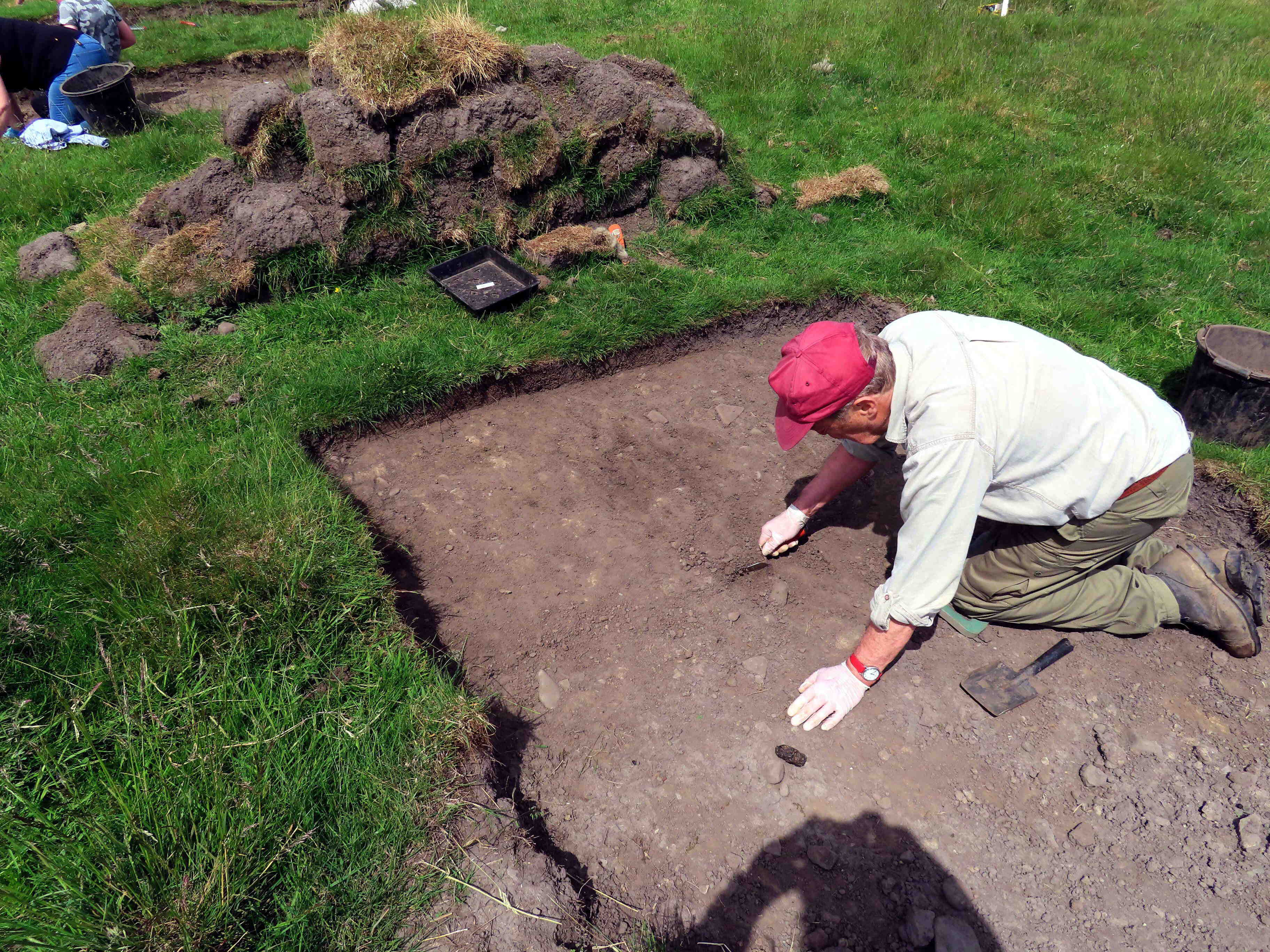
Photo 1
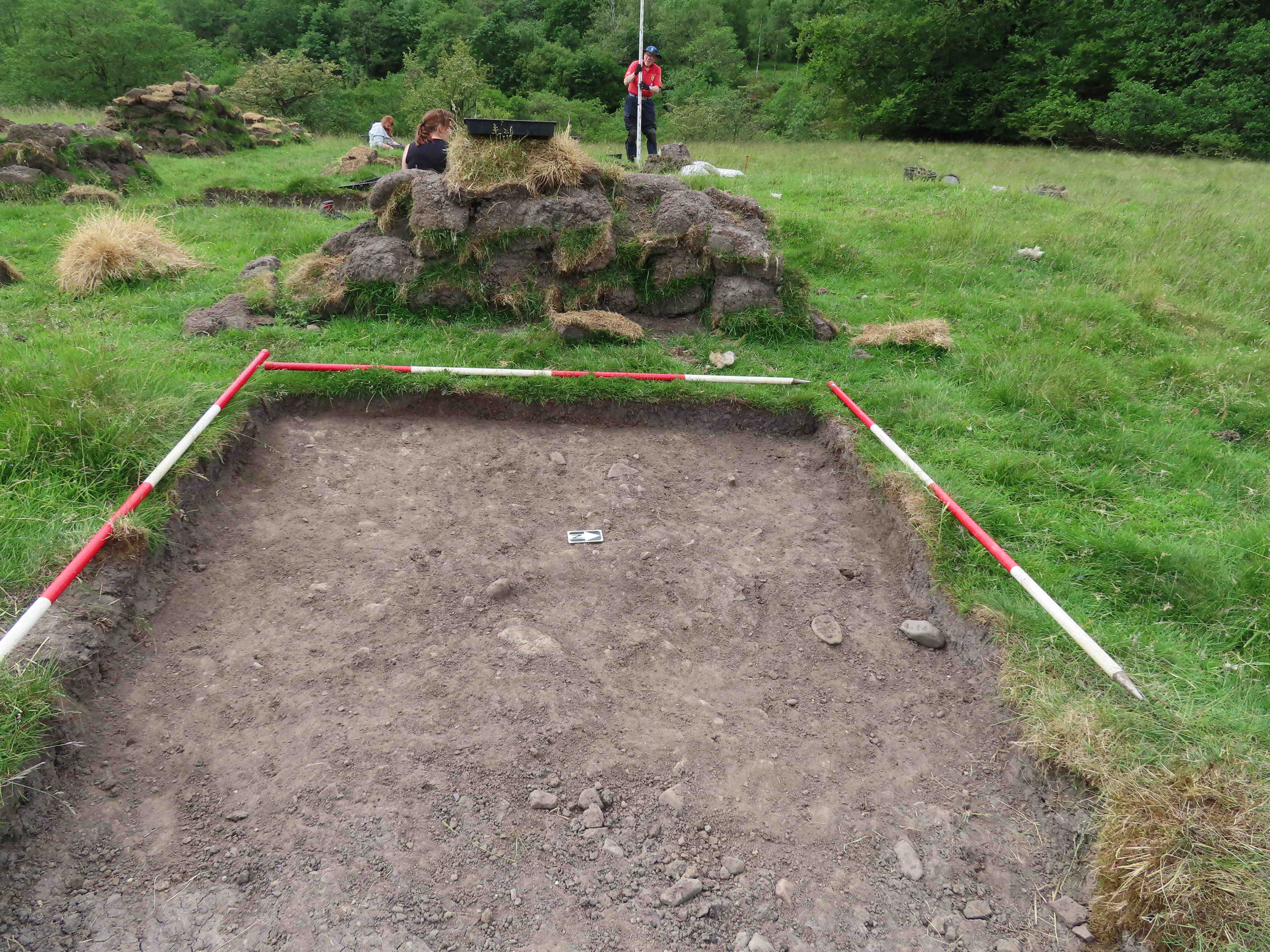
Photo 2

Photo 3
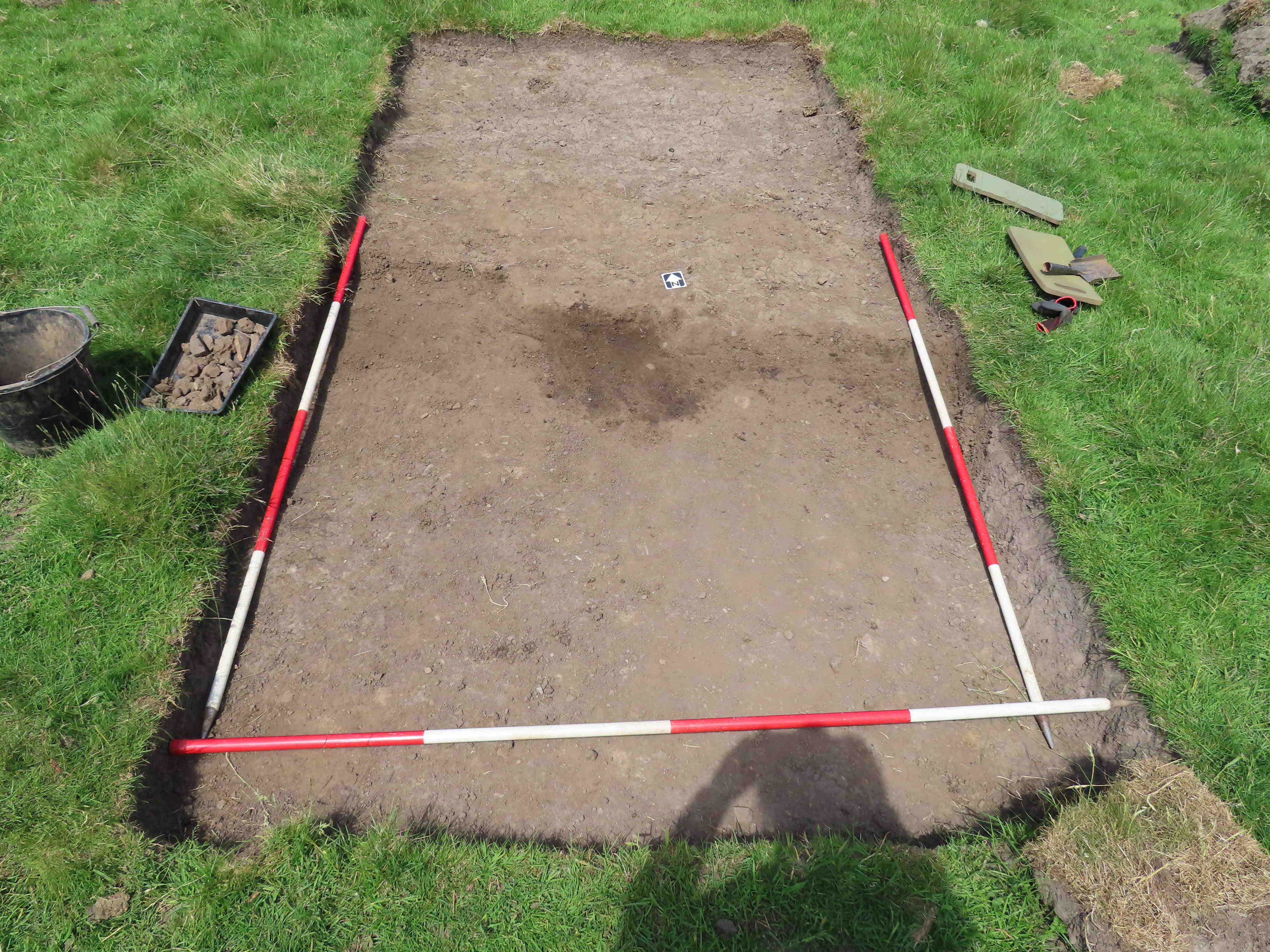
Photo 4
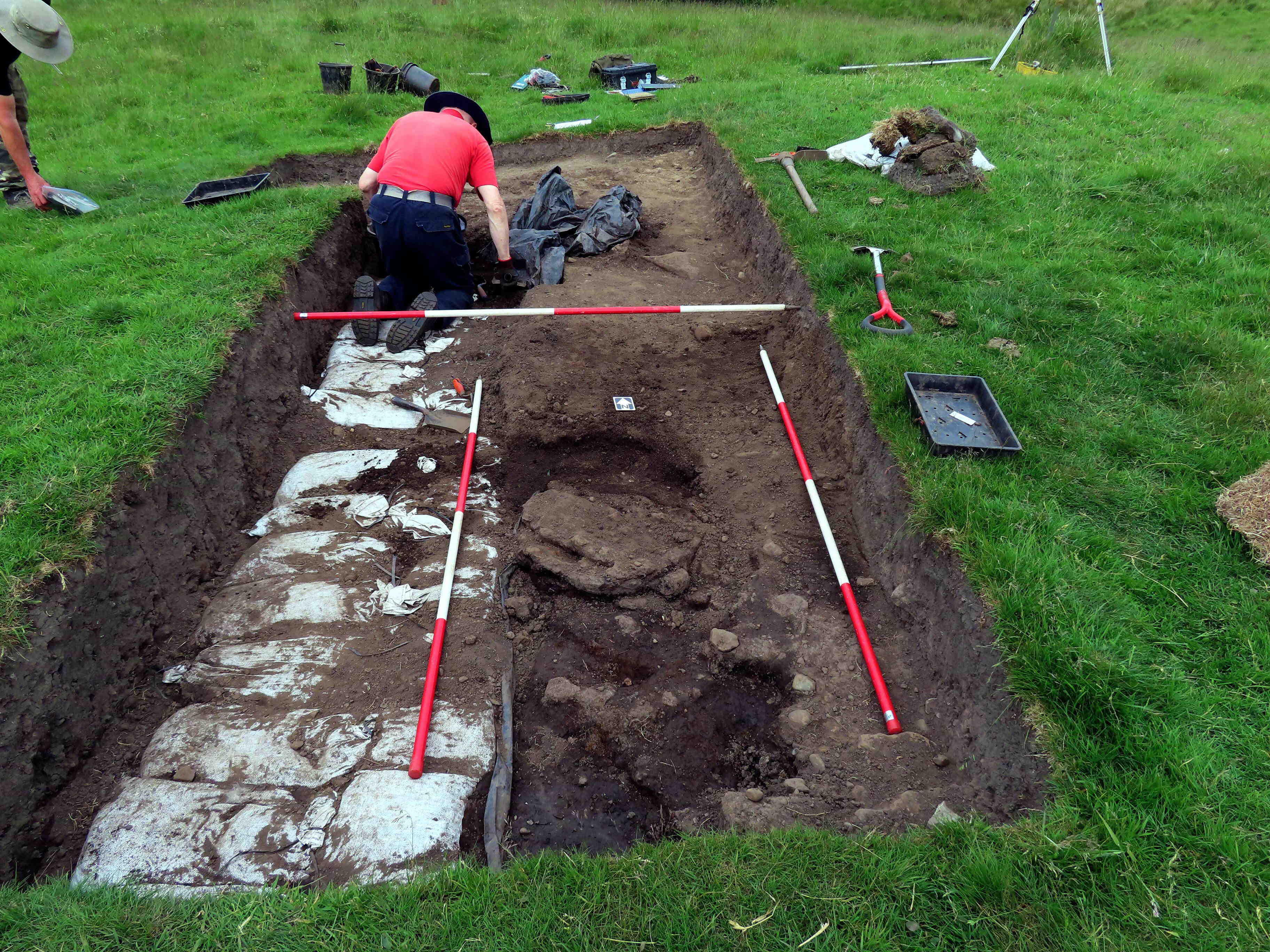
Photo 5
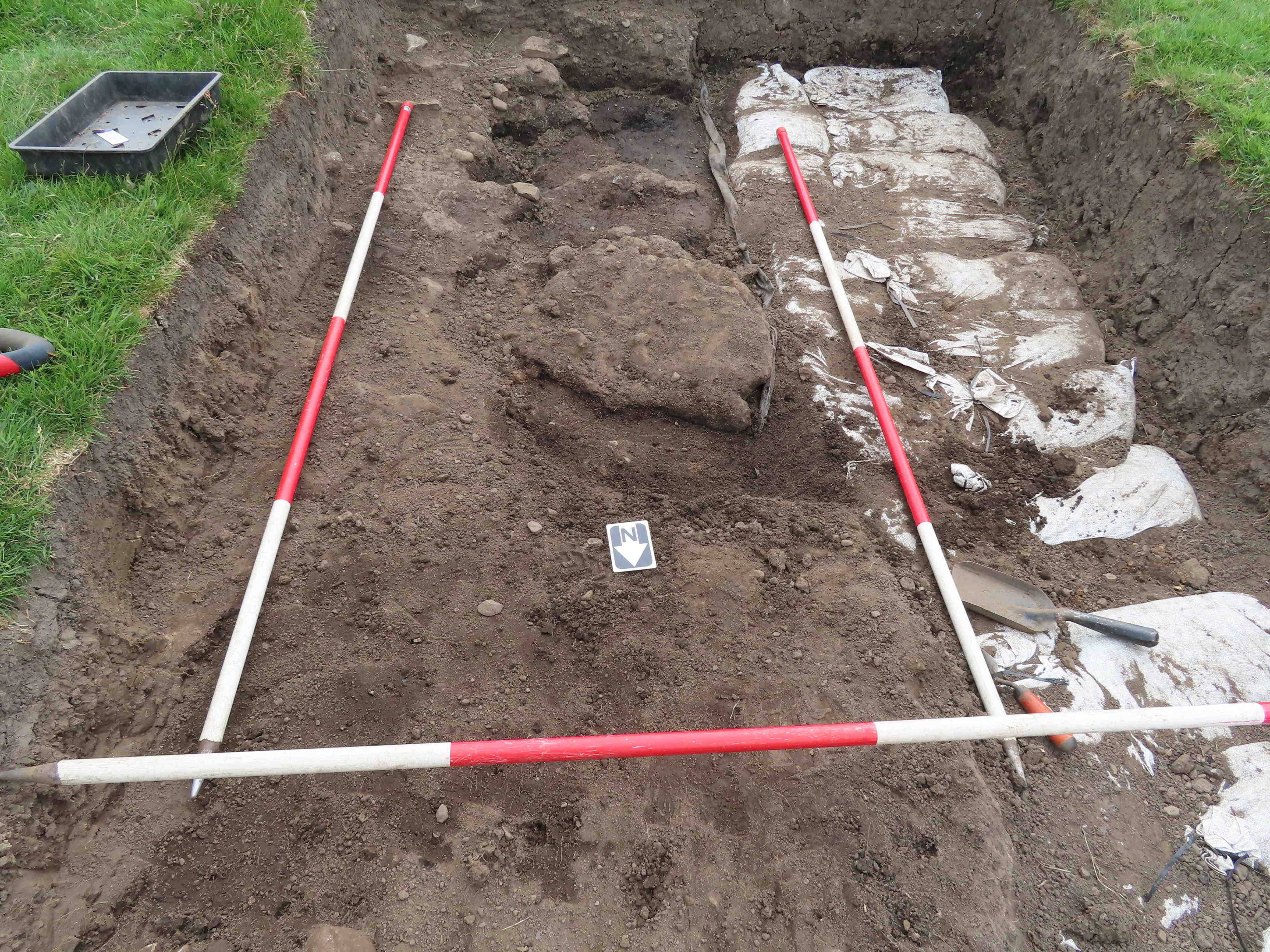
Photo 6
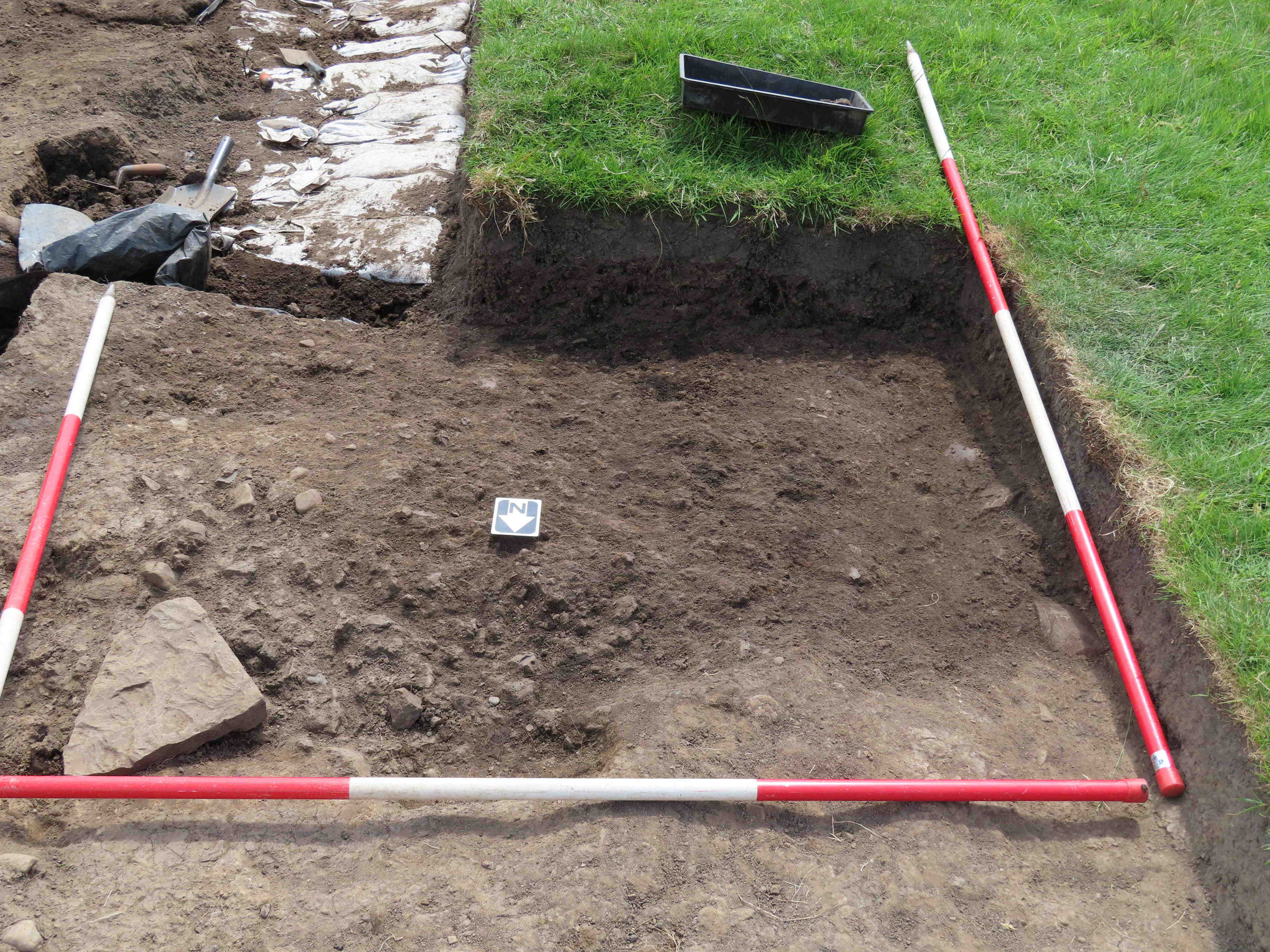
Photo 7
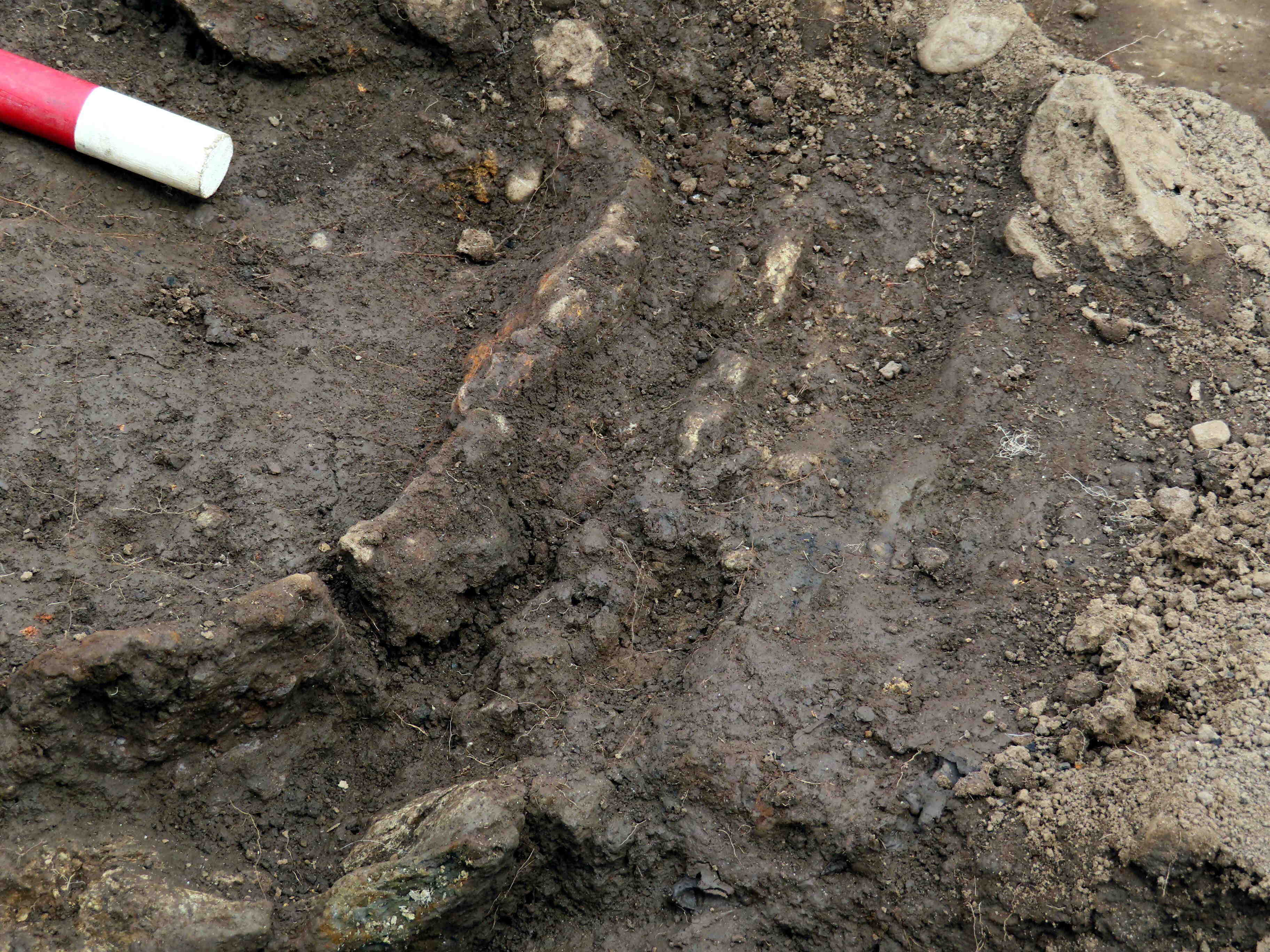
Photo 8
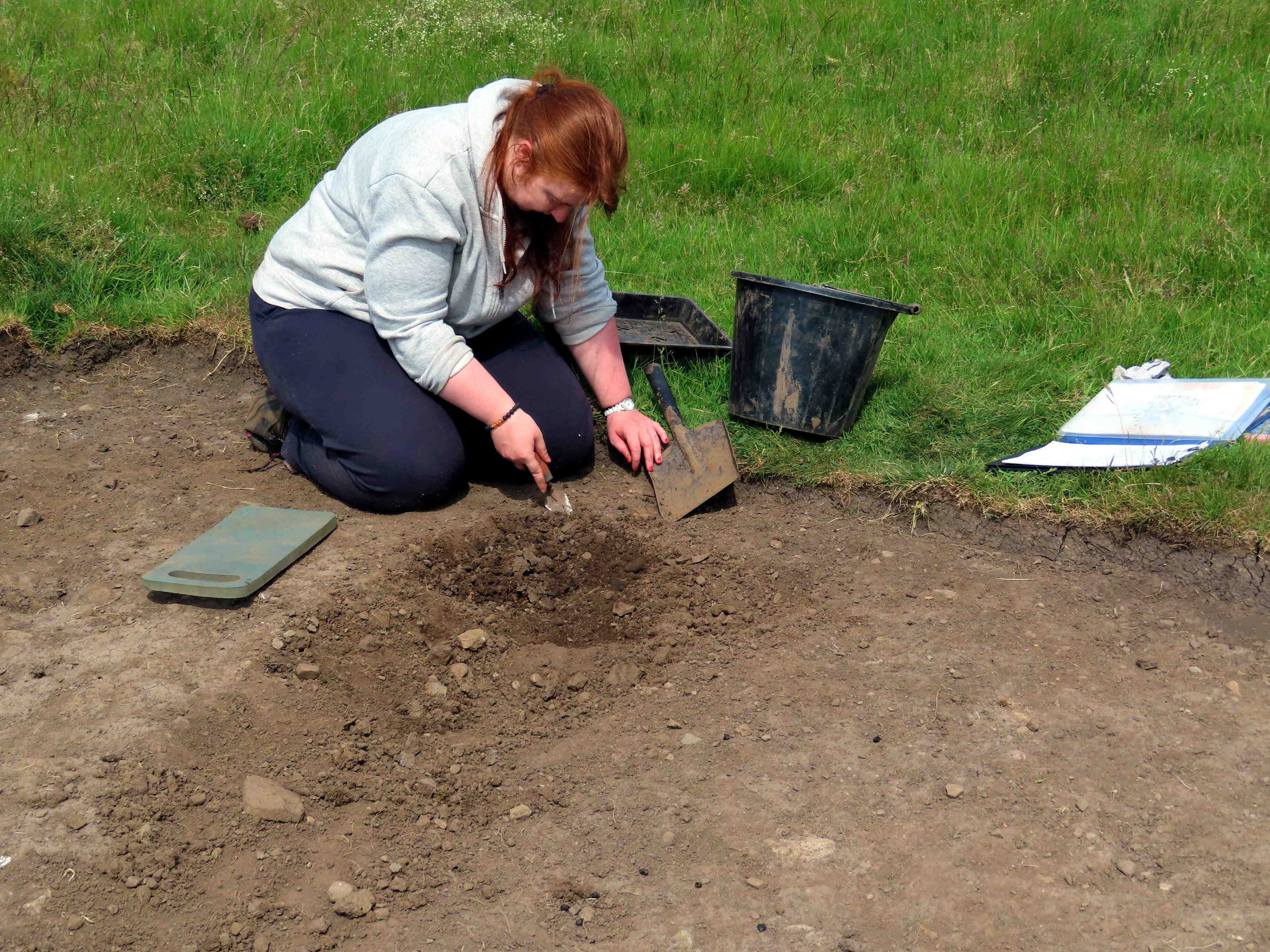
Photo 9
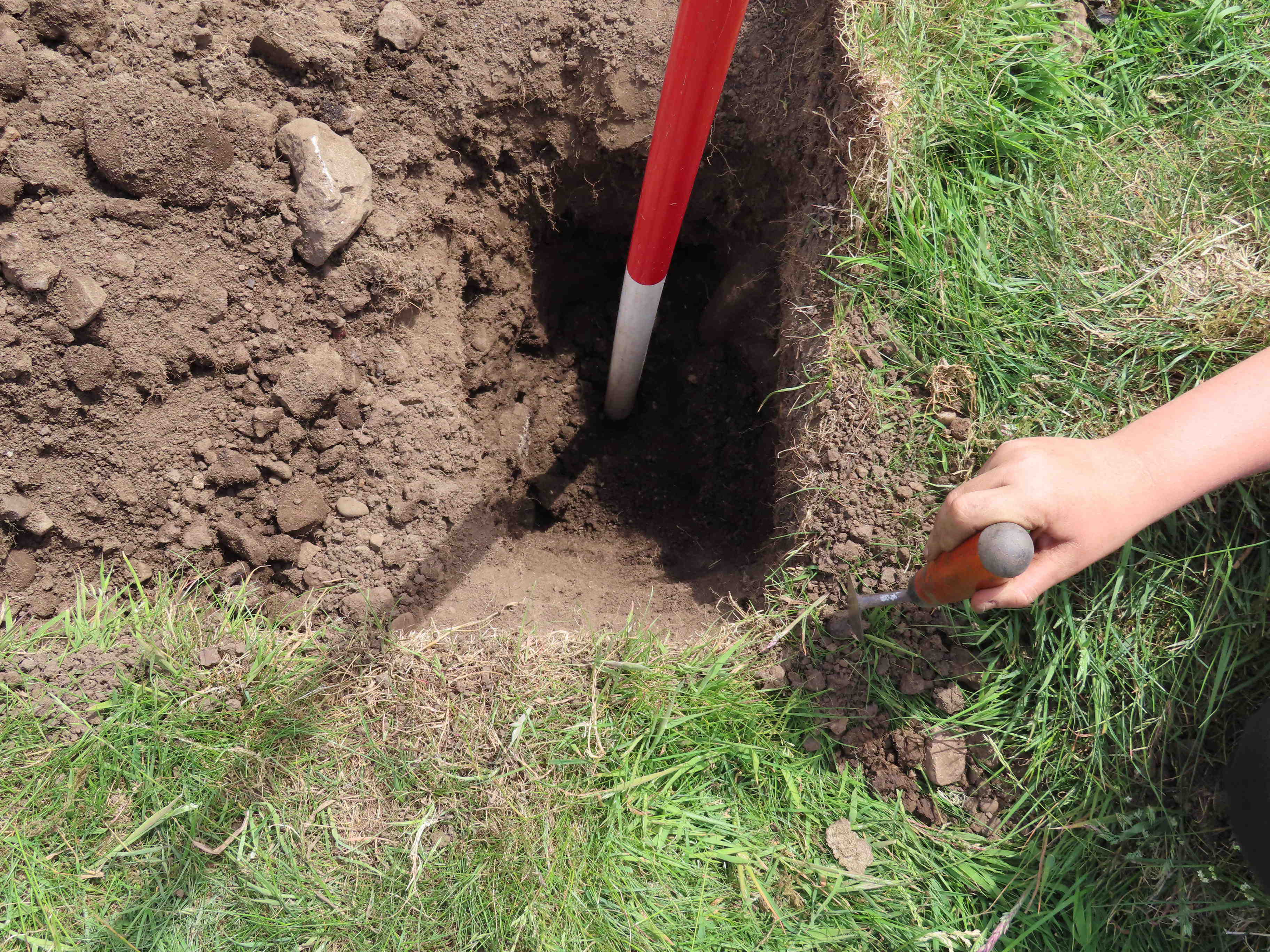
photo 10
Dig report for Saturday and Sunday 19th and 20th June 2021
Weather: The Saturday was sunny and hot, while the Sunday was overcast and cool.
Trench 1
Work concentrated on the area around the furnace base and westwards along the possible path of the tapping channel. The layer of slag running east to west was removed to reveal an underlying layer of fine pieces of compressed charcoal ash. This layer extended to the north, where it butted up against a thick layer of deposited clay. Work currently on-going, removing the charcoal ash layer to access the clay layer beneath it. Photo 1. Work immediately to the north of the furnace uncovered a number of large stones which have been deliberately laid. The purpose of these stones is currently unknown. Hopefully, as more of this area is excavated, their purpose may become apparent. A deposited clay layer extends from the stones to the northern edge of the trench. Photo 1 also.
Work was also carried out clearing the area just to the north of the pieces of rounded slag to identify a cut coming through the trench in a westerly direction, going through to 2019’s trench 5. Photo 2
There is an interesting large deposit of compressed charcoal ash in the southeast corner of the trench together with quantities of hammer scale. These items could indicate that a smithy hearth existed in the immediate area. This would have been where the bloom was heated then hammered to remove impurities before being shipped off for further processing. Current thoughts are that the large flattened pieces of slag could be discarded parts of the smithy hearth. Photo 2 as well
Trench 2West
Steady progress has been made removing the topsoil from the trench. The hard ground, combined with the stones and slag in the trench, makes progress slow. Photo 3. Finds consisted of two mediæval pottery sherds, a broken clay pipe stem and 5 sherds of post mediæval pottery. Hopefully as more topsoil is removed things will get a lot more interesting in this trench.
Trench 4
Despite the soil being baked hard by the sun, steady progress was made removing the topsoil from the trench. Disappointingly very few finds have been recovered from the trench since it was opened. Over the weekend a small number of post mediæval pottery sherds and a piece of a jug handle were recovered. Photo 4. Red rust patches, normally caused by rusting hammer scale has been uncovered in the trench. Photo 5
Hopefully as the trench goes deeper the number of finds will increase.
Trench 6
Good progress has been made in this trench with the removal of a significant amount of the topsoil Photo 6. On Saturday a small sherd of mediæval pottery was recovered from the upper topsoil layer. On Sunday a further two sherds of mediæval pottery were recovered from the upper layer and one sherd of mediæval from the lower level. Photo 7. There were also a small number of post mediæval pottery sherds recovered. Over time this could prove to be an interesting trench.
Trench 9
Good progress has also been made on this trench. The upper layer together with a good portion of the 2nd layer of topsoil have been removed. At one stage in the north east portion of the trench a section of a slag deposit appeared to be running from east to west, cutting into the natural deposit which consisted mainly of stones. Photos 8 and 9. However, further work on this section failed to produce any significant items of interest. Finds from the trench consisted of a short, broken length of a clay pipe stem and numerous small sherds of post mediæval pottery.
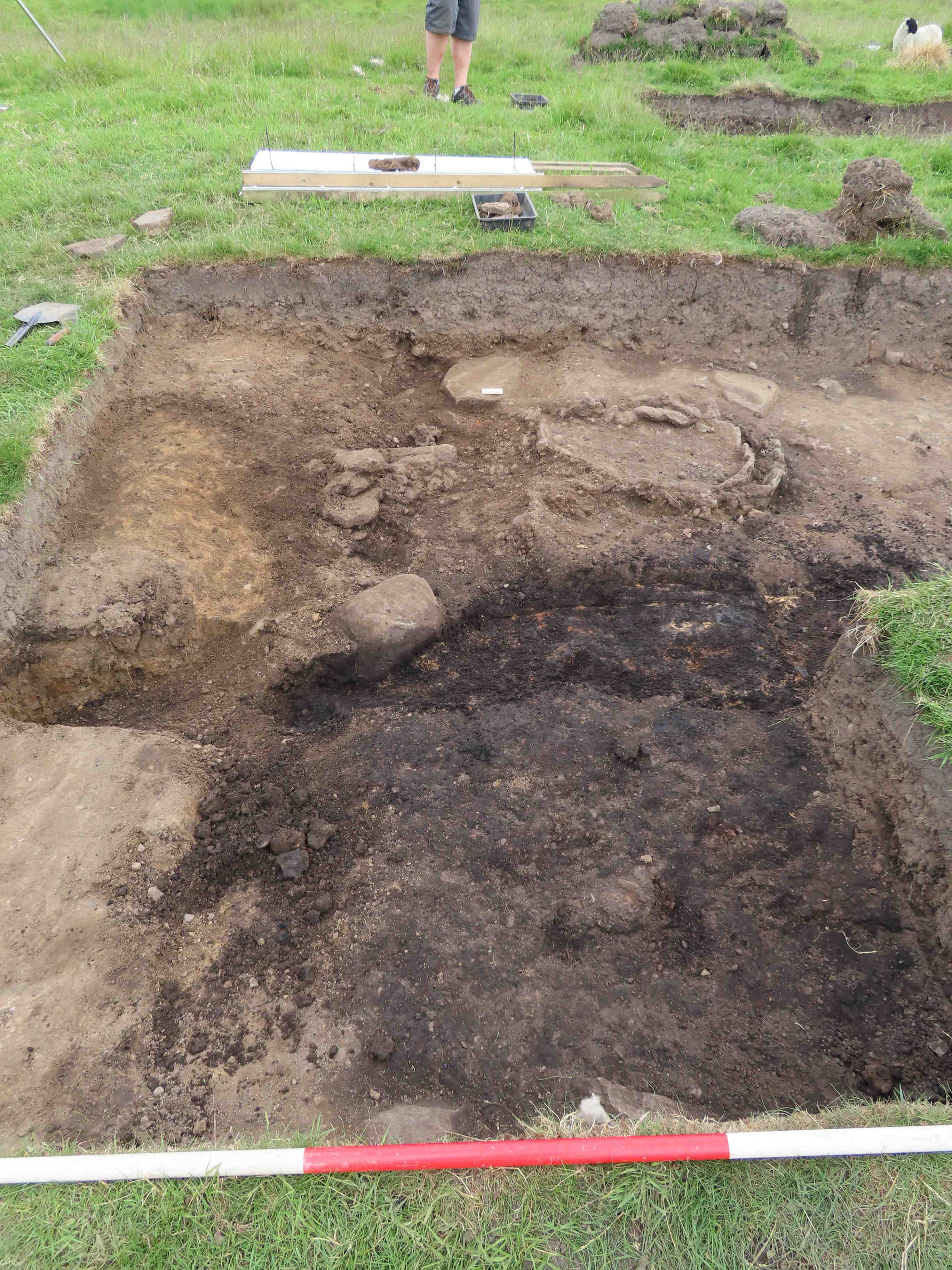
Photo 1

Photo 2
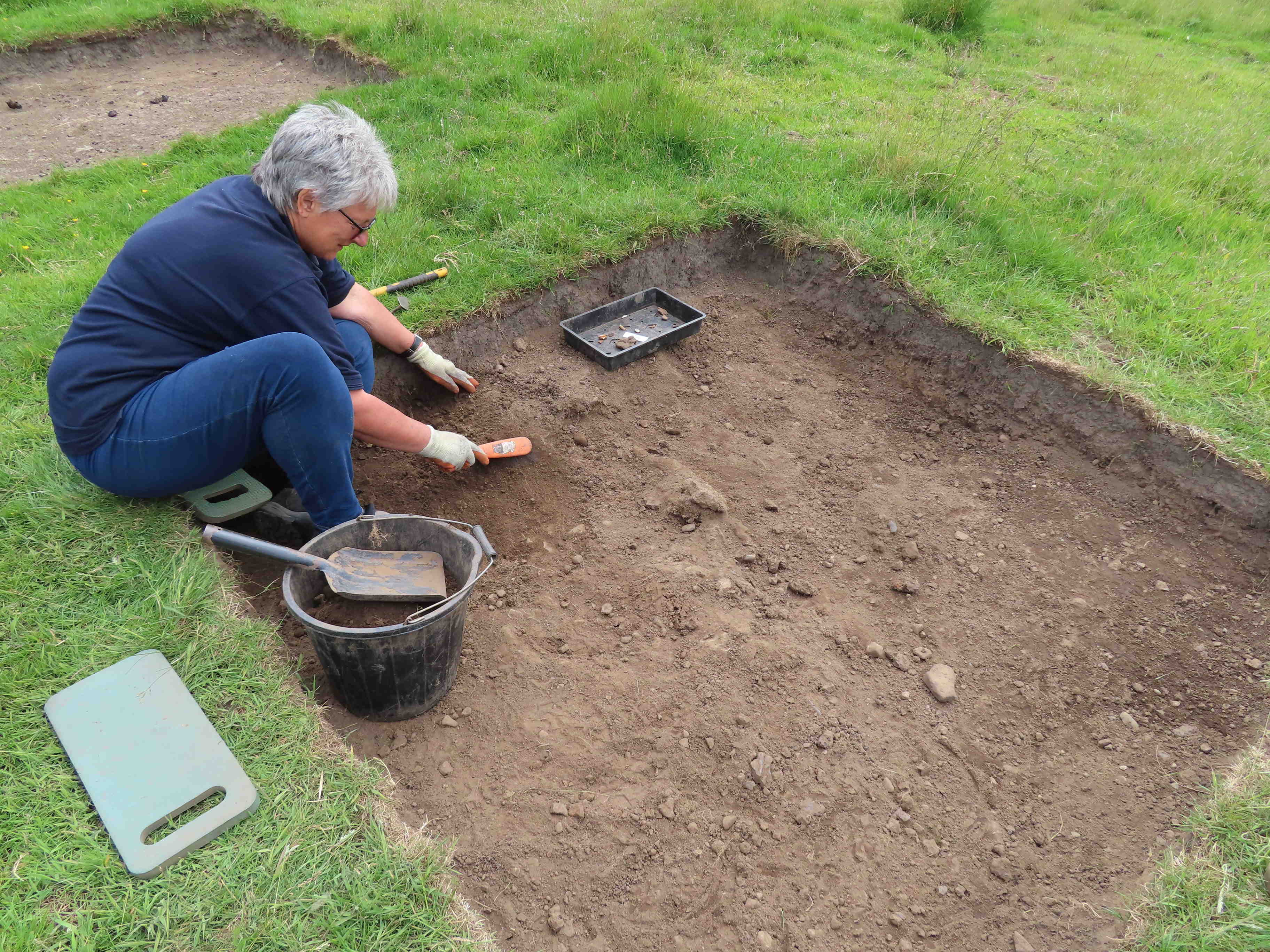
Photo 3
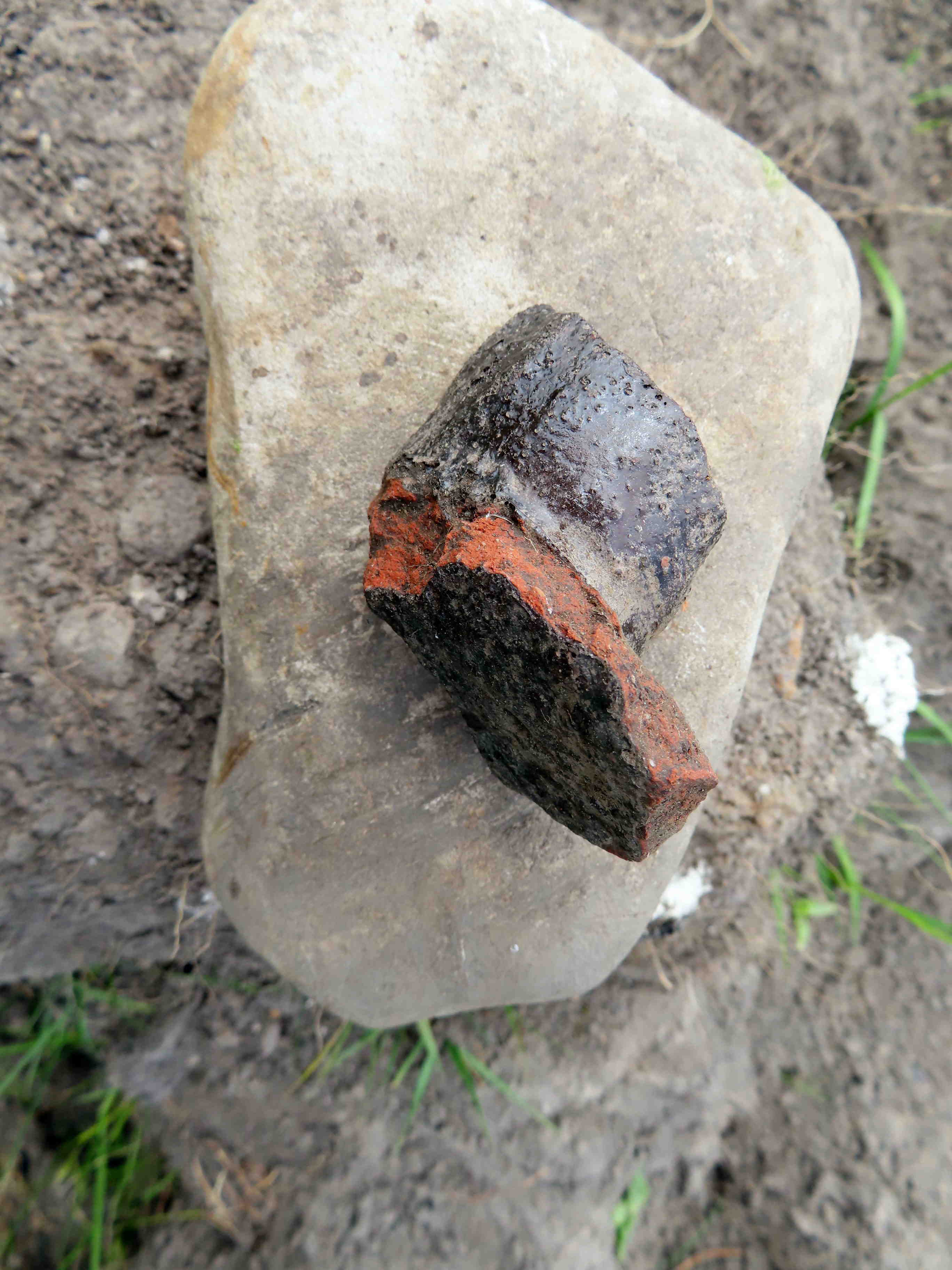
Photo 4
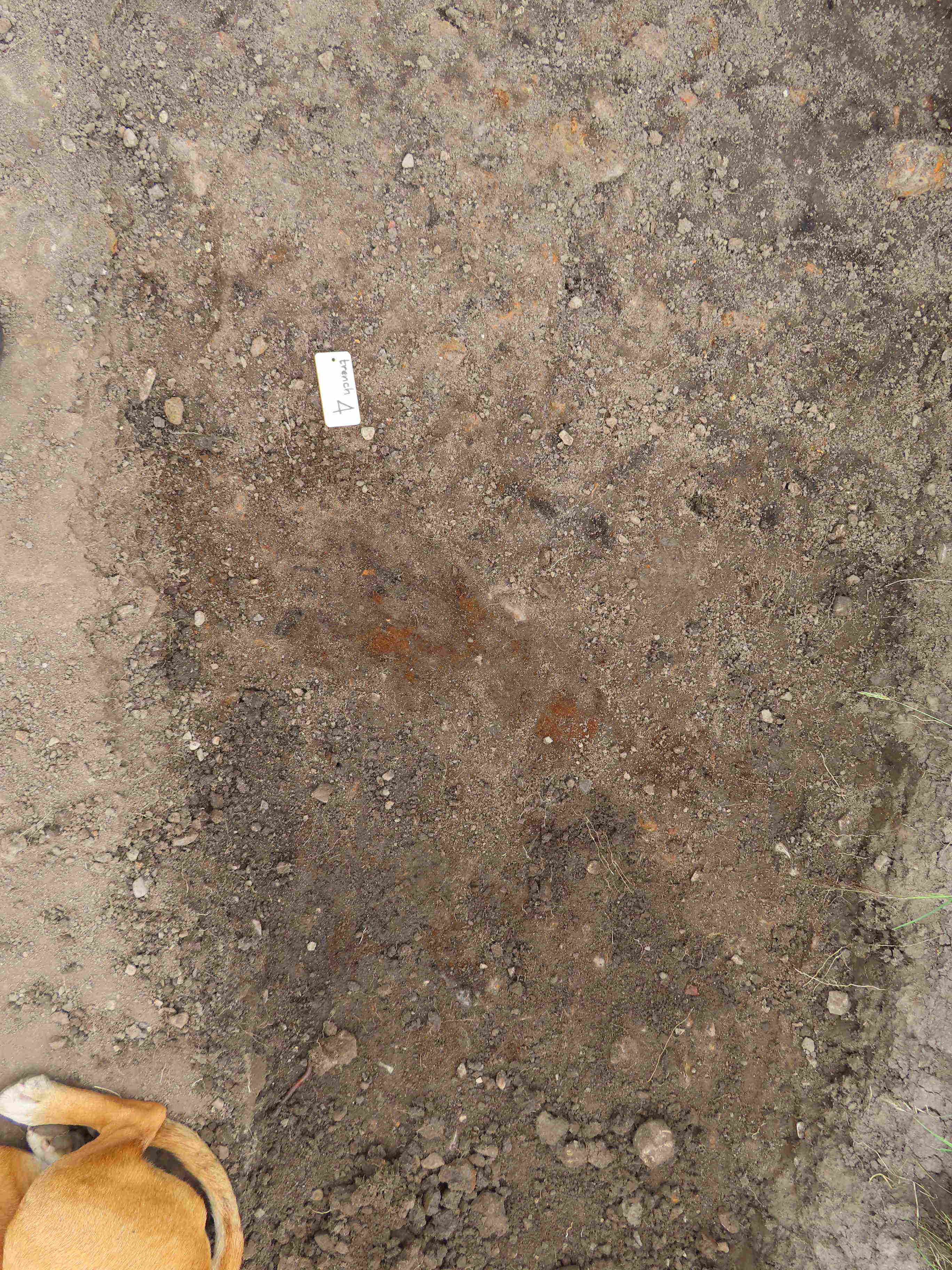
Photo 5
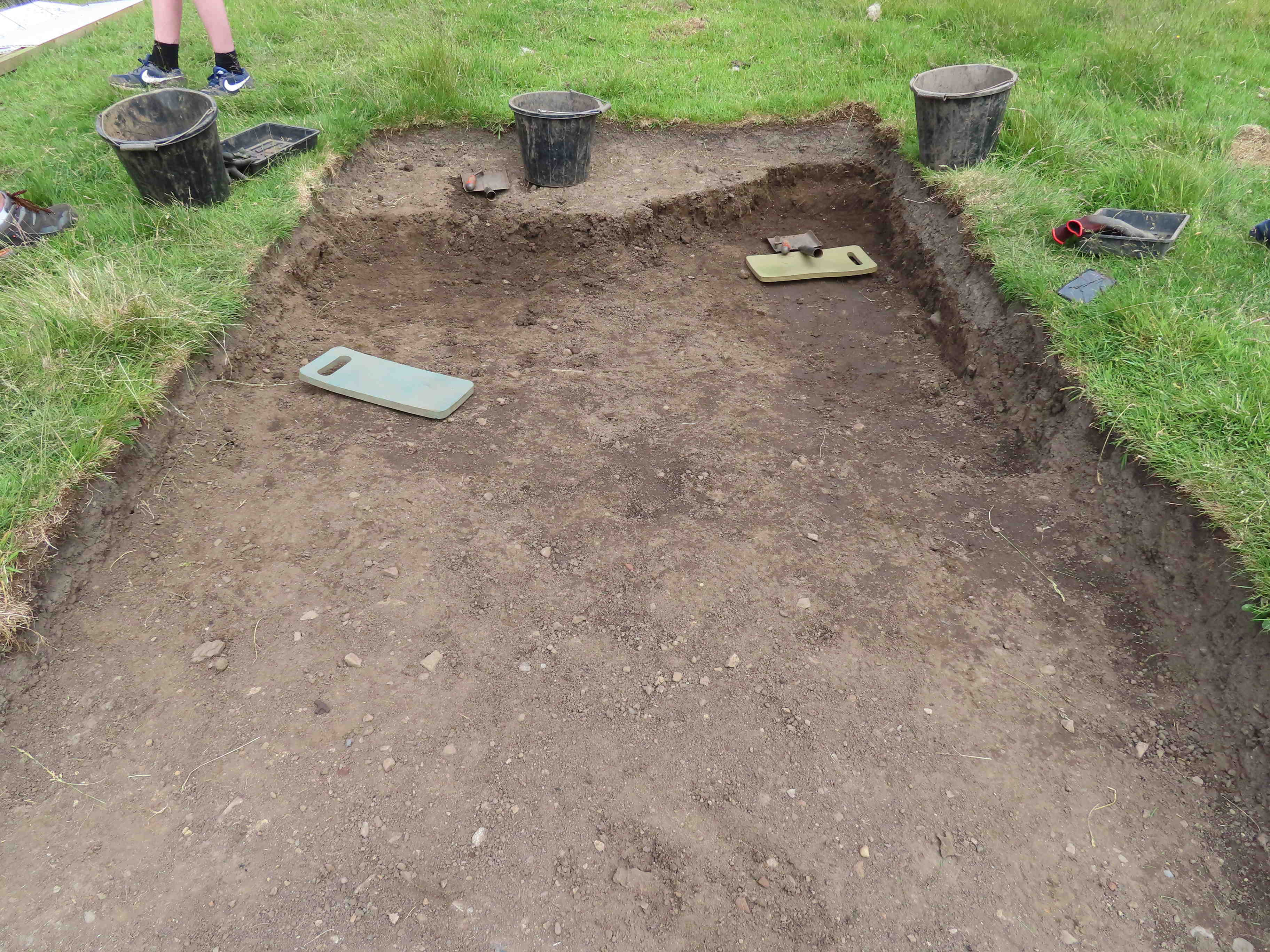
Photo 6
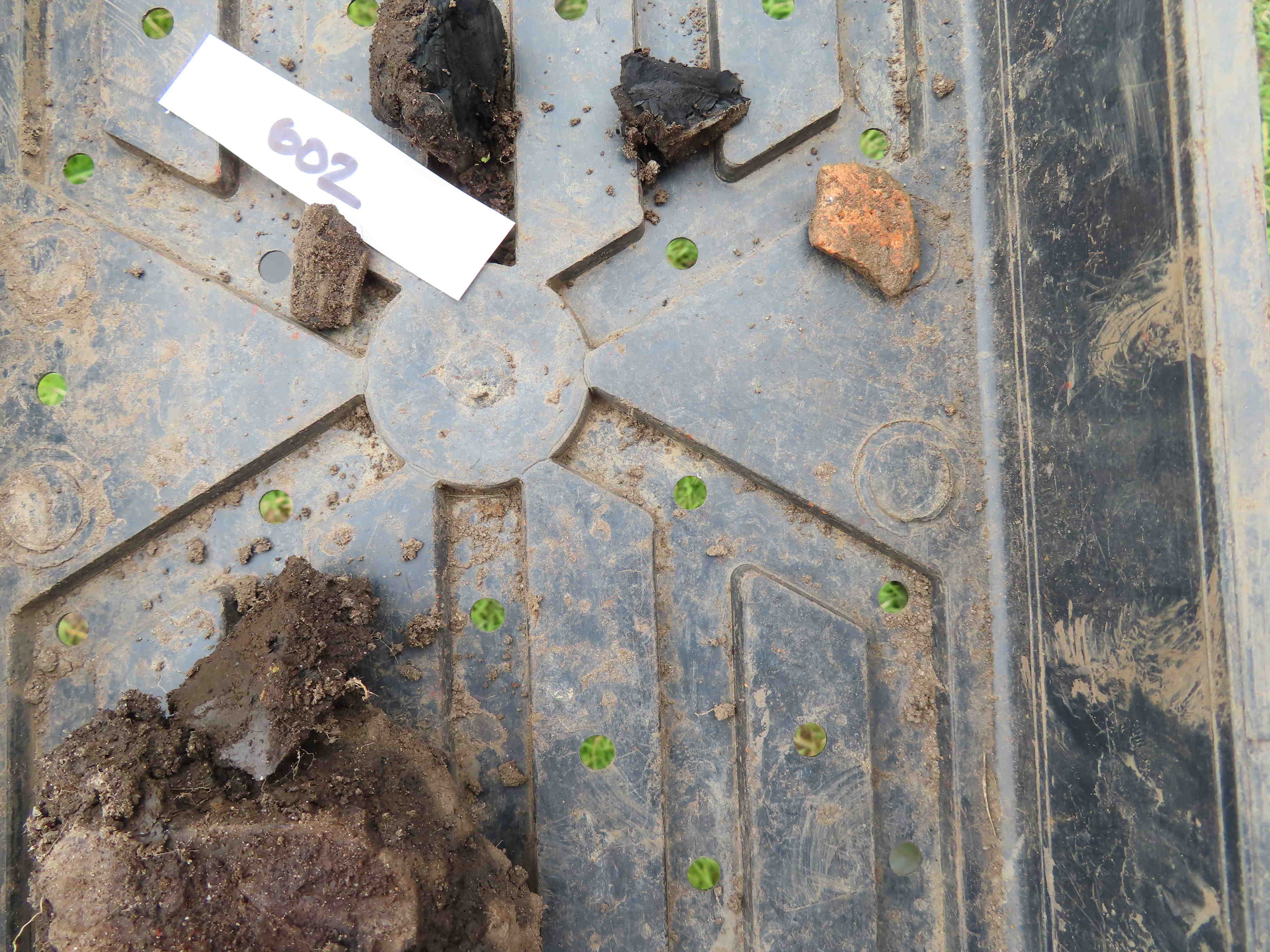
Photo 7
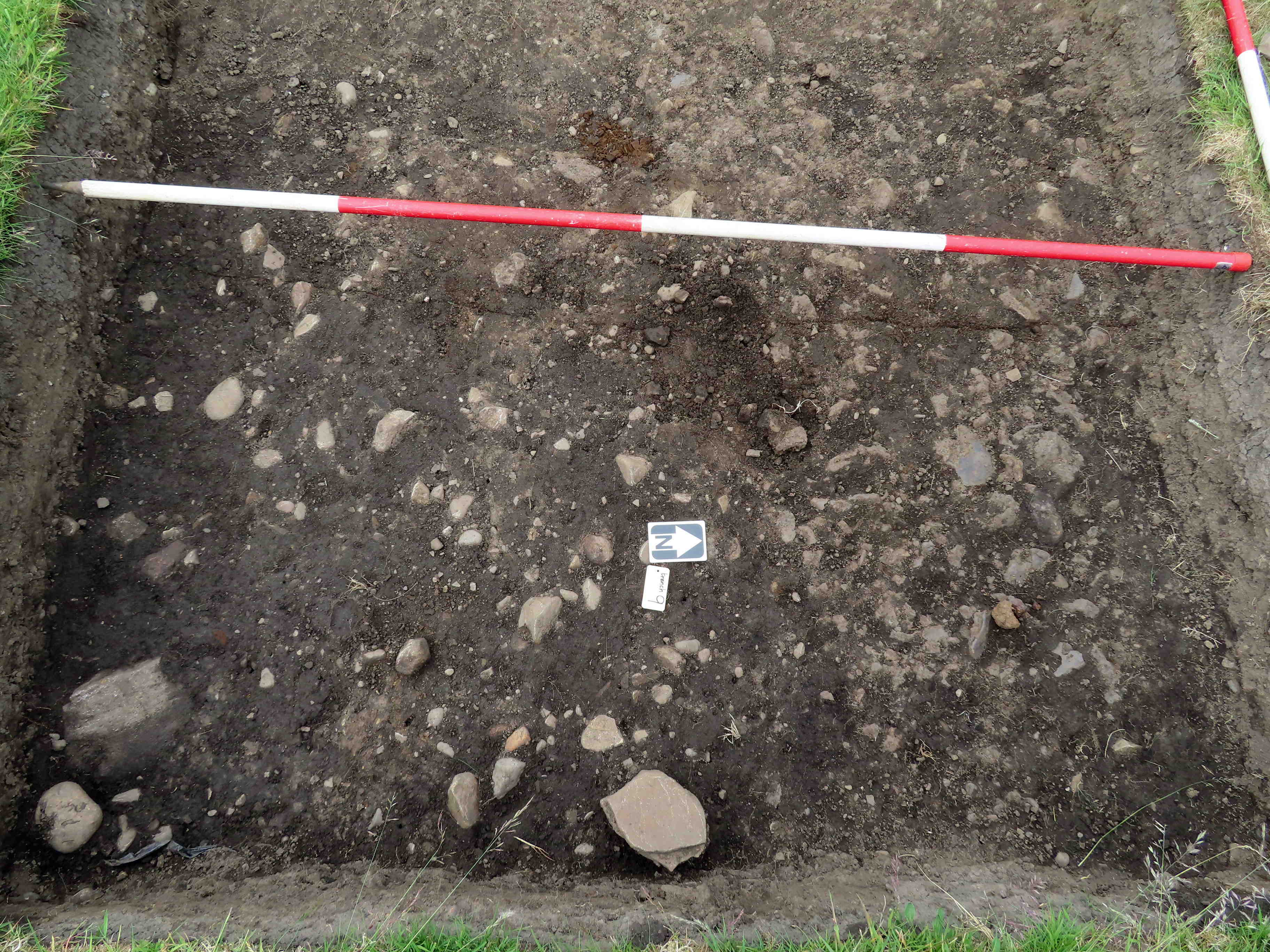
Photo 8

Photo 9
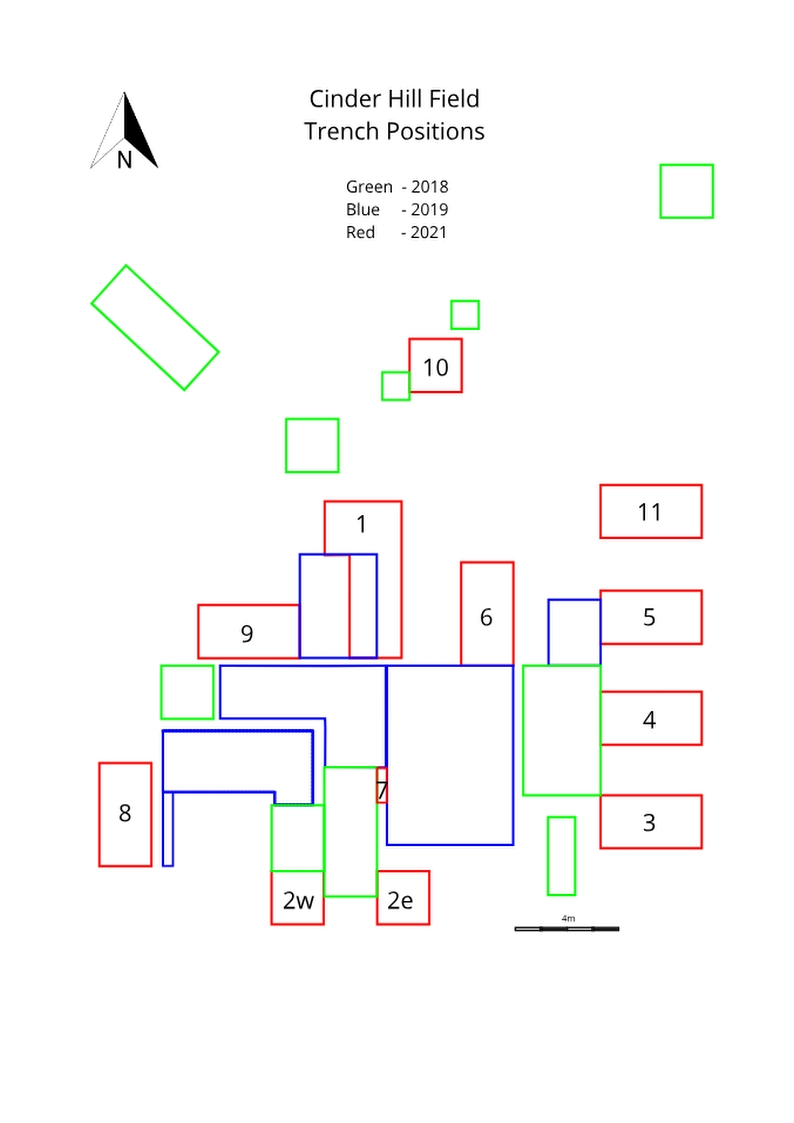
Ground Plan
Weather overcast with a few sunny periods.
Trench 1
Work continued removing the crushed charcoal layer between the bloomery and the west wall of the trench from the underlying clay layer. Work also continued on the removal of the deposited clay situated between the charcoal layer and the north wall of the trench. It would appear that this clay layer was deposited after the crushed charcoal layer was laid down as it overlays the charcoal layer. Photos 1 and 2. A small sherd of 17 century slipware pottery was recovered from the clay laid down near the northern wall of the trench photo 2a.
Further investigations were carried out on the negative feature, just north of the three flat lumps of slag, which runs from east to west through the trench. Initially it was thought to be a drain or very shallow trench but, due to its shape, this theory is now open to conjecture. Photo 3.
Trench 6
Even though the condition of the ground in this trench is not conducive to rapid excavation the team made excellent progress and, in the process, recovered two respectable size pieces of mediæval potters and one piece of post mediæval Photos 4 and 5. Sometimes you get trenches like this that just keep producing the odd tantalising find to keep the archaeologists plugging away at it in the hope of striking a mother load of archaeology. You never know what the next turn of the trowel will unearth.
Trench 9
Discussions and excavations continue on this trench photo 6. The various sized stones unearthed are just too random to form any meaningful archaeology i.e. they do not form flooring or cobbled pathways. There is however, a large concentration of slag being uncovered on the northern section of the trench. Top of Photo 7. Whether this is just a patch of discarded slag or part of something far more interesting time will tell. Not was all lost however, as two mediæval pottery sherds and a small section of a bloomery wall were recovered. Photo 8
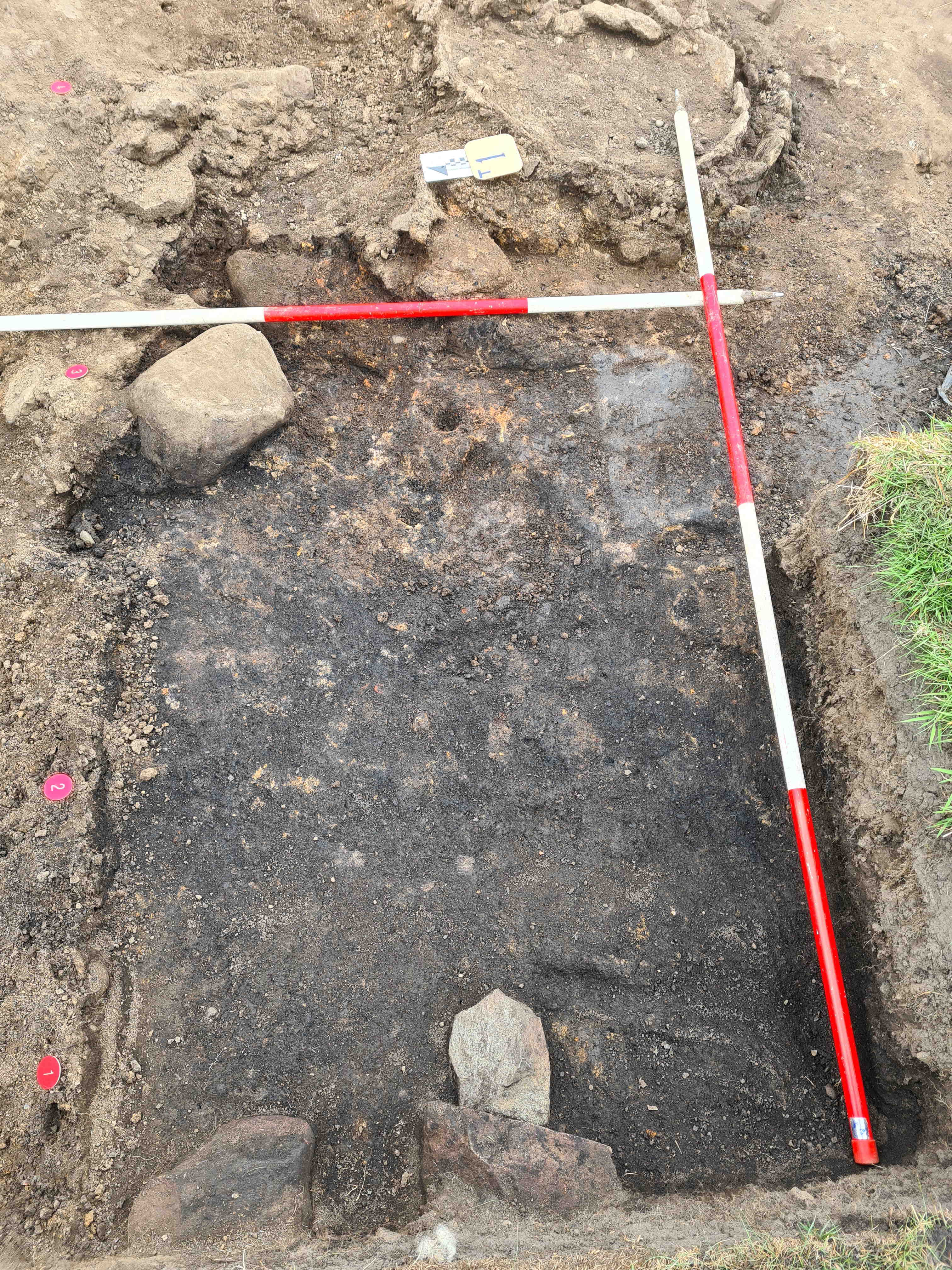
Photo 1

Photo 2
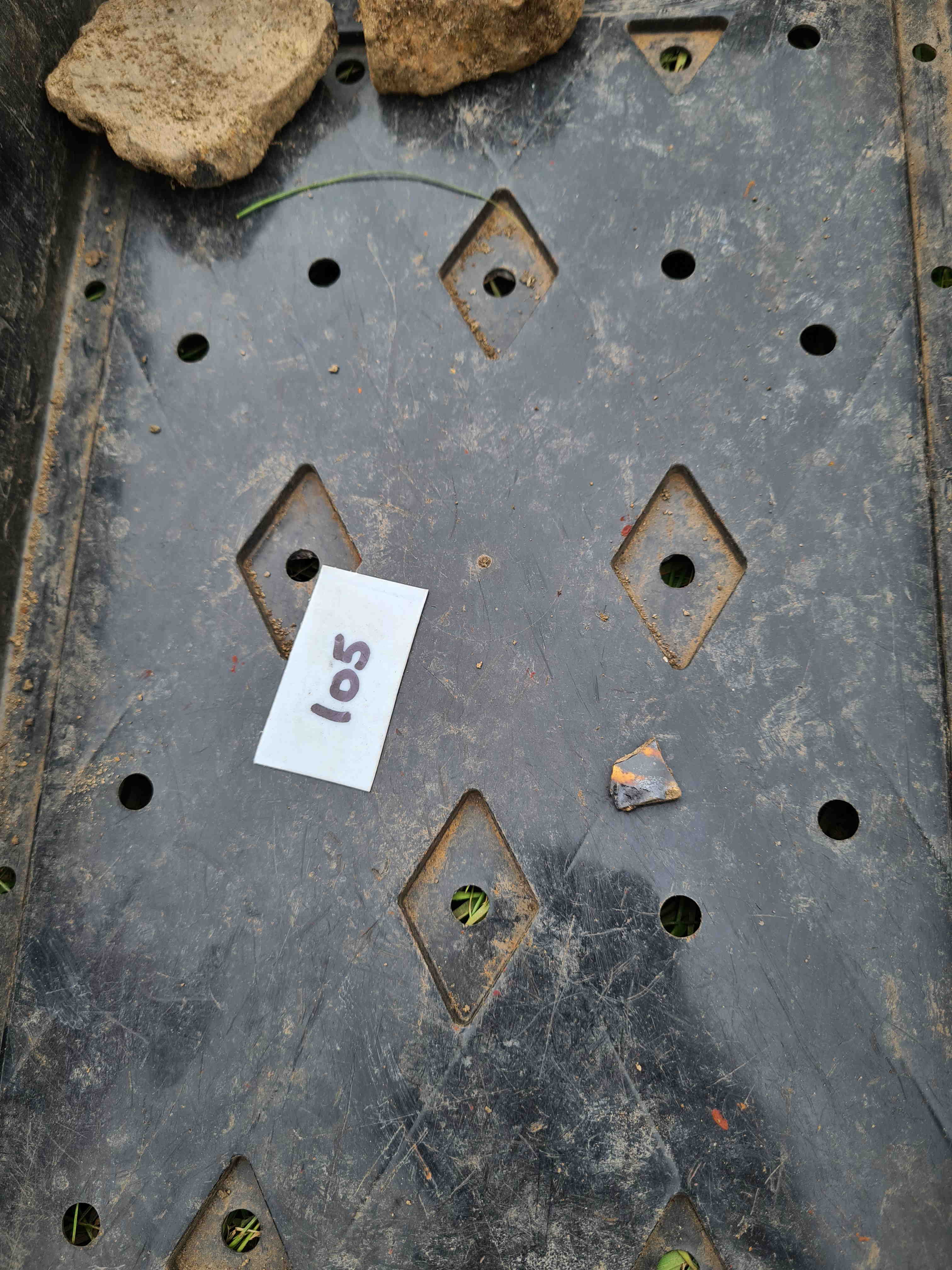
Photo 2a
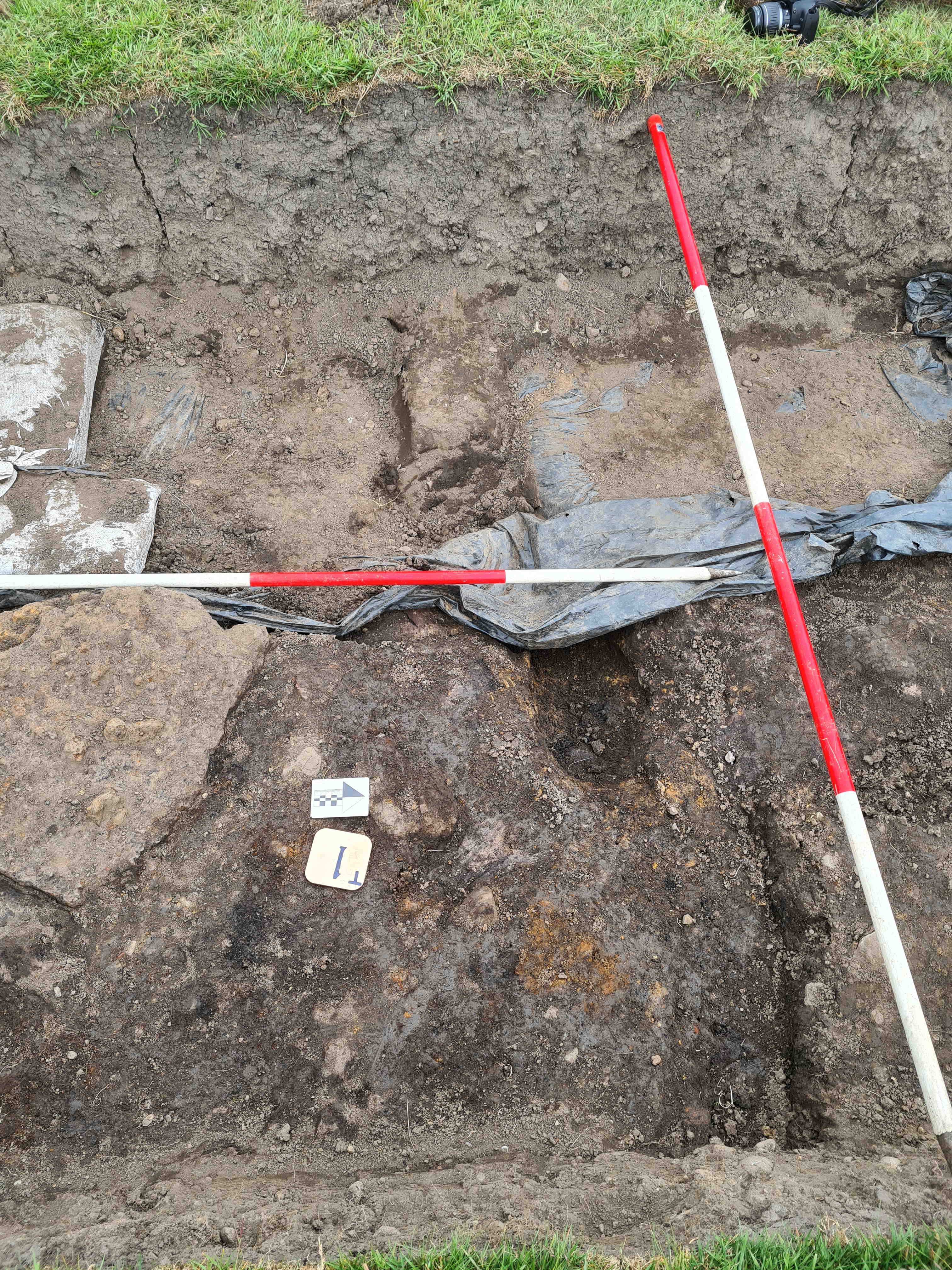
Photo 3
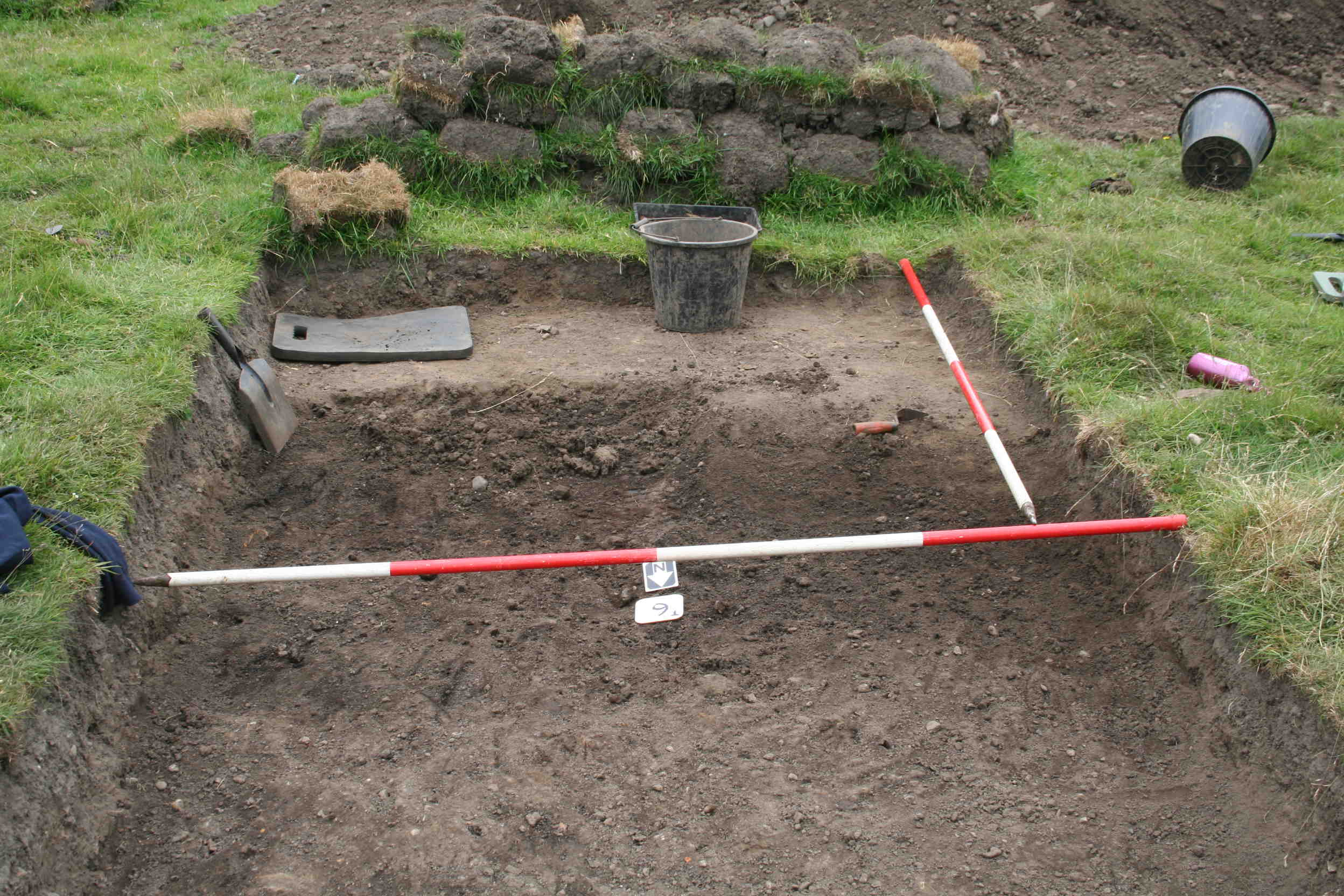
Photo 4
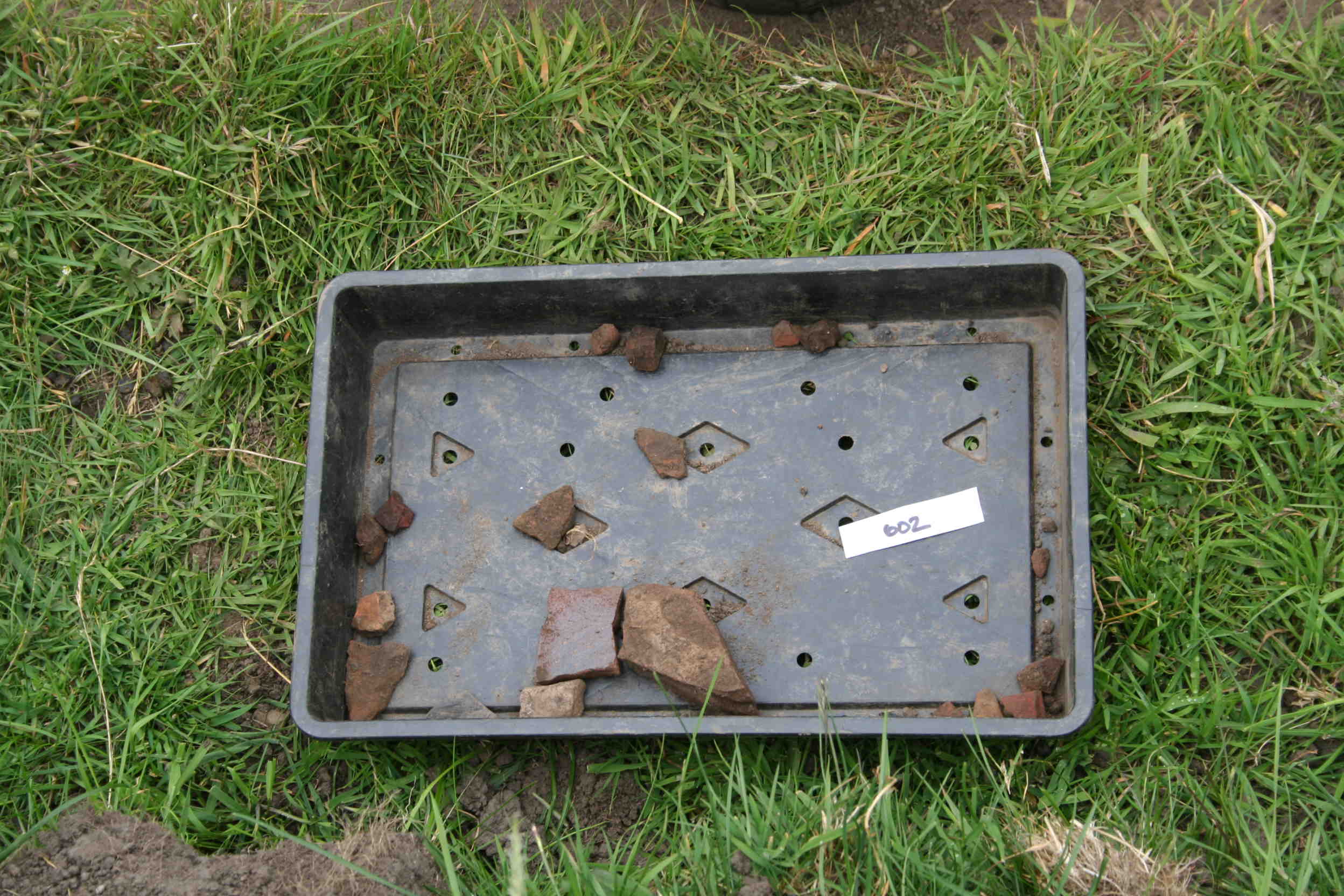
Photo 5
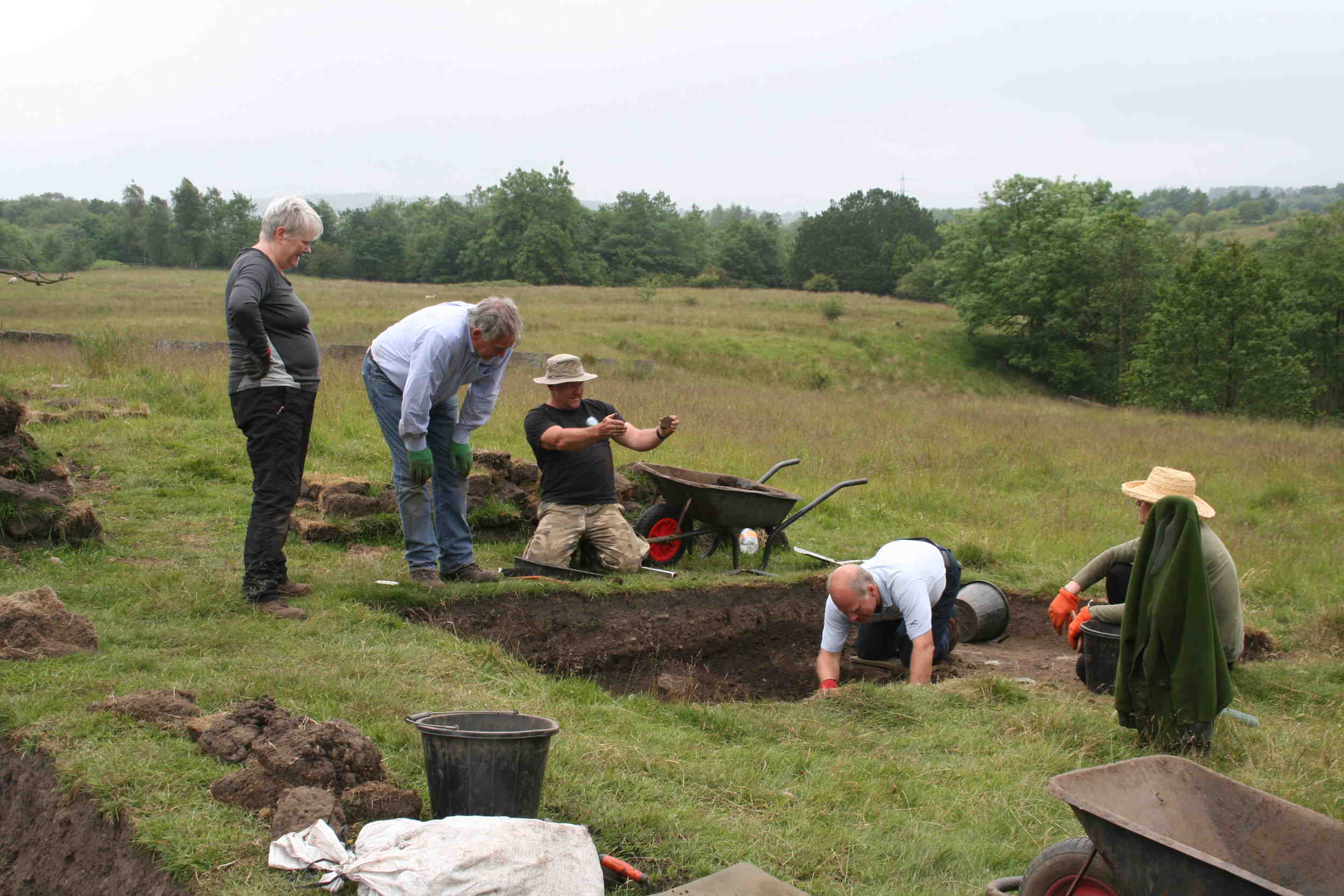
Photo 6
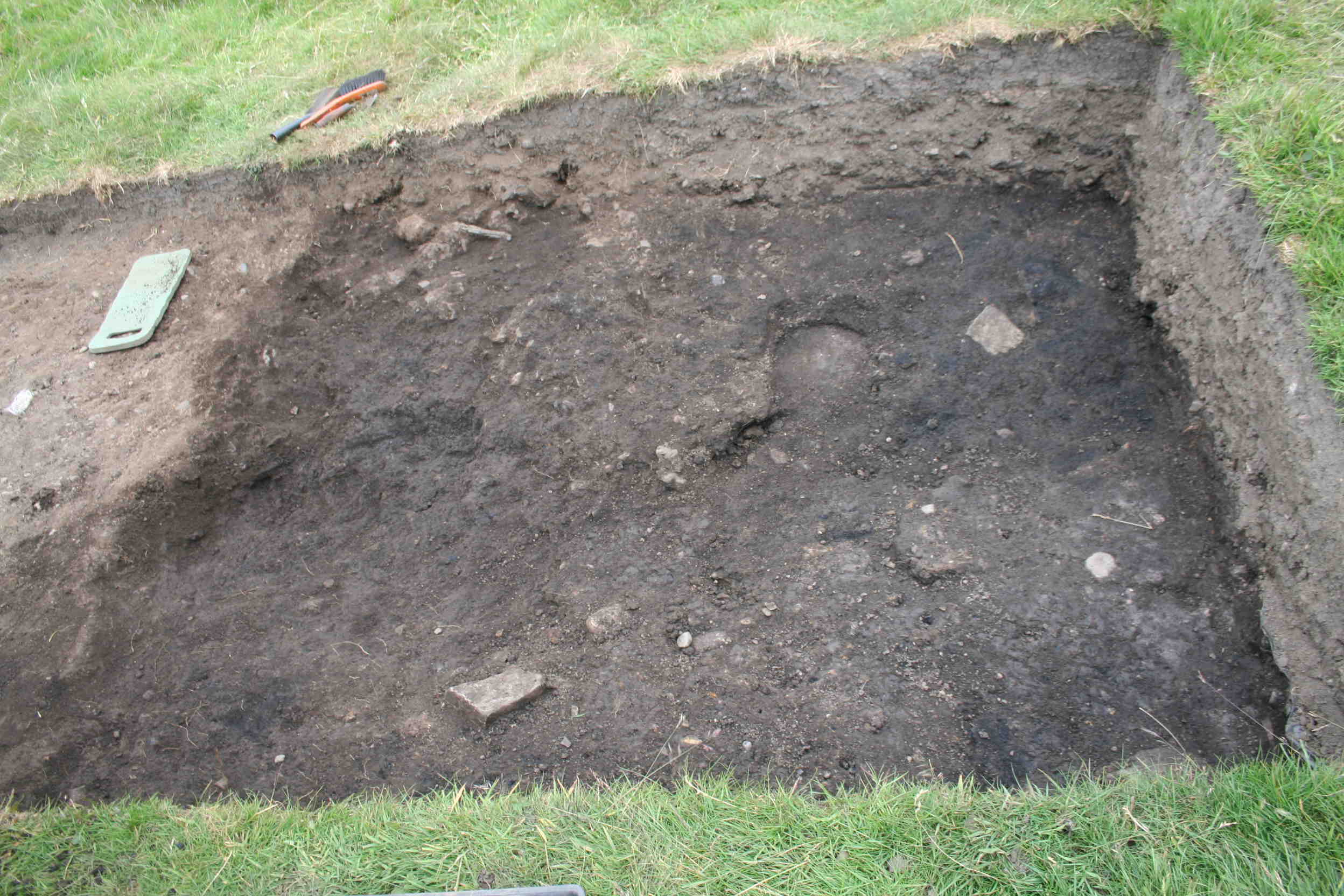
Photo 7
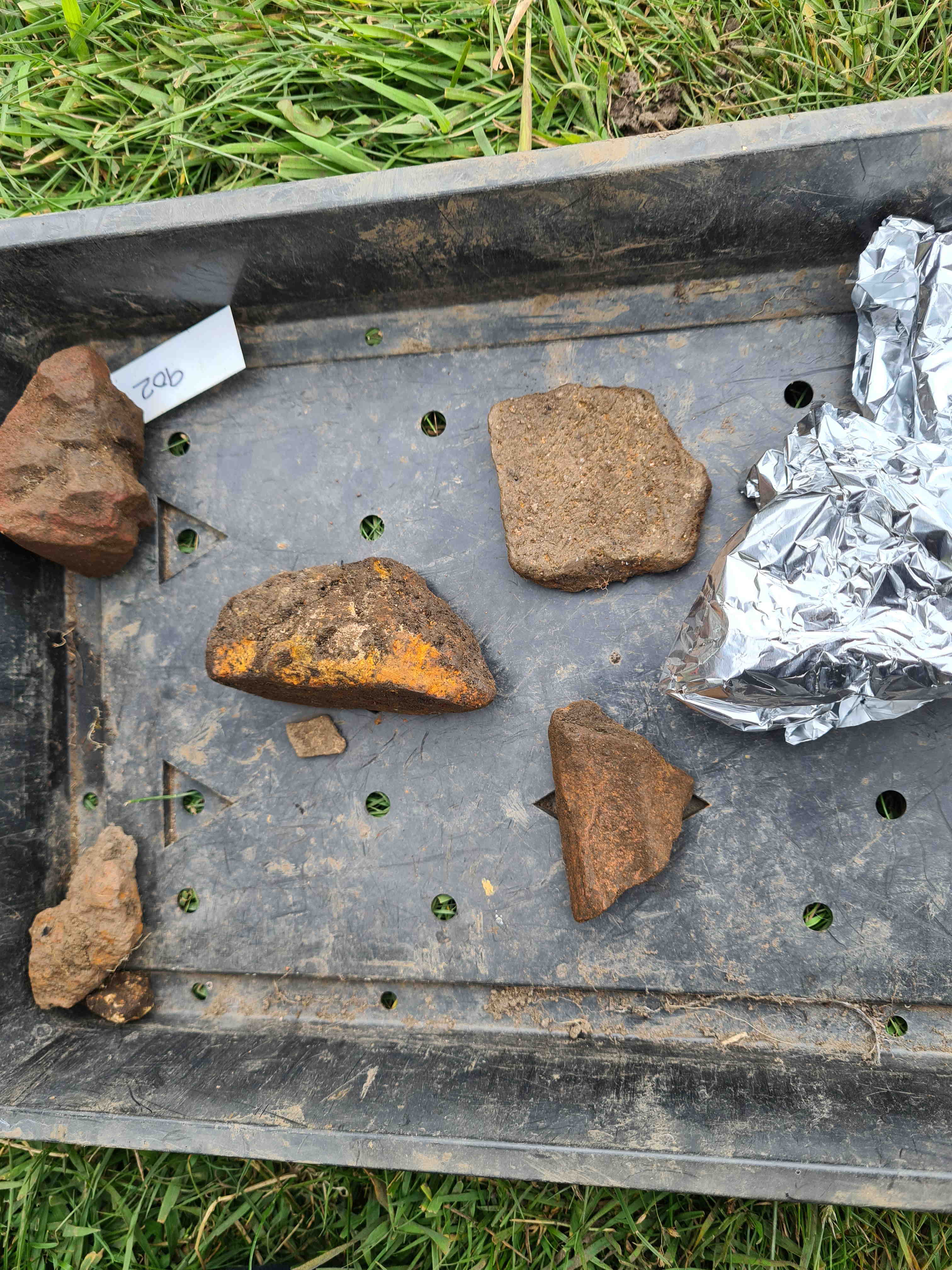
Photo 8
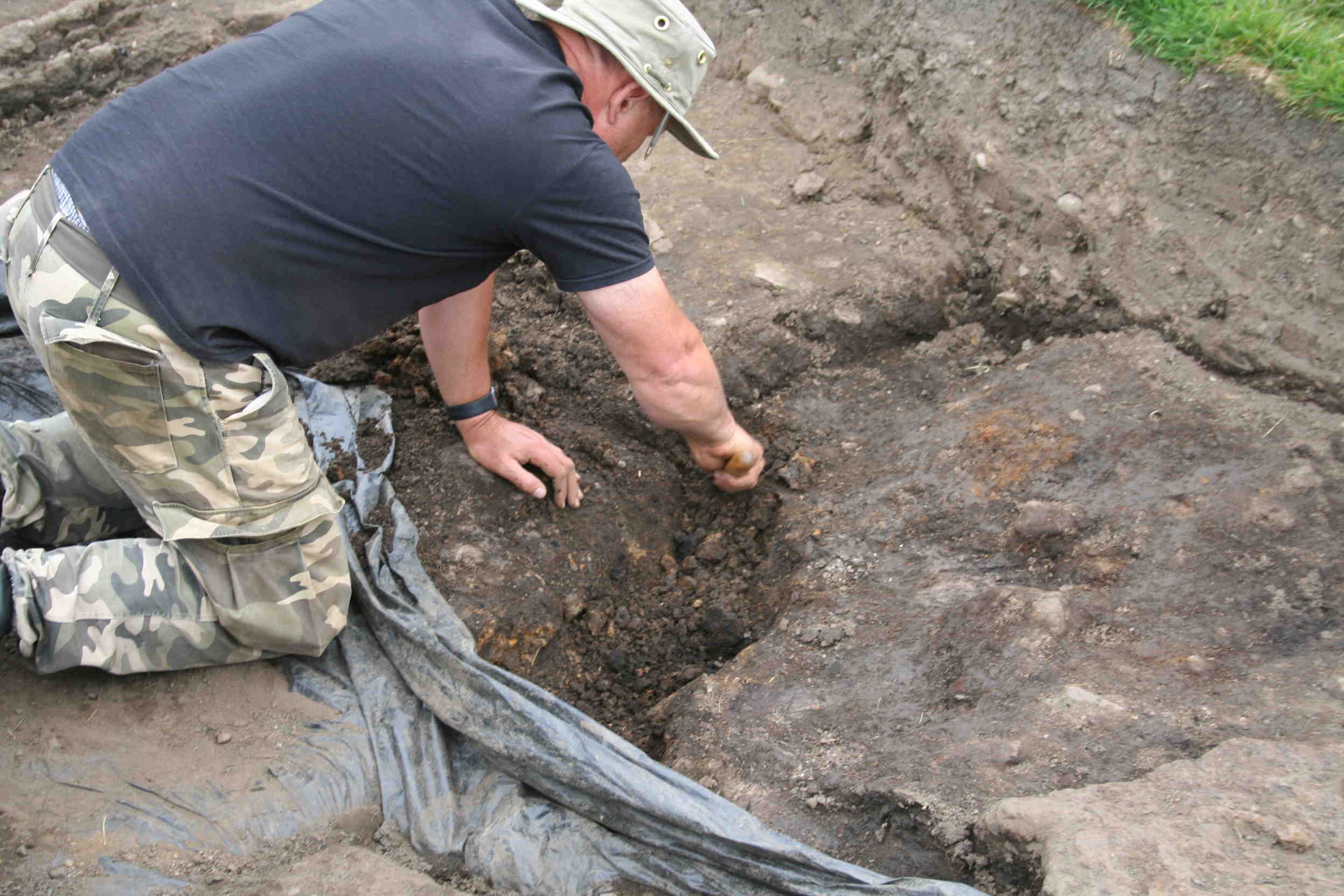
Trench 1 Perplexing negative feature
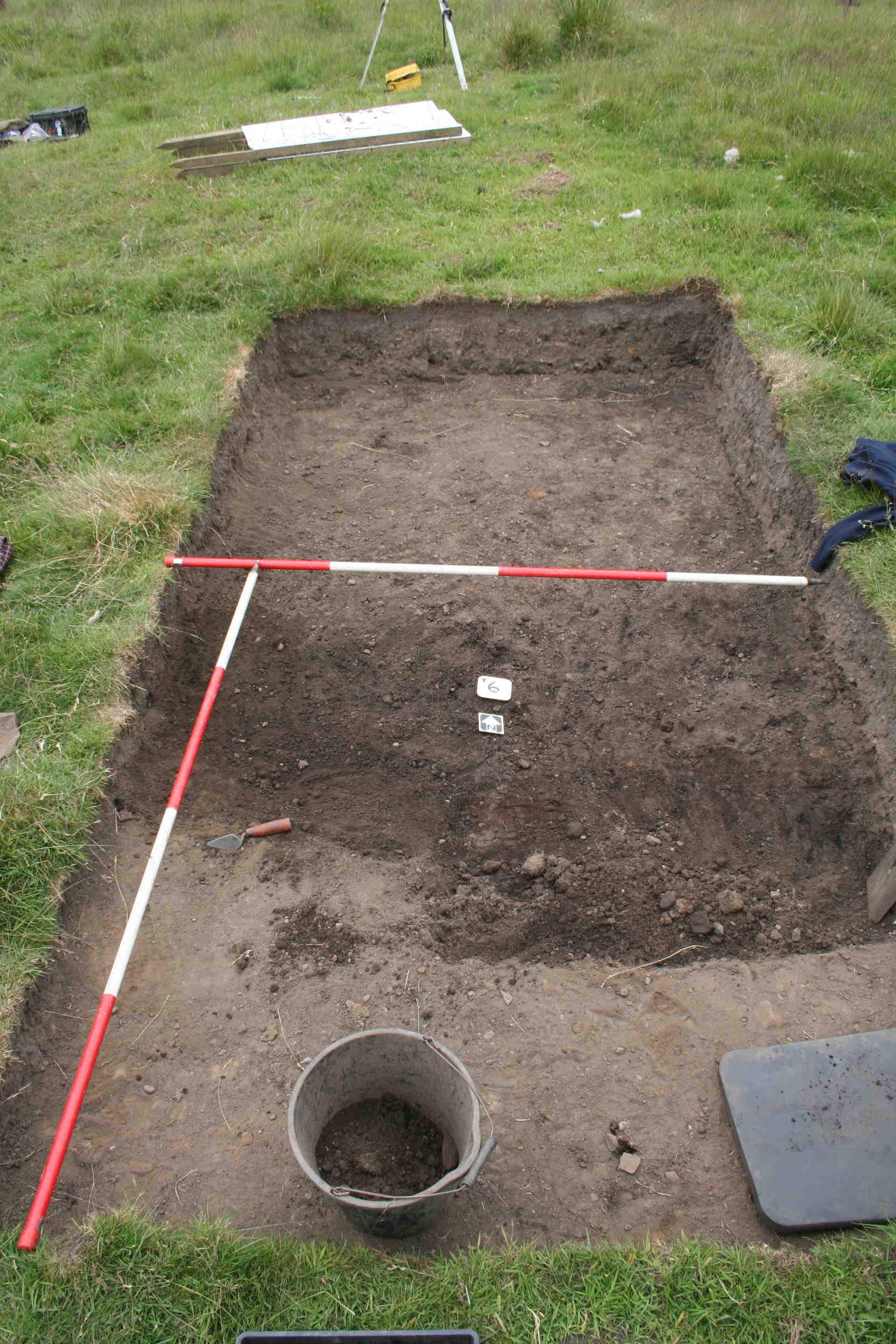
Trench 6
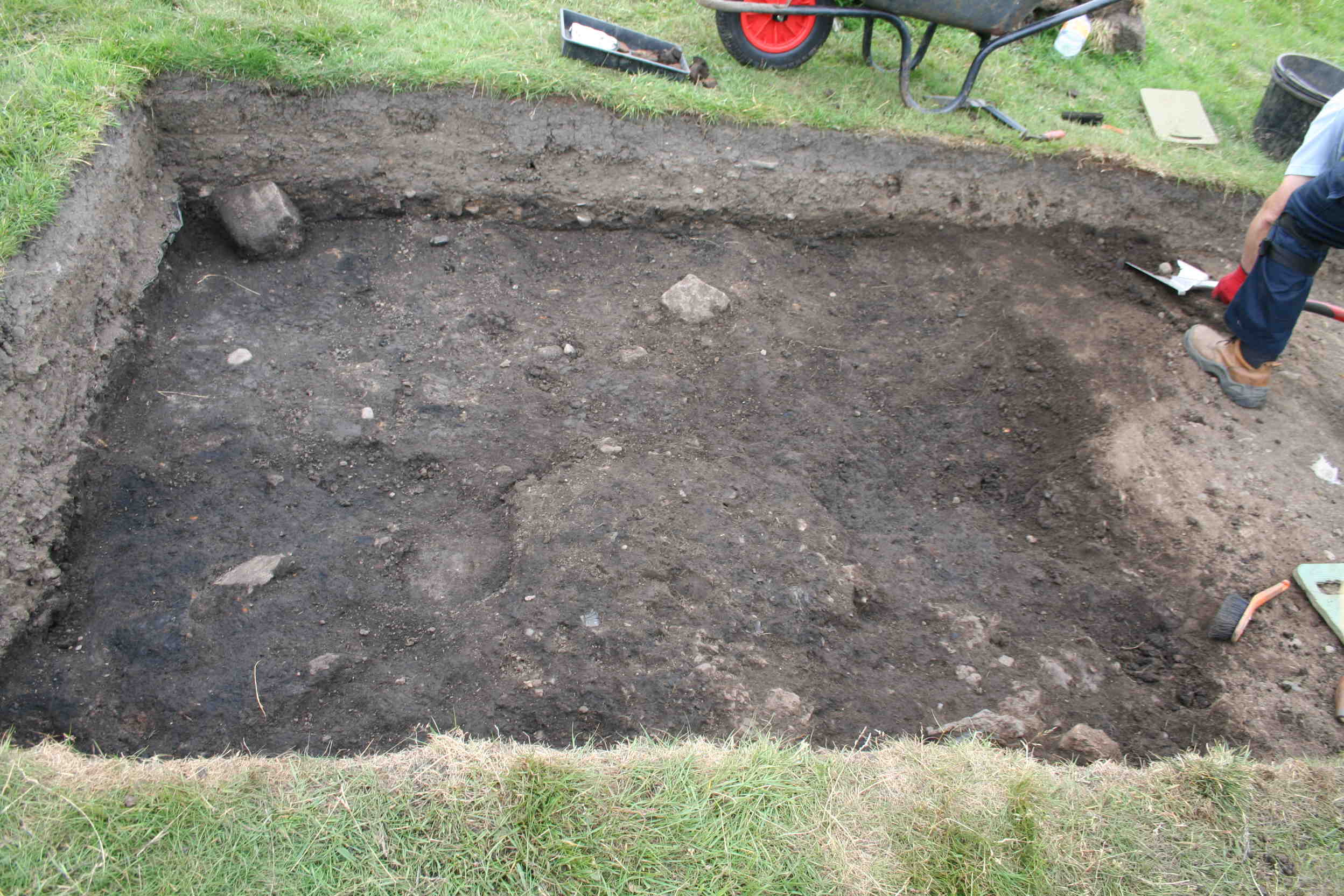
Trench 9
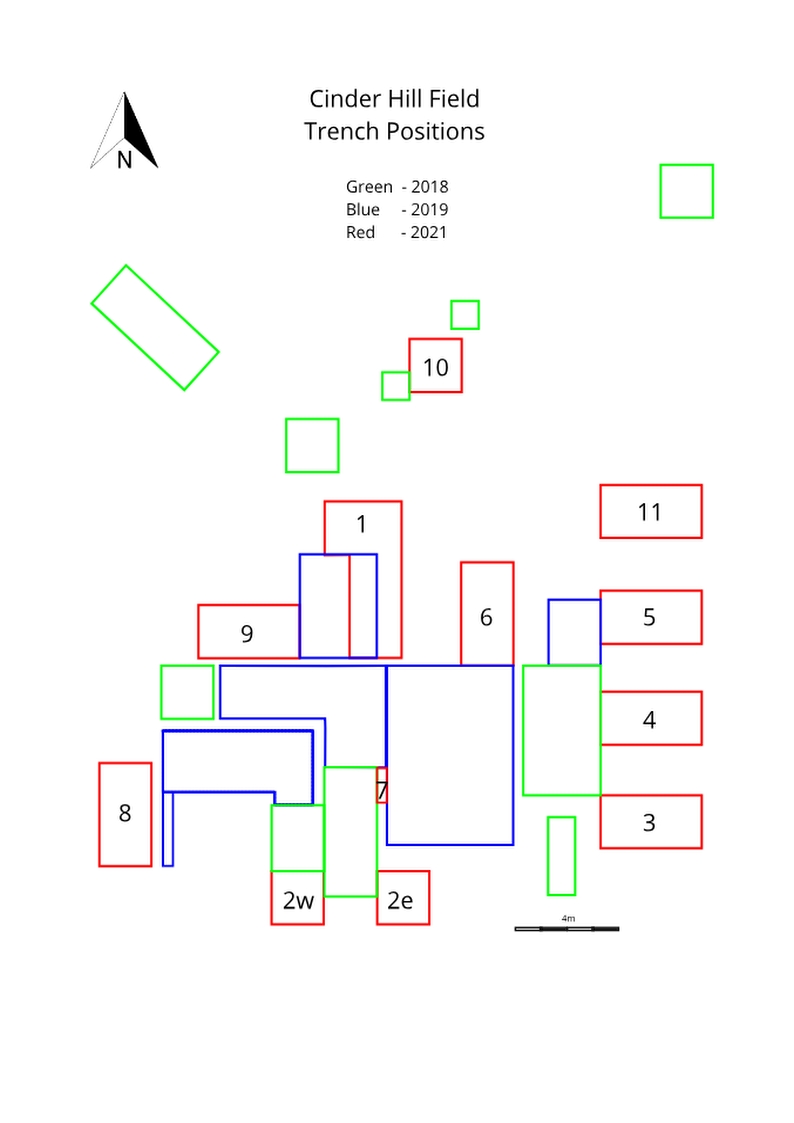
Trench positions 2021
Weather overcast with sunny periods.
Trench 1
Following on from Thursday’s dig, work continued removing the charcoal layer and the large accumulation of slag in the northern end of the trench. Photo 1 shows before condition and photo 2 condition after clearing the charcoal and slag. A small section of what appears to be the tapping channel has been uncovered. This is distinguishable by the reddish coloured deposit against the north wall of the trench in photo 3. This deposit has the same colour and consistency as the material in the tapping channel of bloomery 1, uncovered in 2018. A number of large stones were also uncovered which, although lying flat, are suspected as having been vertical when the bloomery was in operation.
Trench 2 East
Work continued removing the topsoil but, unfortunately, other than the recovery of a few sherds of post medieval pottery nothing of any significance was found. Photo 4. As trenches 2 East and 2 West have produced little evidence of any significant archaeology they may be closed down in the near future.
Trench 4
Steady progress was made during the day. A few pieces of medieval and post medieval pottery sherds were unearthed. Photo 5. Towards the west end of the trench a substantial piece of burnt wood was recovered. Photo 6. This was recovered then sealed in tin foil to preserve it from contamination should any analysis of the wood be undertaken in the future.
There is increasing amounts of slag starting to be uncovered in the west end of the trench which may be associated with the slag layer uncovered in trench 6.
Trench 6
An interesting accumulation of slag was uncovered at the south end of the trench in that there is a fairly straight edge on the northern edge of the slag layer. Photo 7. One can only speculate on why the straight edge was made. Was it placed against an external structure or did if form the flooring of an internal structure, with a levelling layer, such as clay, on top? As there is little evidence of a layer of clay having been on top of the slag, due to a lack of clay in the slag crevices, the latter theory is unlikely. It will be interesting to see how deep this particular layer of slag is.
Trench 9
After further excavation, a distinct difference in contexts is coming to light. The northern half of the trench has an accumulation of slag in it, while the southern half consists mainly of soil and stones. Photo 8. Unfortunately, little in the way of pottery sherds were recovered although a couple of pieces of charcoal were found and protected in tin foil for any future dating.
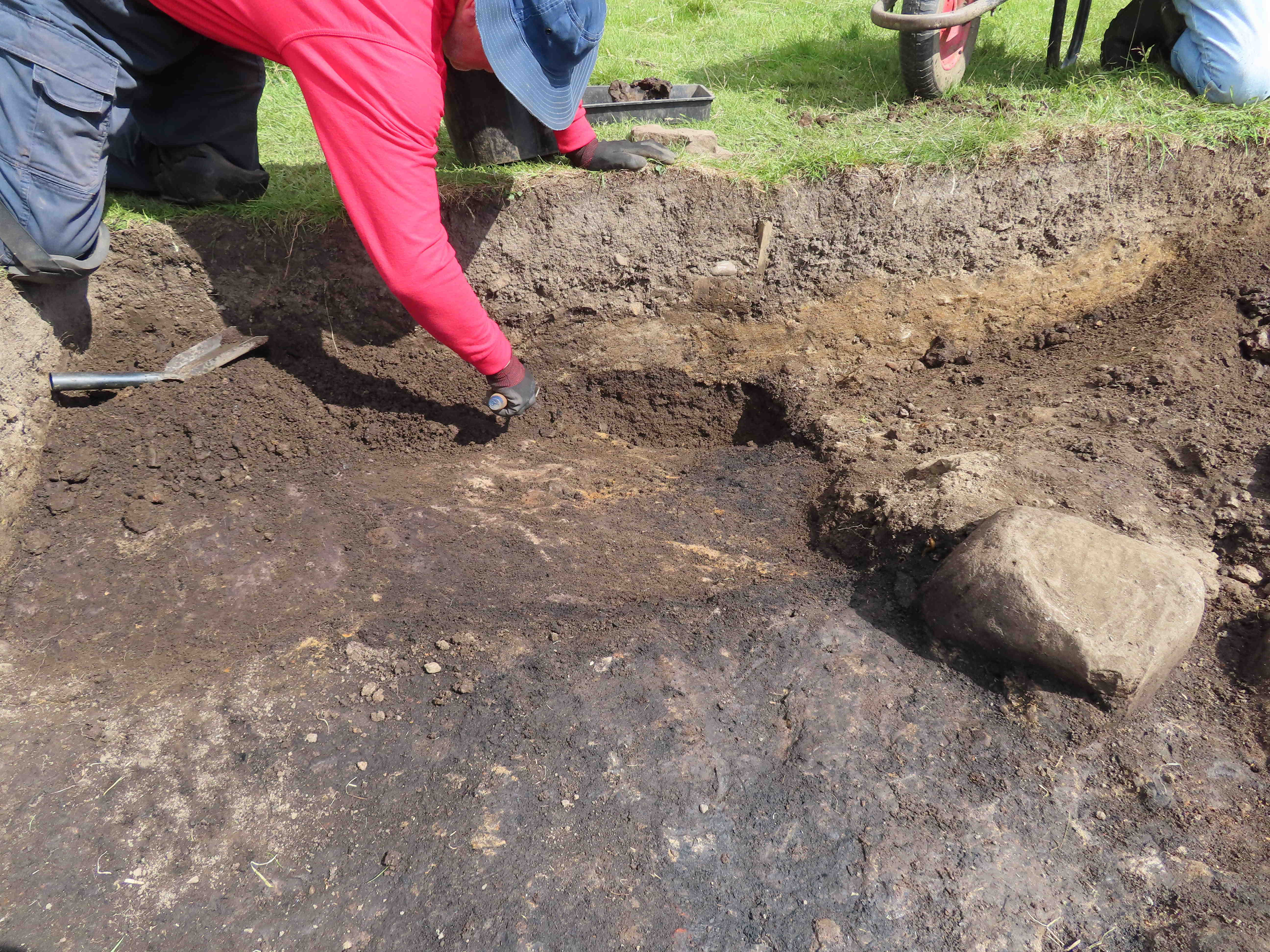
Photo 1
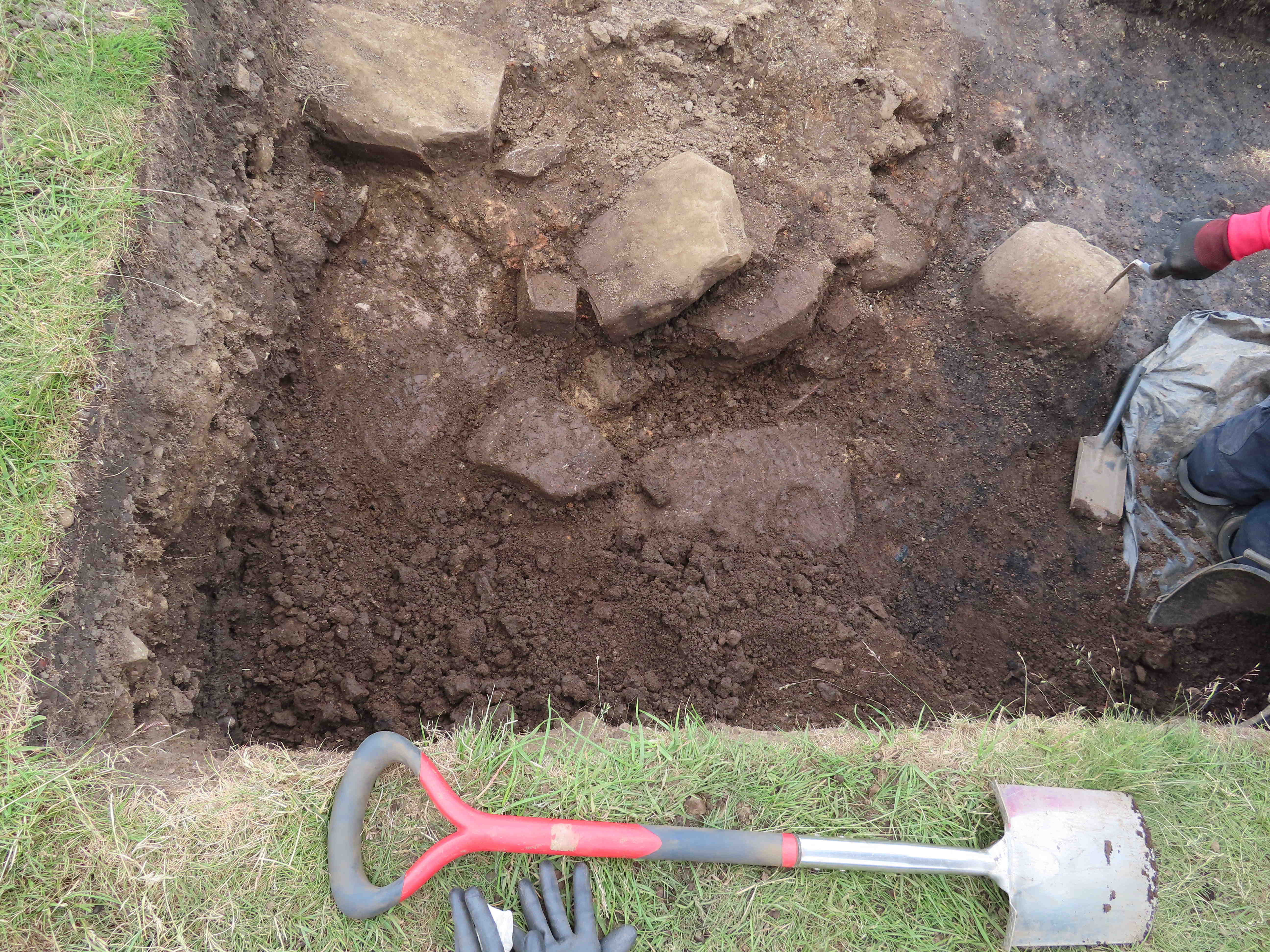
Photo 2

Photo 3
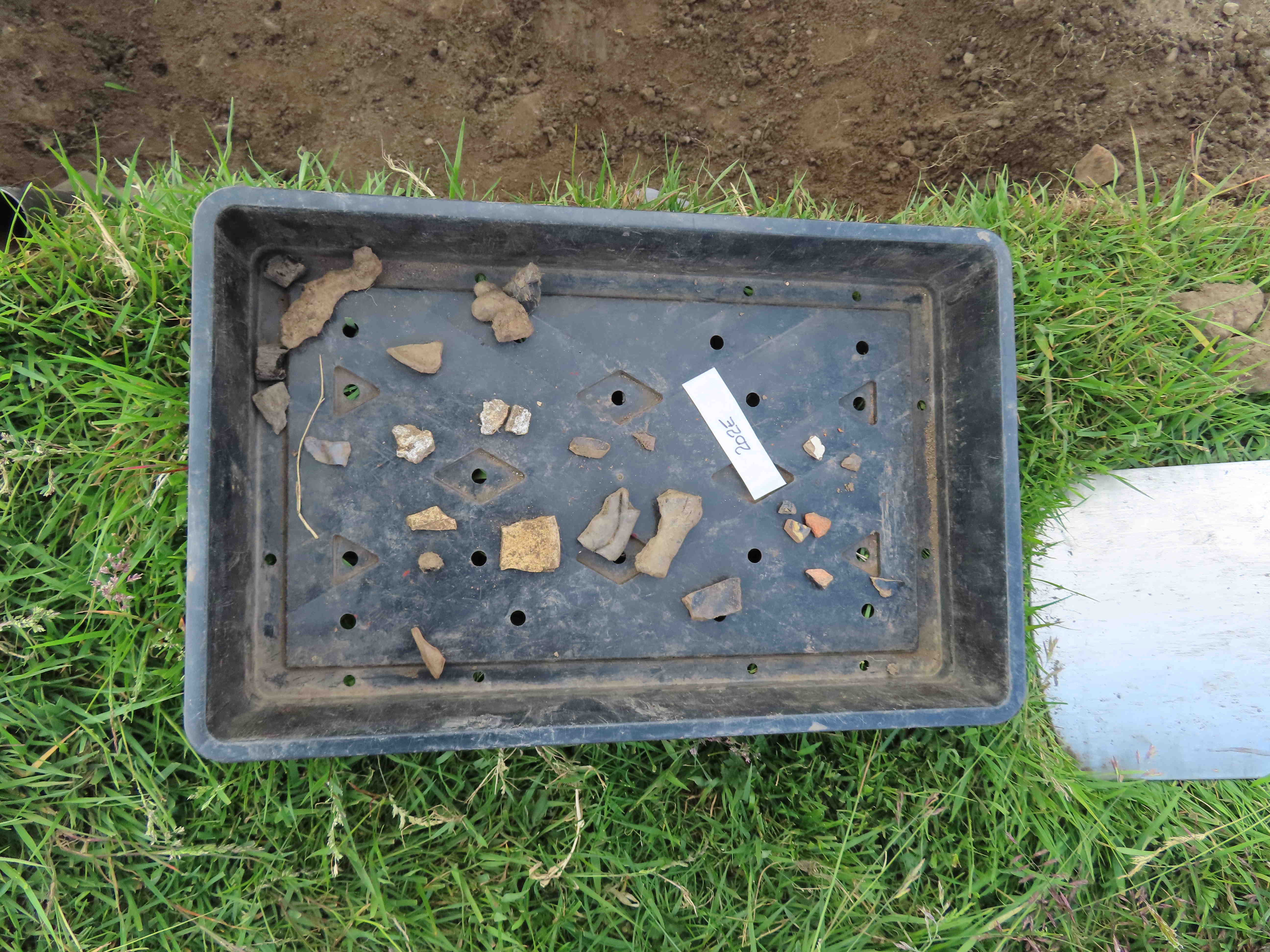
Photo 4
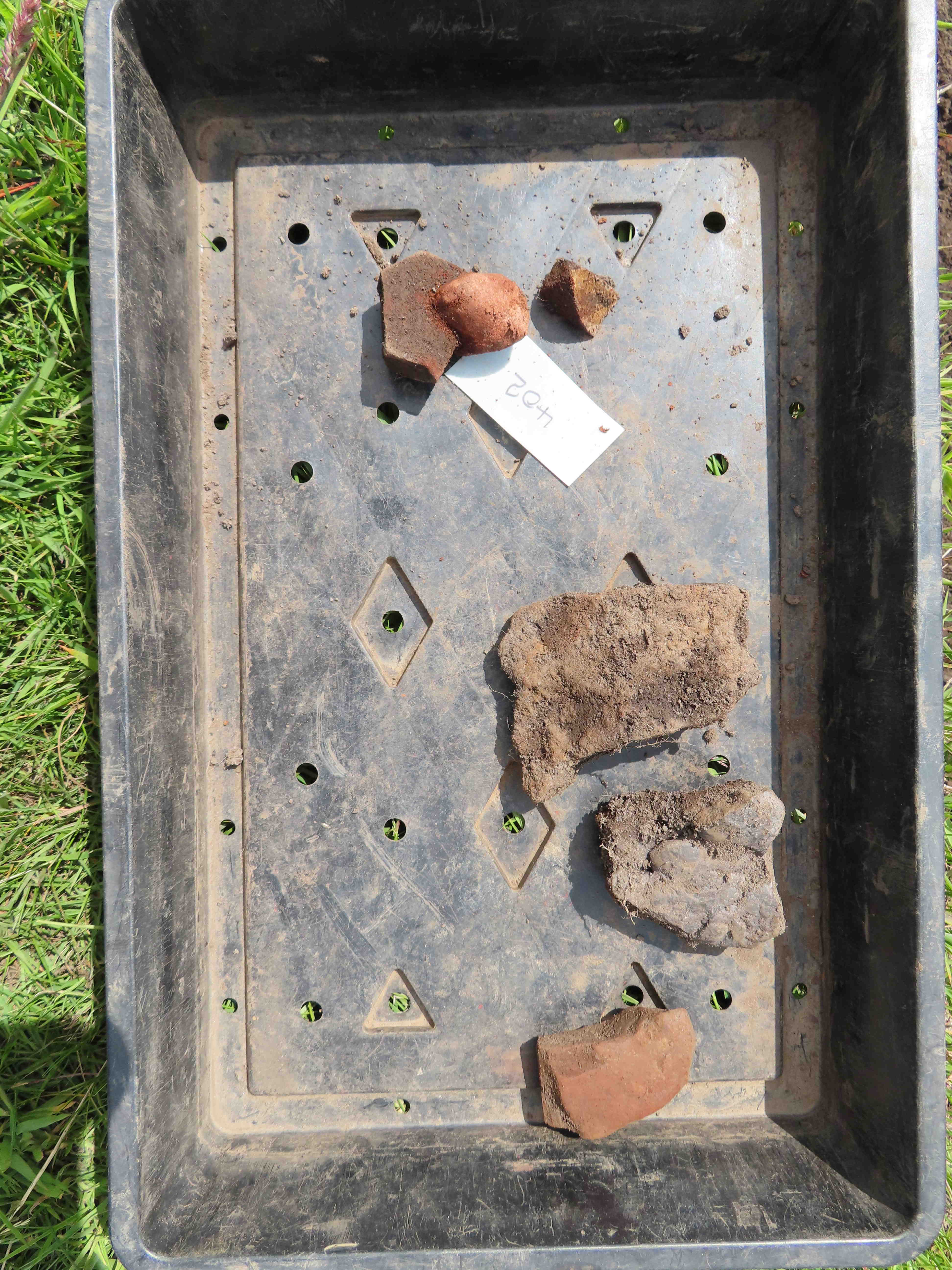
Photo 5
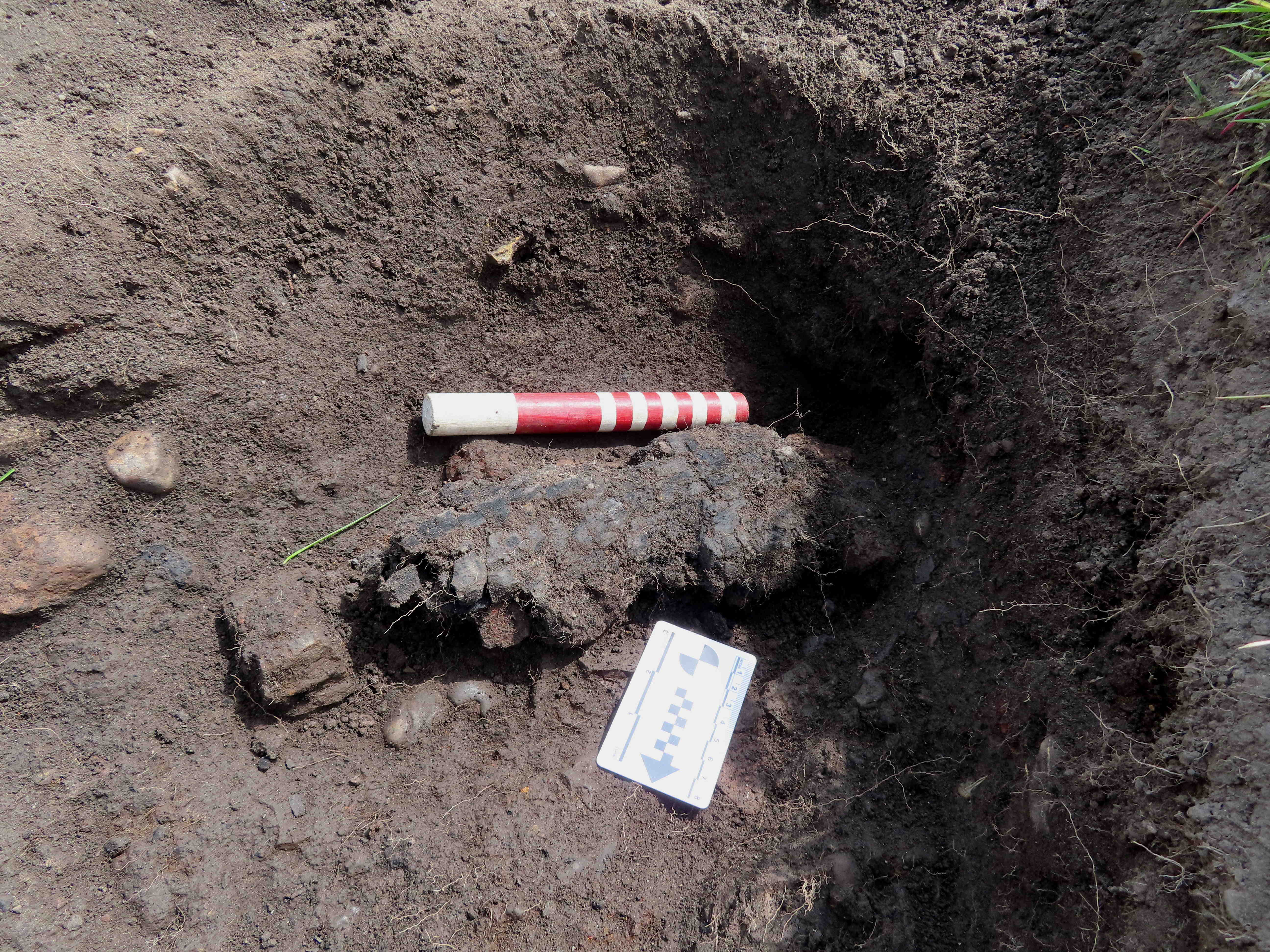
Photo 6
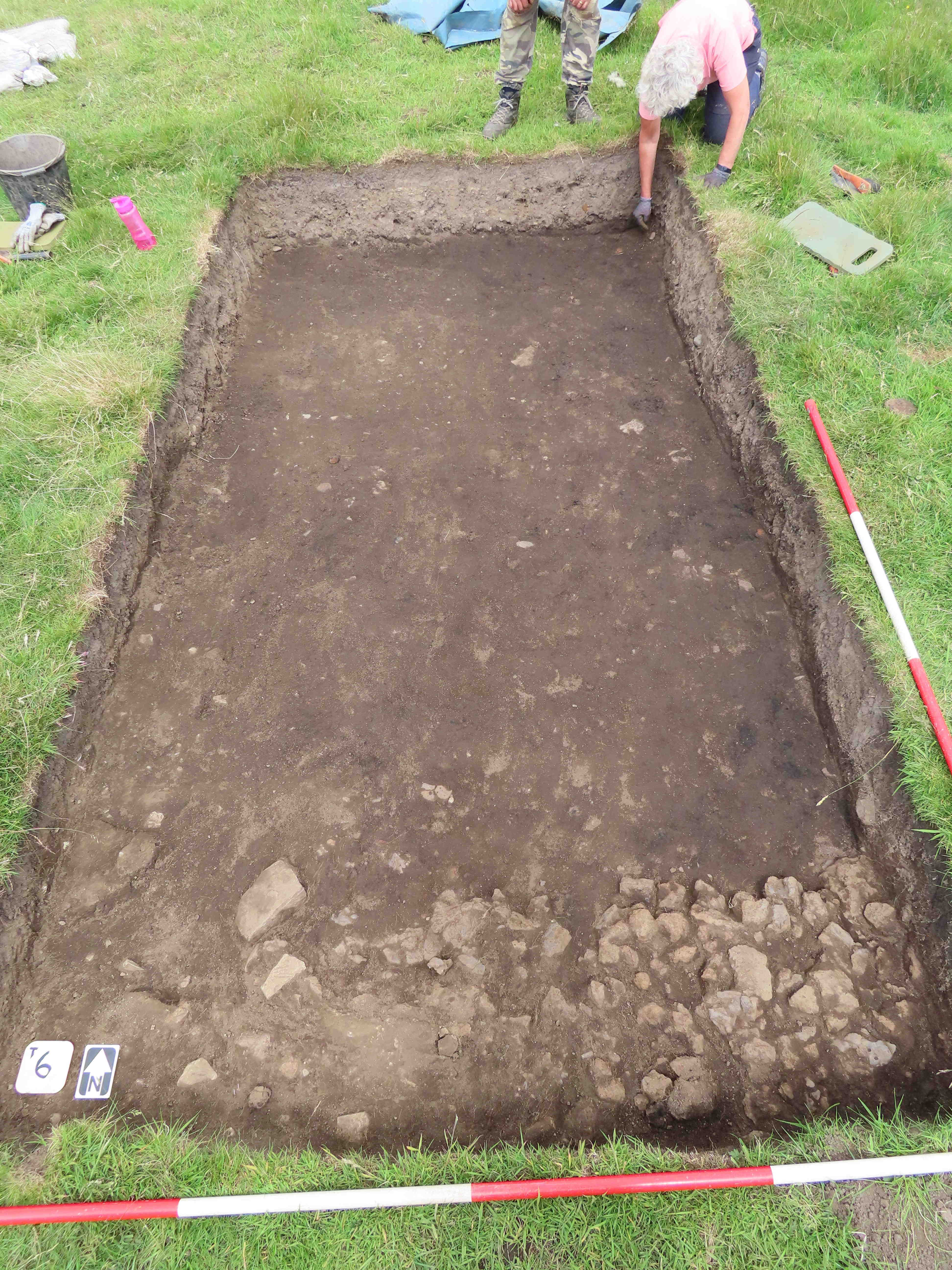
Photo 7
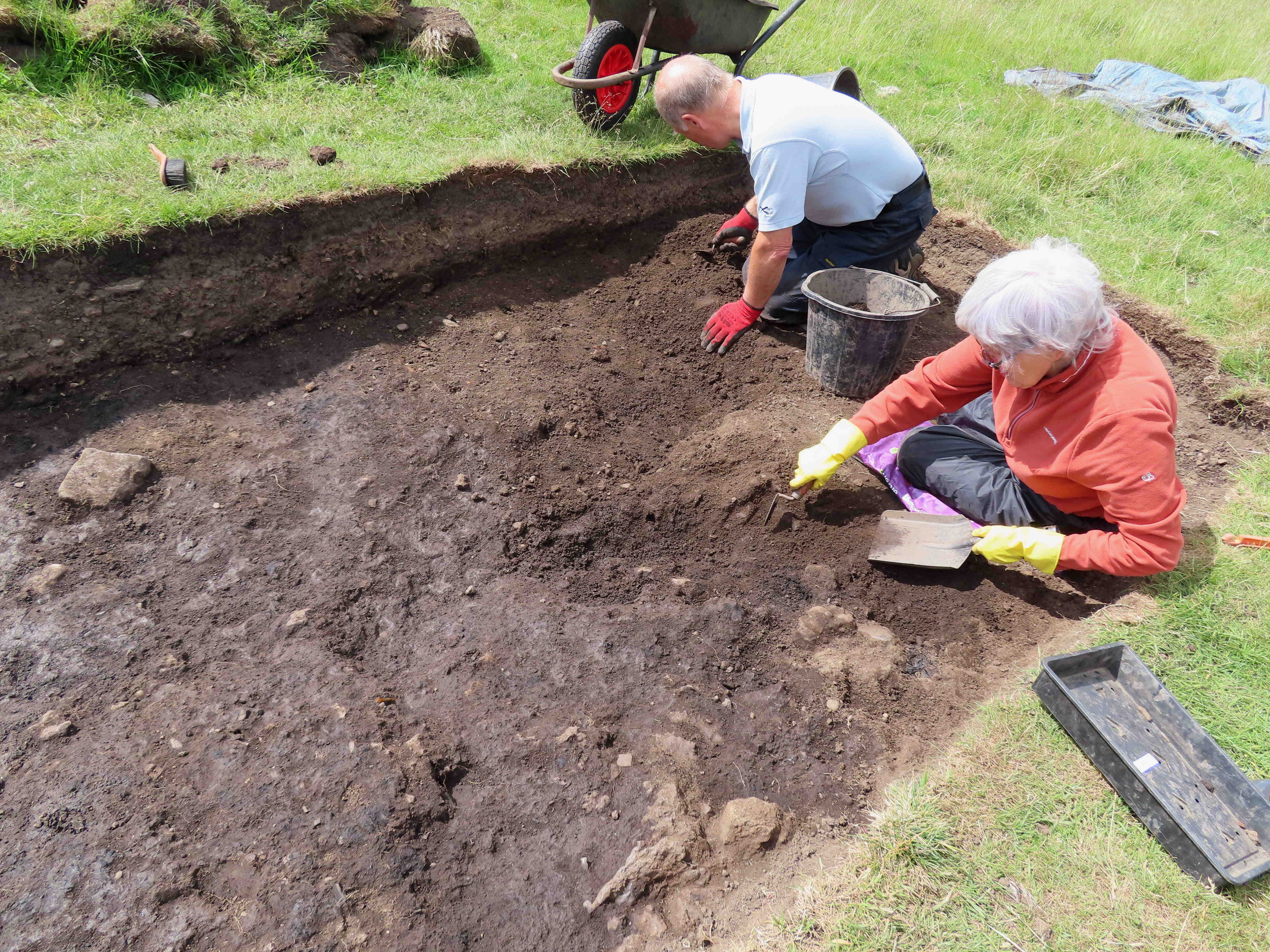
Photo 8
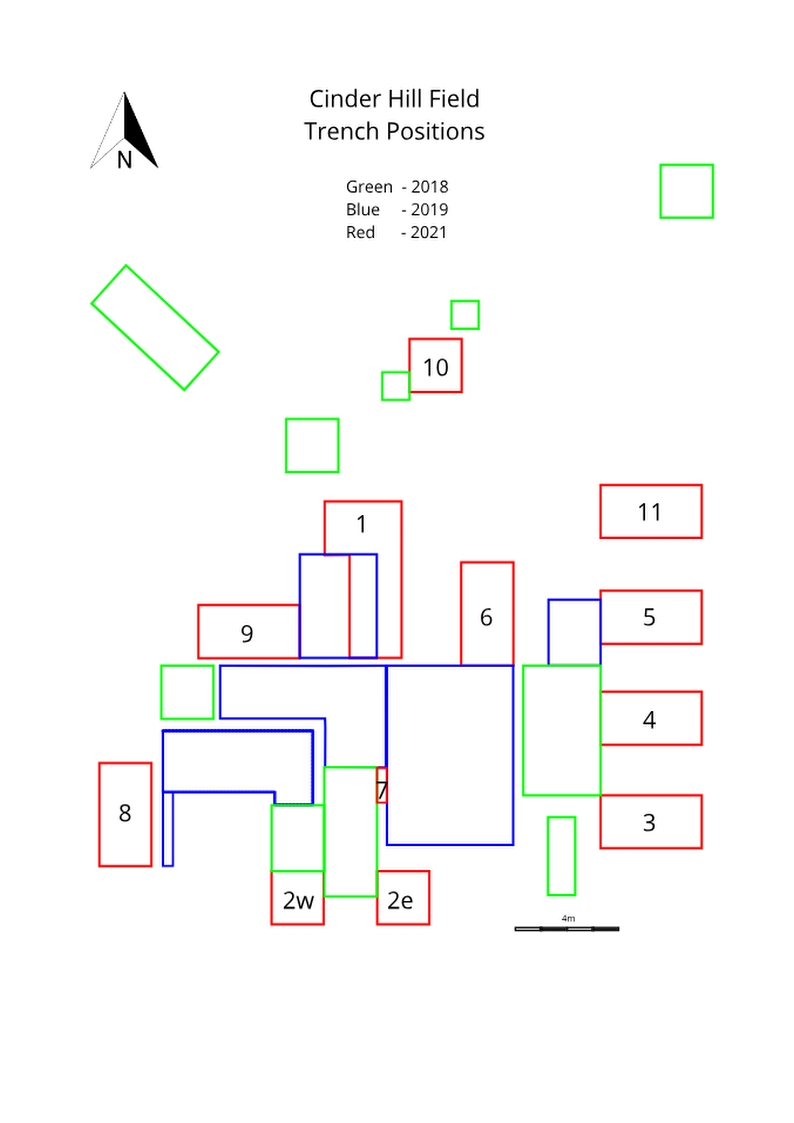
Trench Positions 2021
Weather very hot, unfortunately no rain.
Trench 1
Examination of the various large stones on the northern side of the furnace confirmed that most of these were sitting on backfill and did not form part of the original structure. These were subsequently removed.
The decision was then taken to remove the existing charcoal layer which would appear to overlay the tapping channel, a small section of which was excavated on Saturday 26th June. The charcoal layer proved to be a lot deeper than expected, Photo 1, and became very moist towards the bottom of the layer. Photo 2. What was eventually exposed was the tapping pit and not a continuation of the tapping channel as originally expected. Photos 3 & 4. The furnace uncovered in 2018 had a longer tapping channel and a larger tapping pit, so the dimensions of the latest channel and pit were unexpected. At the moment it is not possible to date relate the two furnaces; hopefully charcoal will be found in the base of this furnace which will provide suitable dating material.
(The tapping channel of a furnace allows the molten slag in the bottom of the furnace to be drained off into a bowl shaped depression at the end of the channel called the tapping pit. Once the slag cools and solidifies it can be removed and disposed of, as it is waste material. The melted iron forms a bloom which is left in the furnace after the slag is tapped off. The iron bloom is then removed and further processed to remove impurities.)
Trench 4
Work progressed on the western end of the trench, but unfortunately as the ground is so dry it is proving very difficult to process. There are faint hints, however, around the area where the large piece of charcoal was located earlier, that there may be some interesting archaeology still to be discovered, which may form a continuation from the 2018 trench 2, which this trench butts up against. Photo 5
Trench 5
Like trench 4 the ground is very hard and difficult to work. When the covers were first removed there were a number of darkened patches, particularly at the western end of the trench. Photos 6. There has been some speculation in the past that these areas could be post holes, however the shapes and sizes of the patches has thrown some doubt on these theories. Work will progress on the trench when available personnel and time permits.
Trench 6
A section of top soil on the northern end of the trench was removed to confirm natural ground had been reached and no further archaeology would exist any further down. As the underlying surface was confirmed as being natural, no further work will be carried out in this section of the trench. Photo 7.
The southern section of the trench was extended eastwards by 1.5 metres to confirm that the overlying section of slag, which was uncovered on Saturday 16th June, continues through the trench. Although not all the topsoil was removed, it is evident that the slag layer does continue to the east, possibly into the 2019 trench 4. Work will continue on this extension to the main trench during the next dig. Photo 8.

Photo 1
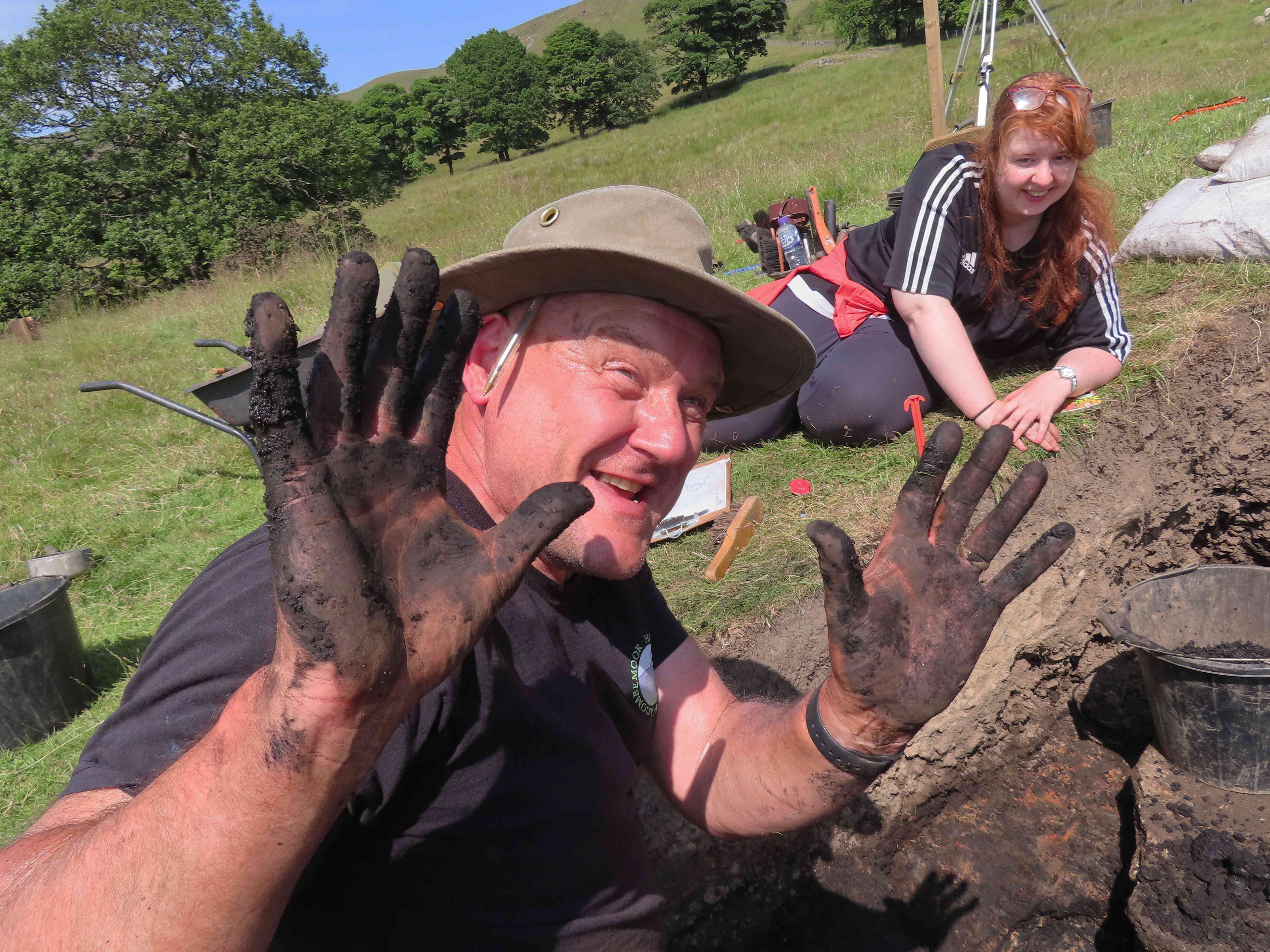
Photo 2
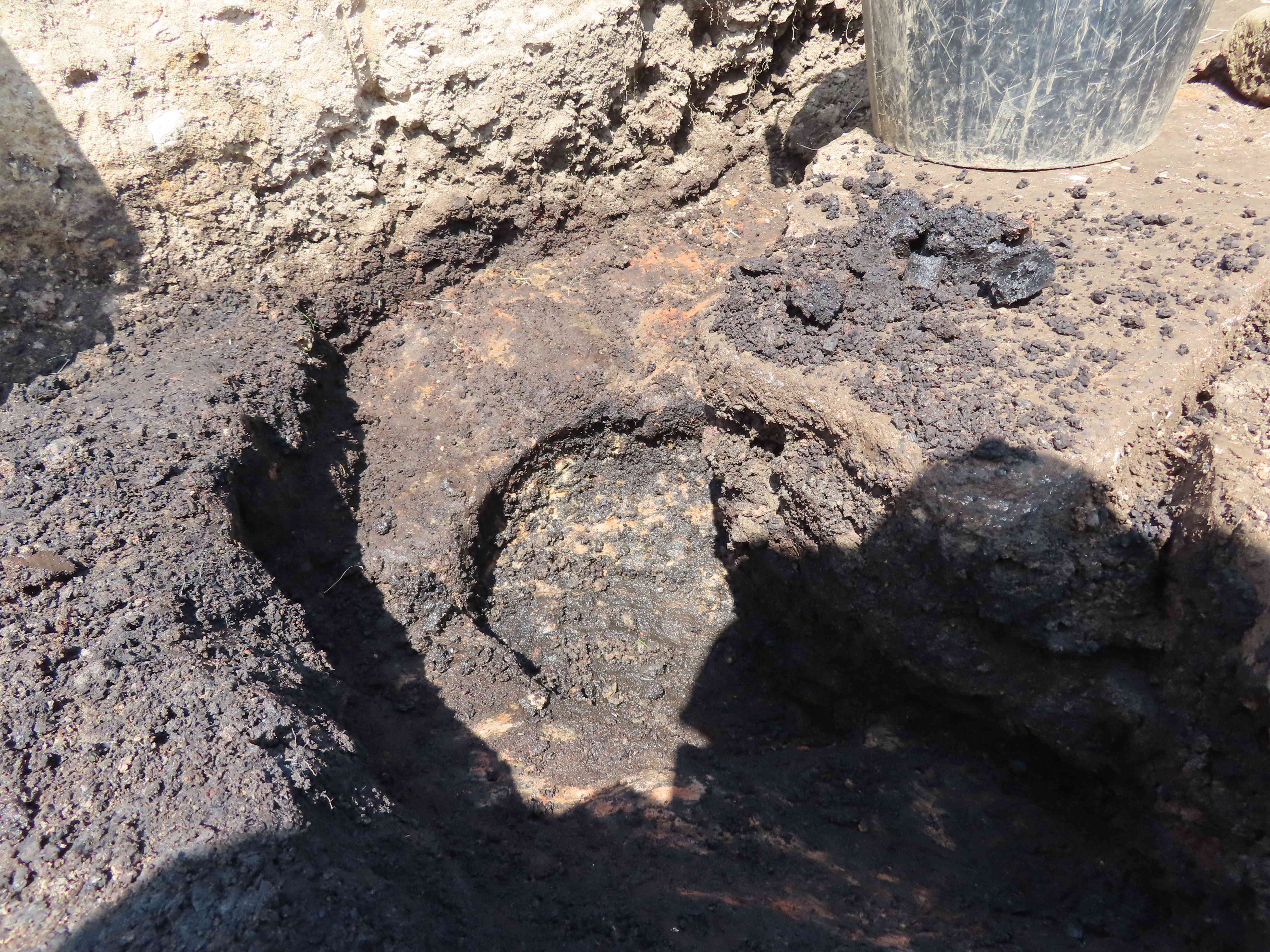
Photo 3

Photo 4
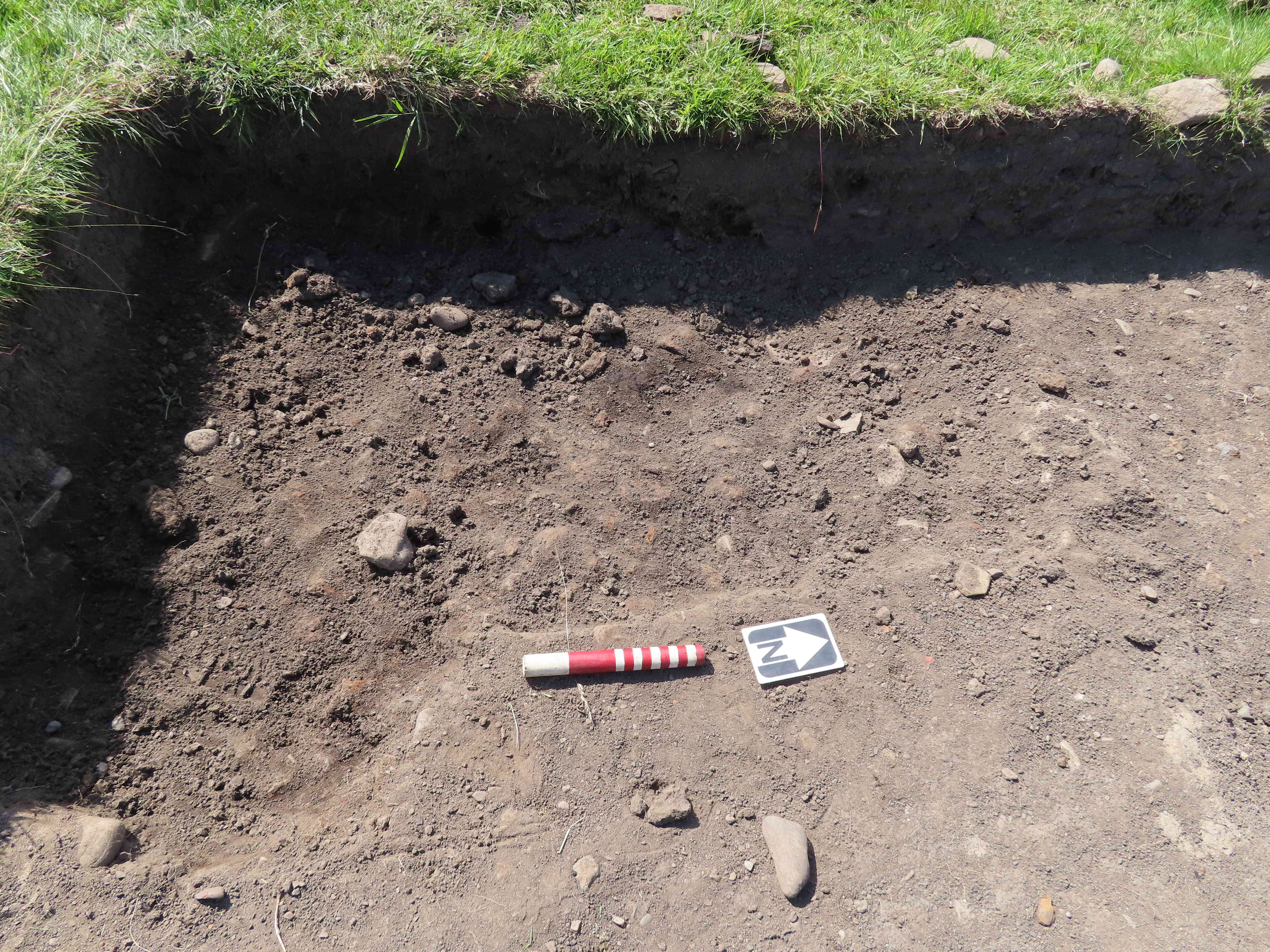
Photo 5
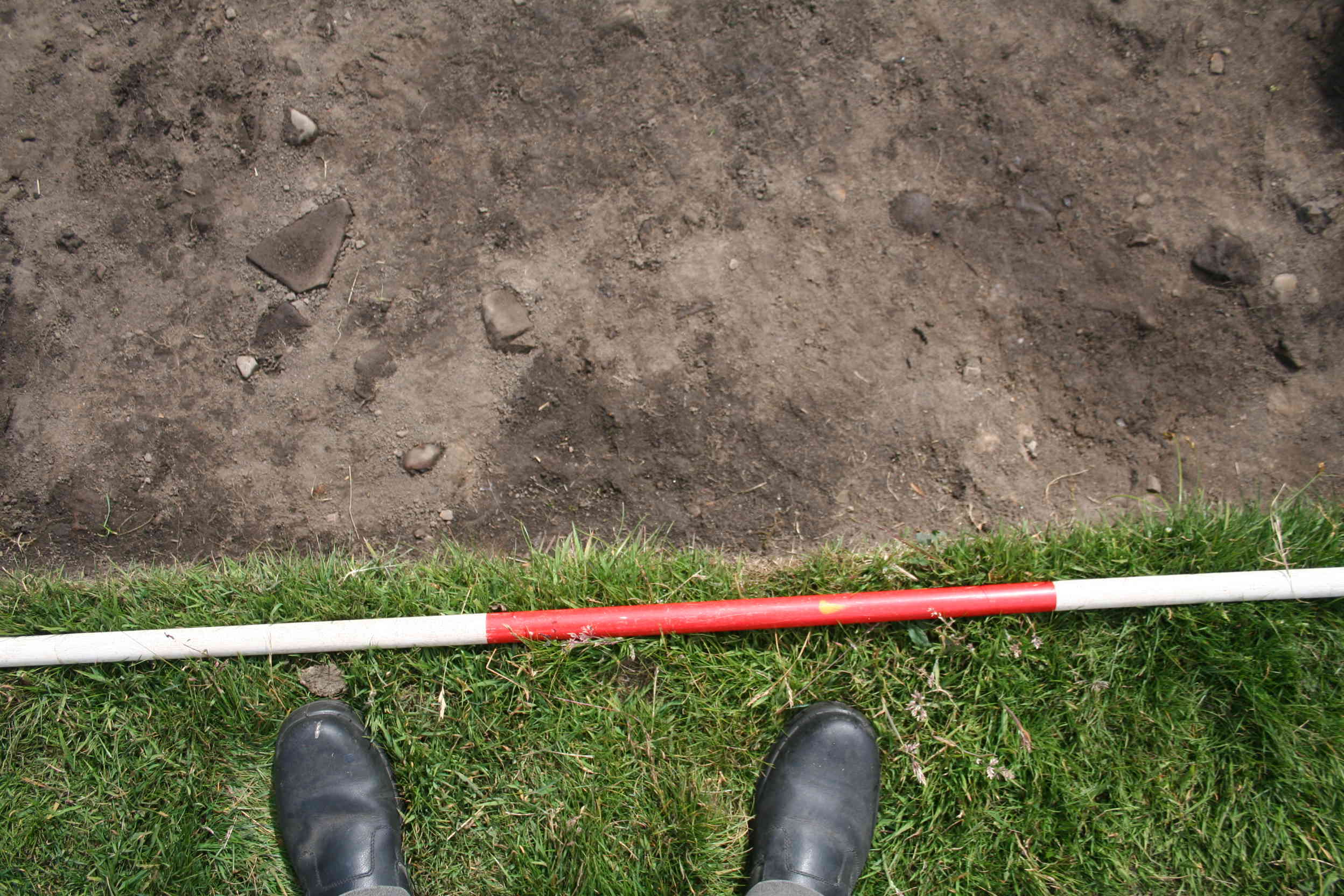
Photo 6
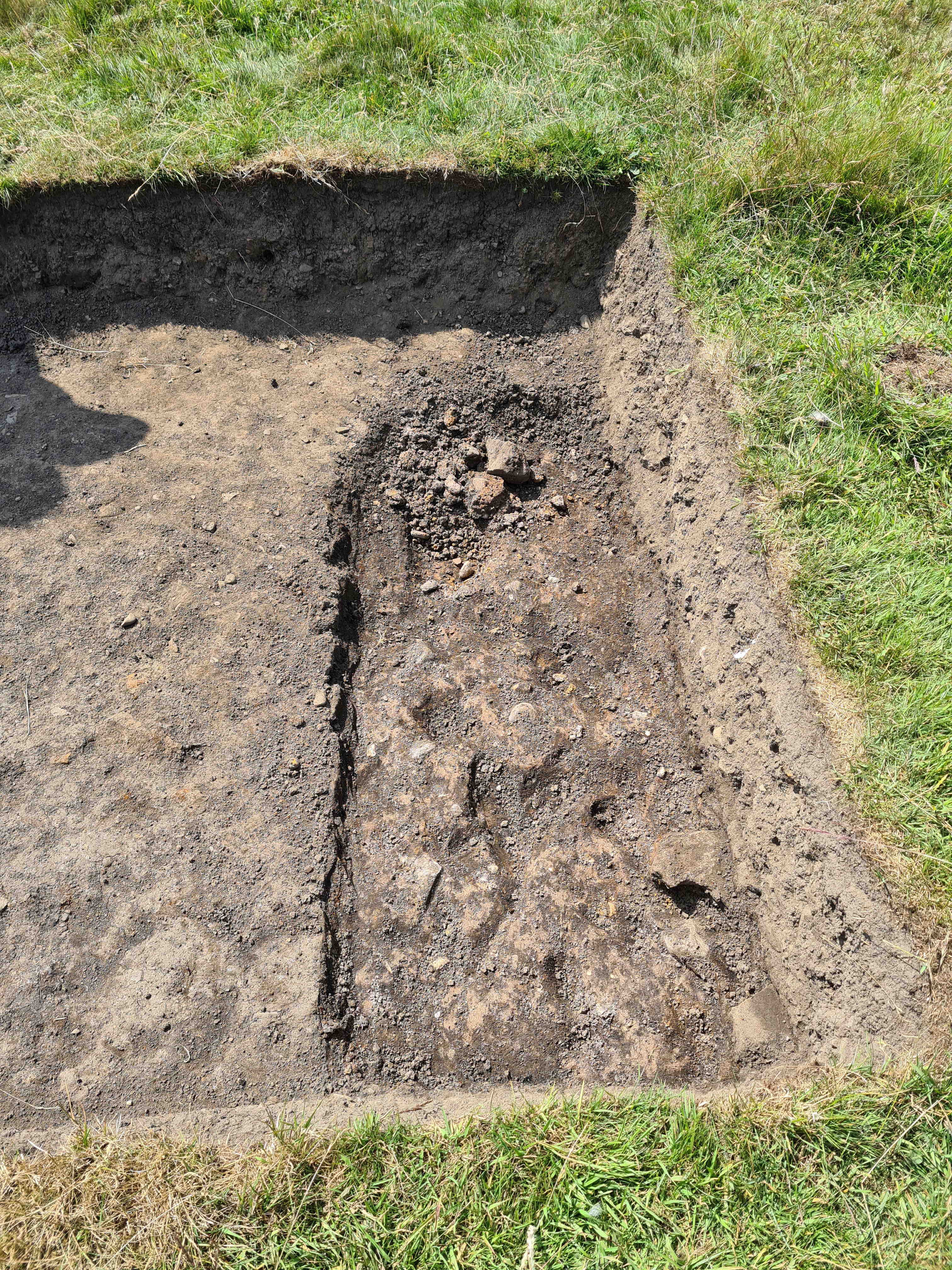
Photo 7

Photo 8
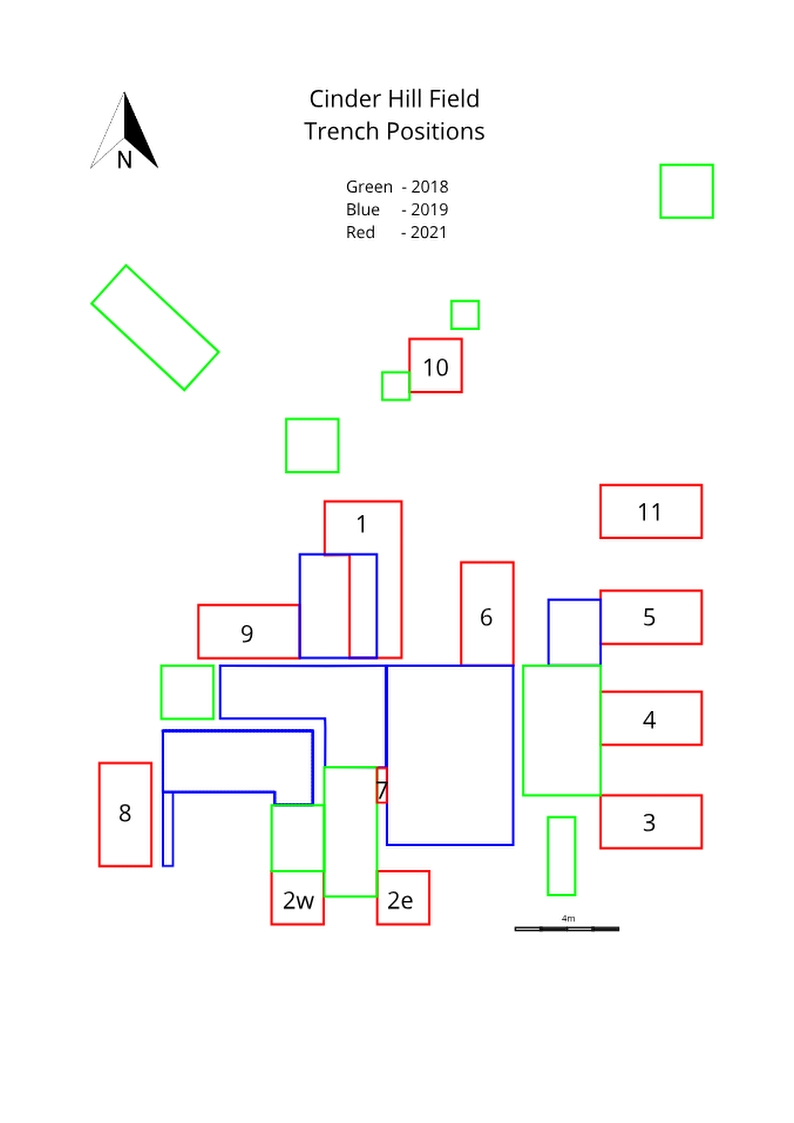
2021 Trench Positions
HMHG Dig Report Thursday 8th July 2021
Weather: Sunny and warm after a couple of days or rain.
Trench 1
Unfortunately following the rain over the preceding couple of days the deeper excavations in the trench were awash with water which had to be bailed out. Throughout the day water kept seeping back into these excavations which was not appreciated.
Most of the larger stones which were left on the north side of the furnace on the 1st July were confirmed as sitting on the backfill, so were removed. It was then possible to continue excavating the tapping channel down to its base and slightly into the base of the furnace. Photo 1. A number of large chunks of slag, probably part of the base of the furnace, were removed from the tapping channel close to the furnace. Photos 2 and 3.
Work continued on the southern side of the furnace removing the topsoil to uncover the clay layer which had been packed around the base of the furnace. This probably served two purposes, structural support and insulation to help retain the furnace heat. Photo 4.
The small size of the tapping pit is still causing some head scratching. From the size of the furnace one would expect a larger tapping pit.
Trench 4
Steady progress has been made on this trench thanks to the rain softening the soil. Photo 5.
More red patches of iron stone dust are starting to appear towards the northern section of the trench. It is unknown at this stage whether this is just a very thin layer or the top of a denser layer. Part of a 17C pipe bowl was recovered. Finds in this trench are surprisingly very few and far between. Maybe we are not down far enough to tap into the domestic rubbish layer; time will tell.
The features in the southwest corner of the trench still hint that some form of archaeology may be revealed. Photo 6.
Trench 6
Excavations continued on the slag strip which runs from west to east on the southern end of the trench.
Part of the slag strip was cut through to determine its depth and whether it was sitting on natural or deposited ground. The layer of slag proved to be fairly thin and was sitting on clay. The clay surface will have to be investigated to determine if it is a natural or laid surface. Photo 7
Work continued on the extension to the west to track the extent of the slag. Photo 8 shows that the slag deposit petered out after a short distance.
Trench 9
Work concentrated on the slag layer in the northwest section of the trench. Photo 9. To ascertain the depth of the slag layer. As can be seen in photo 10, the slag layer in this area of the trench is fairly thick. Photo 10. Work will have to continue on this excavation at the next dig to ascertain the extent of the slag layer.
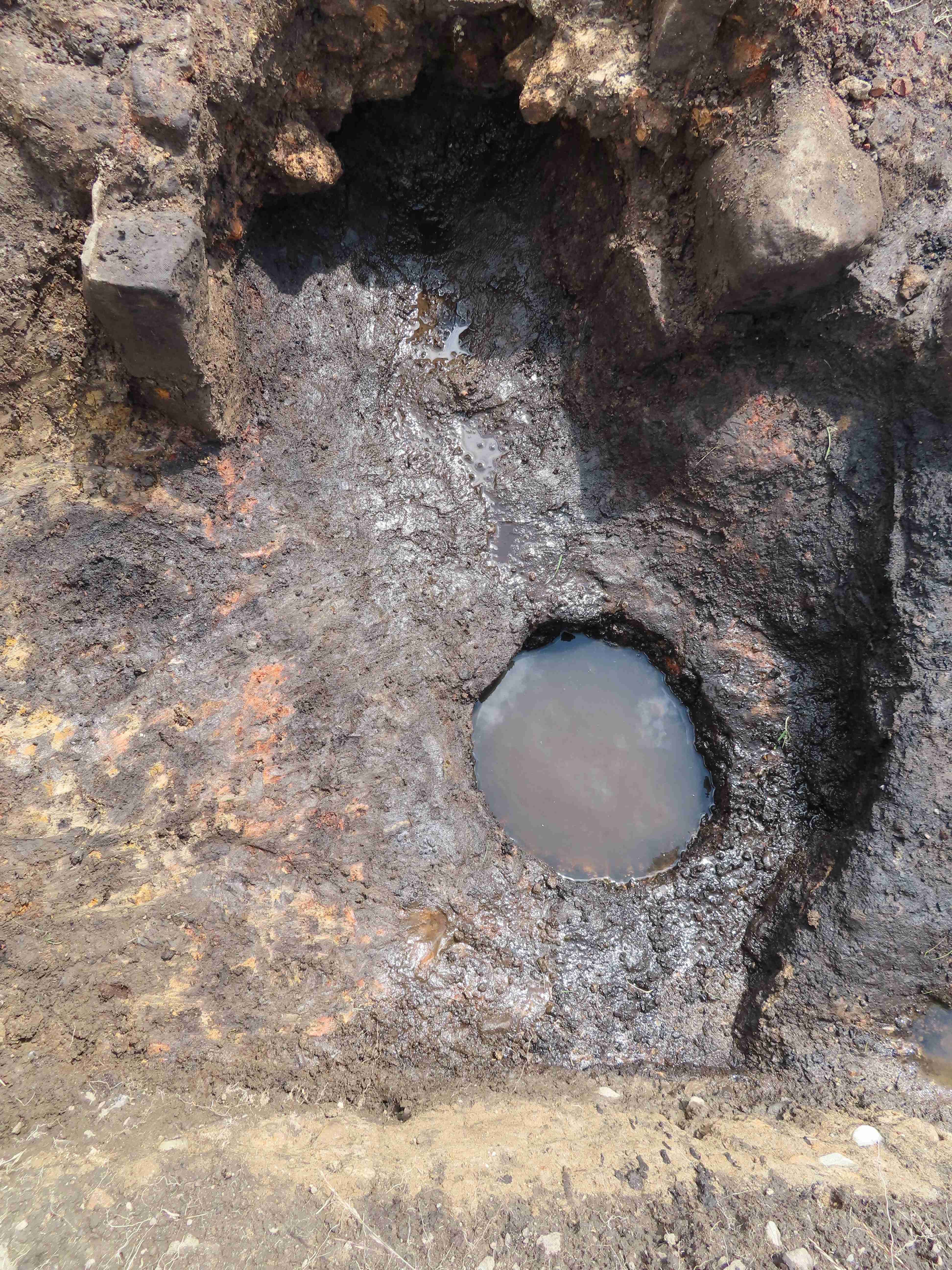
Photo 1
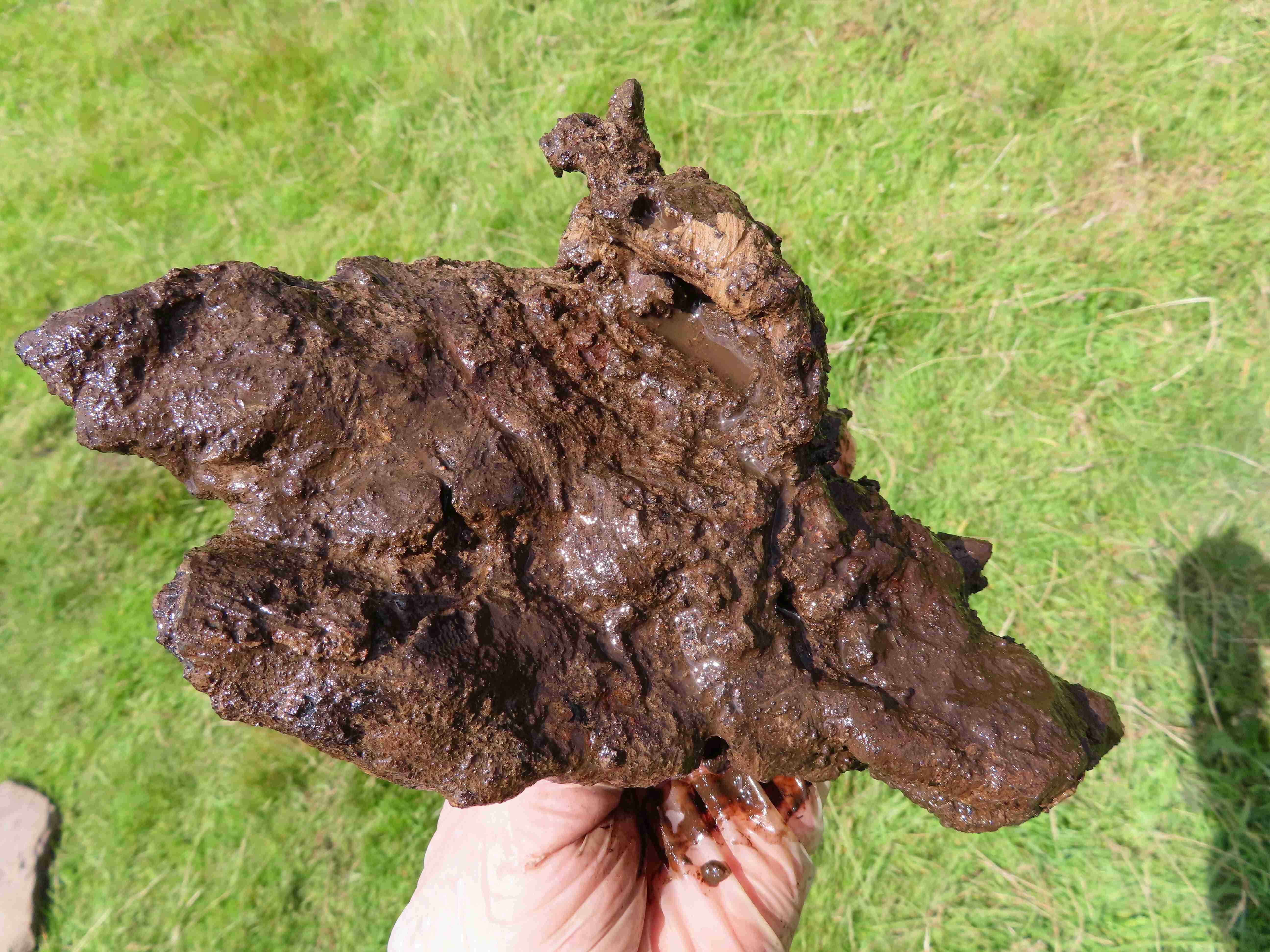
Photo 2

Photo 3
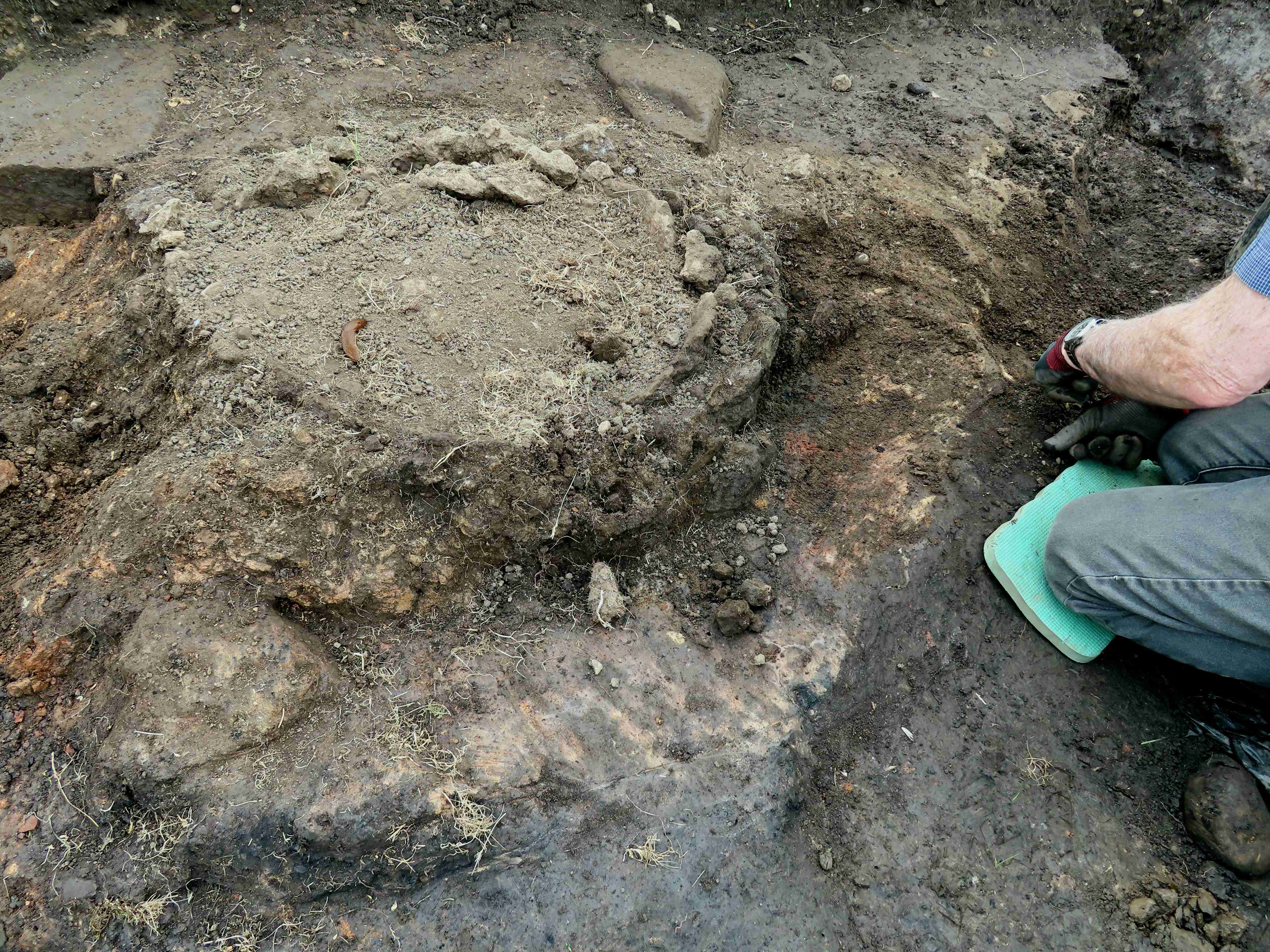
Photo 4
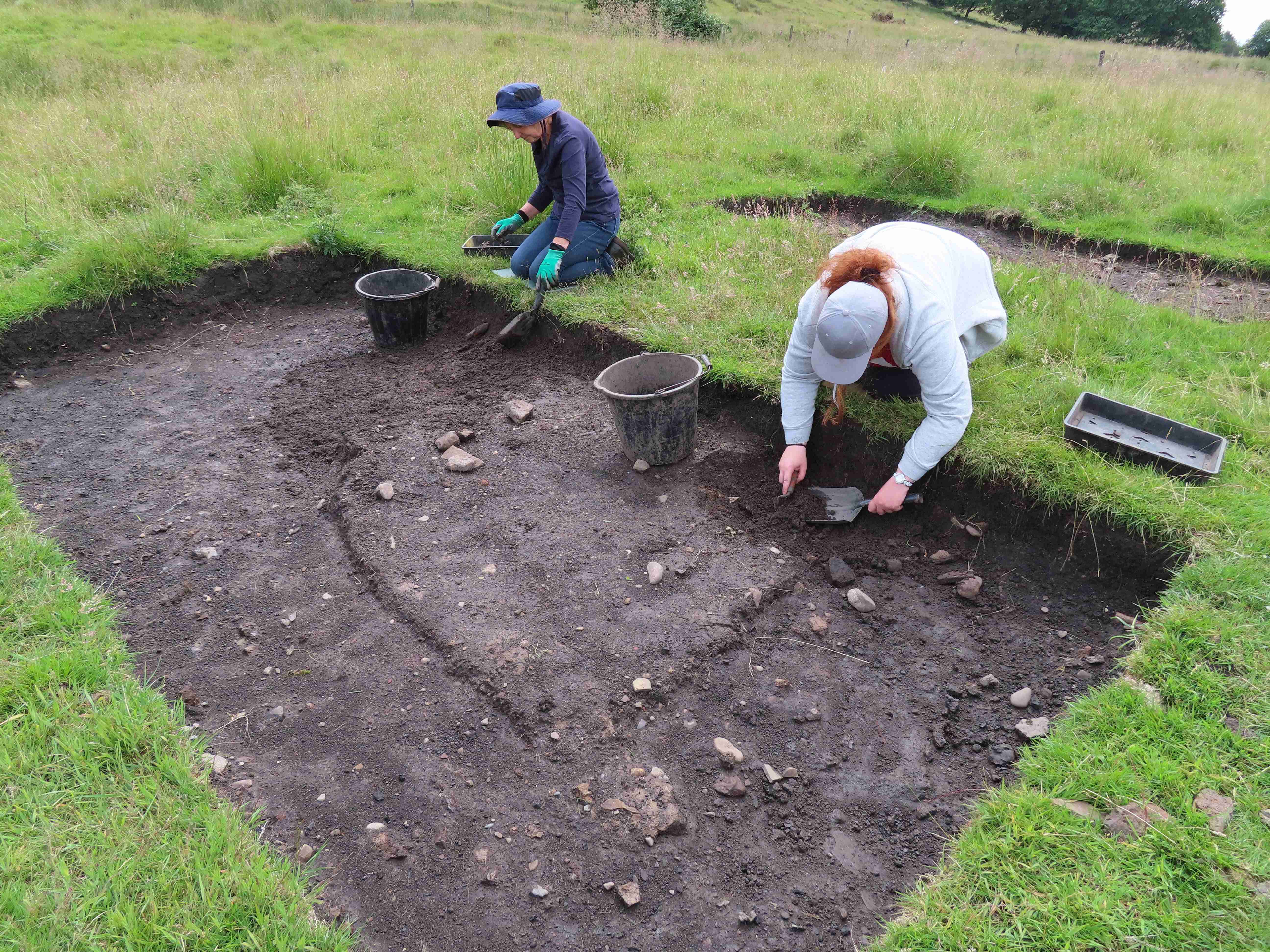
Photo 5
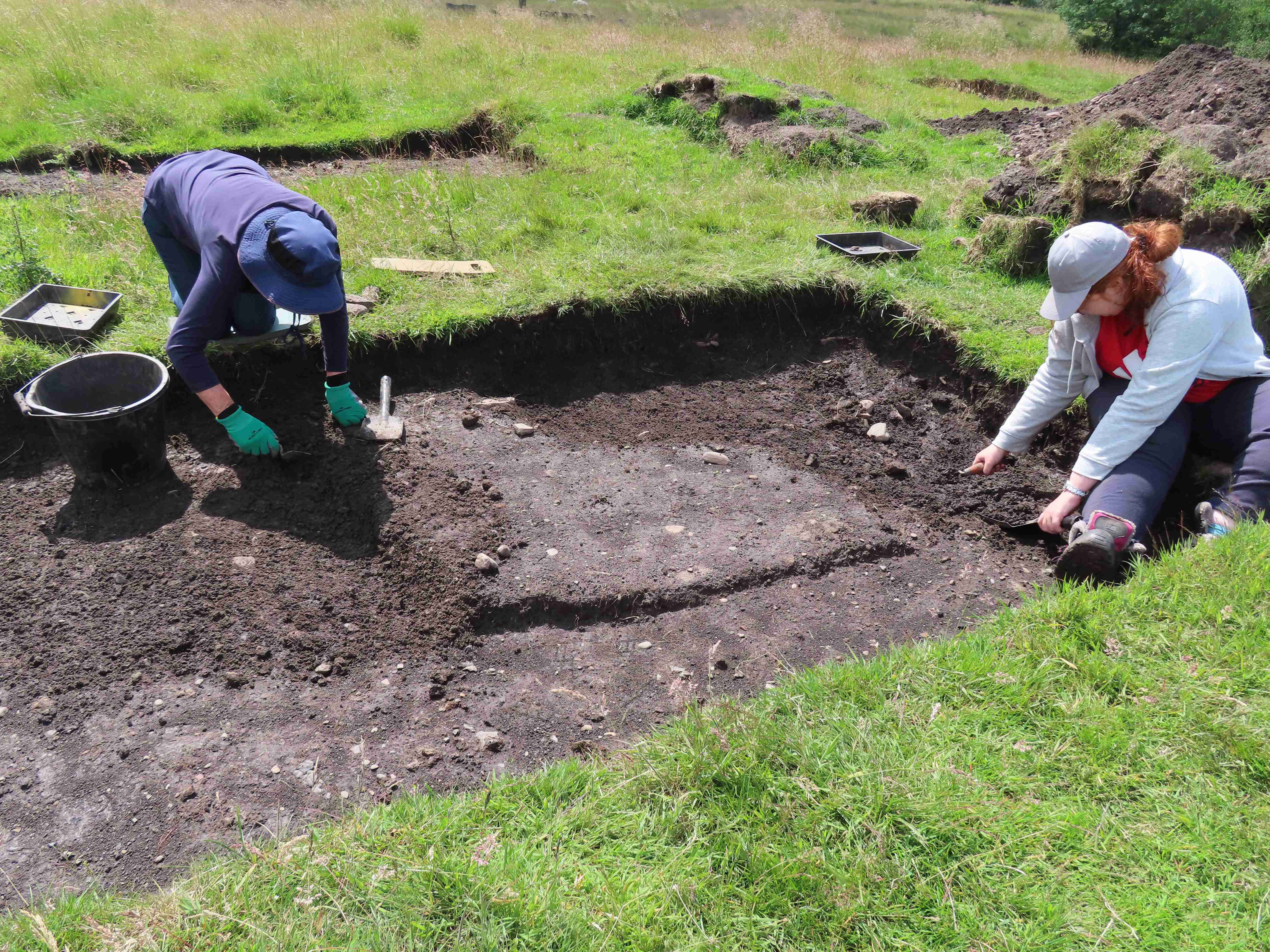
Photo 6
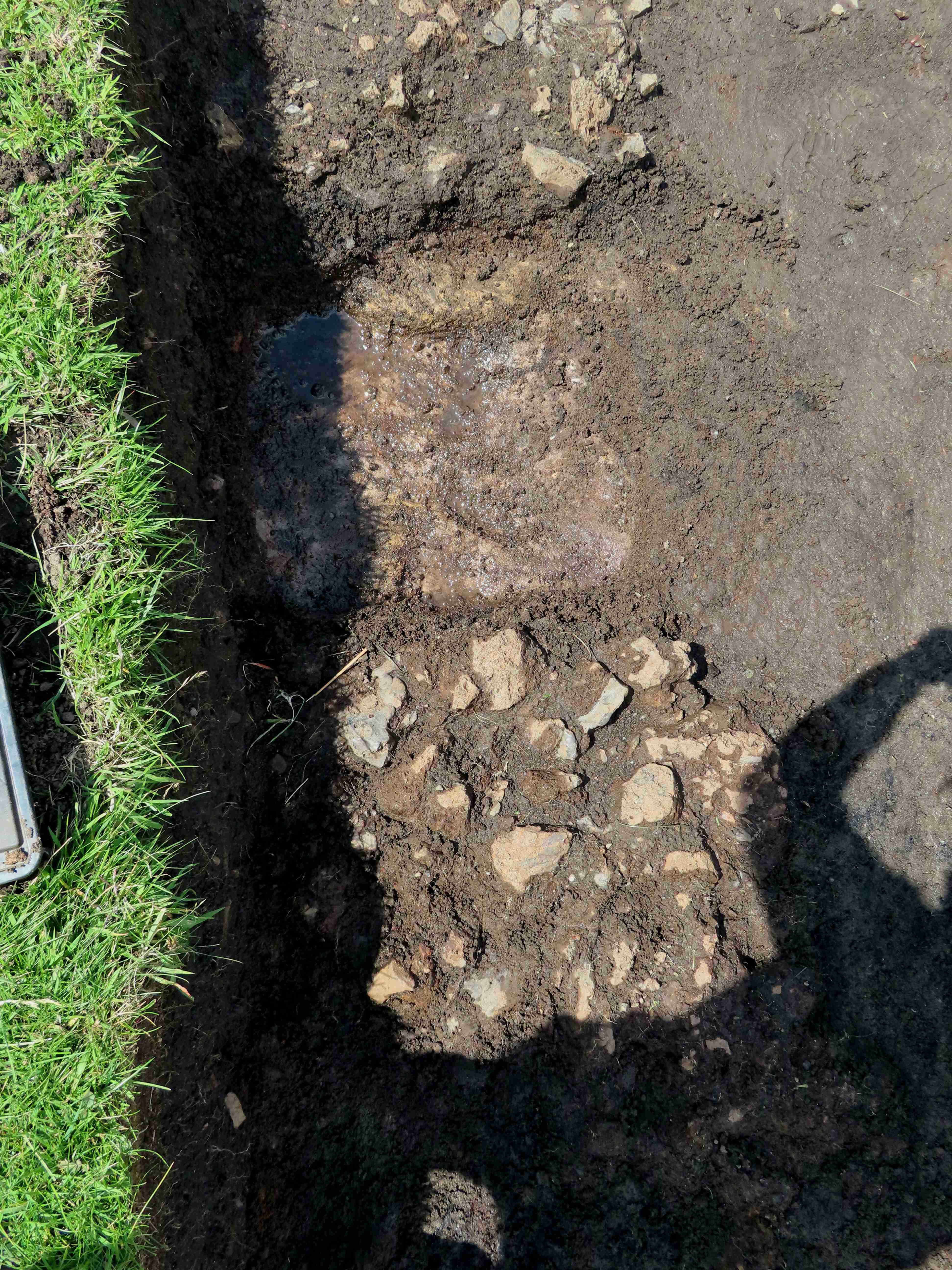
Photo 7
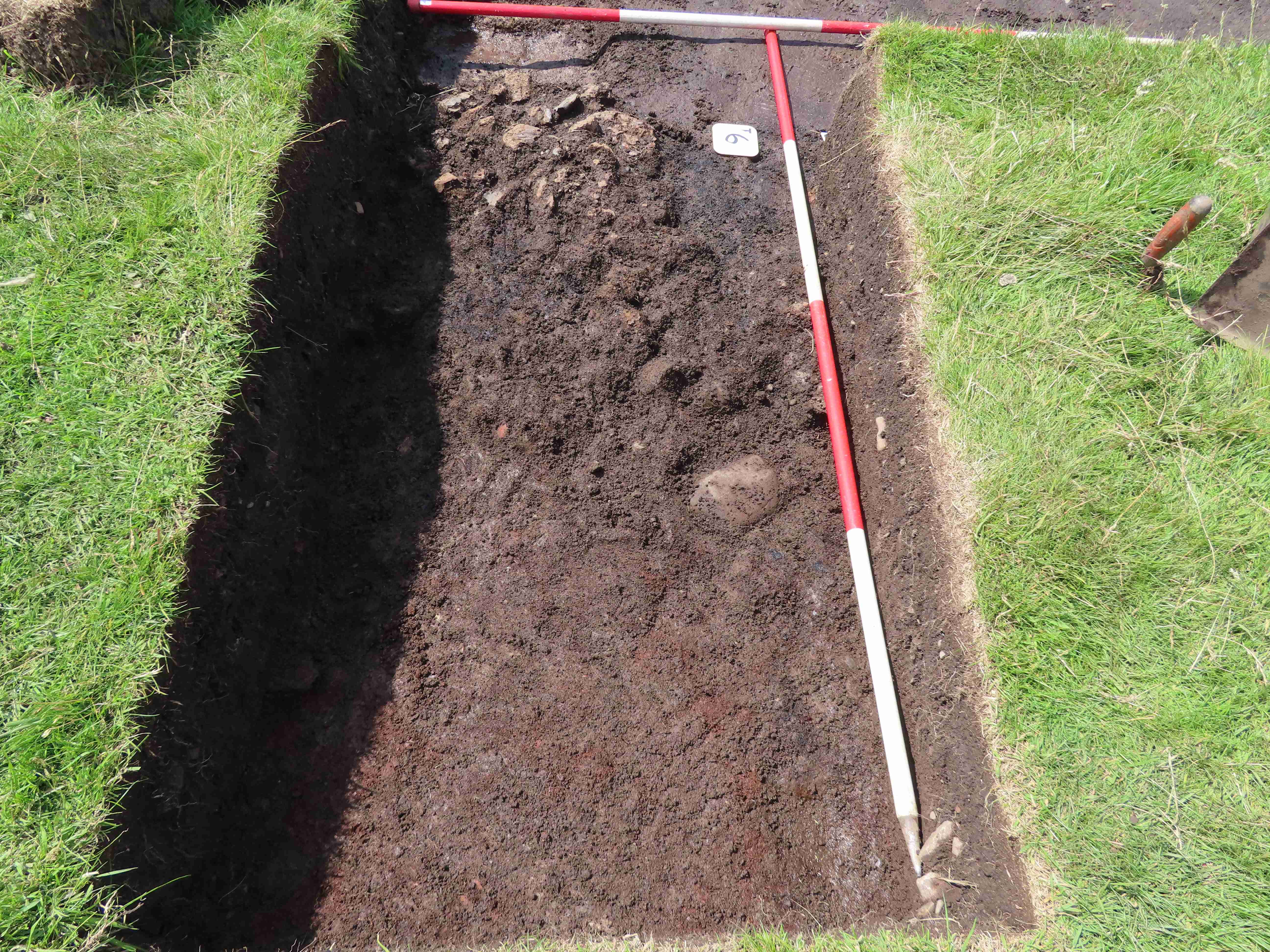
Photo 8
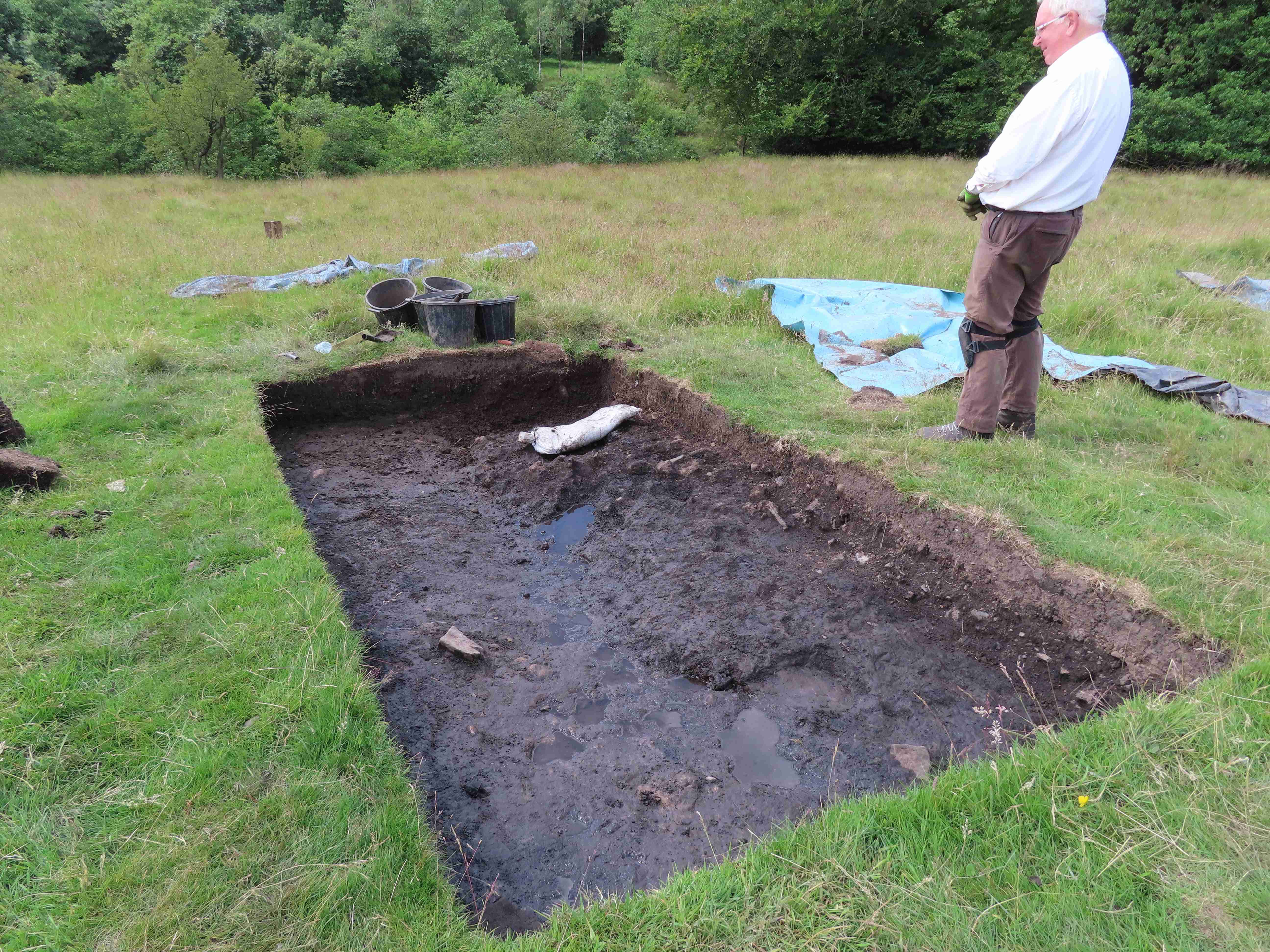
Photo 9
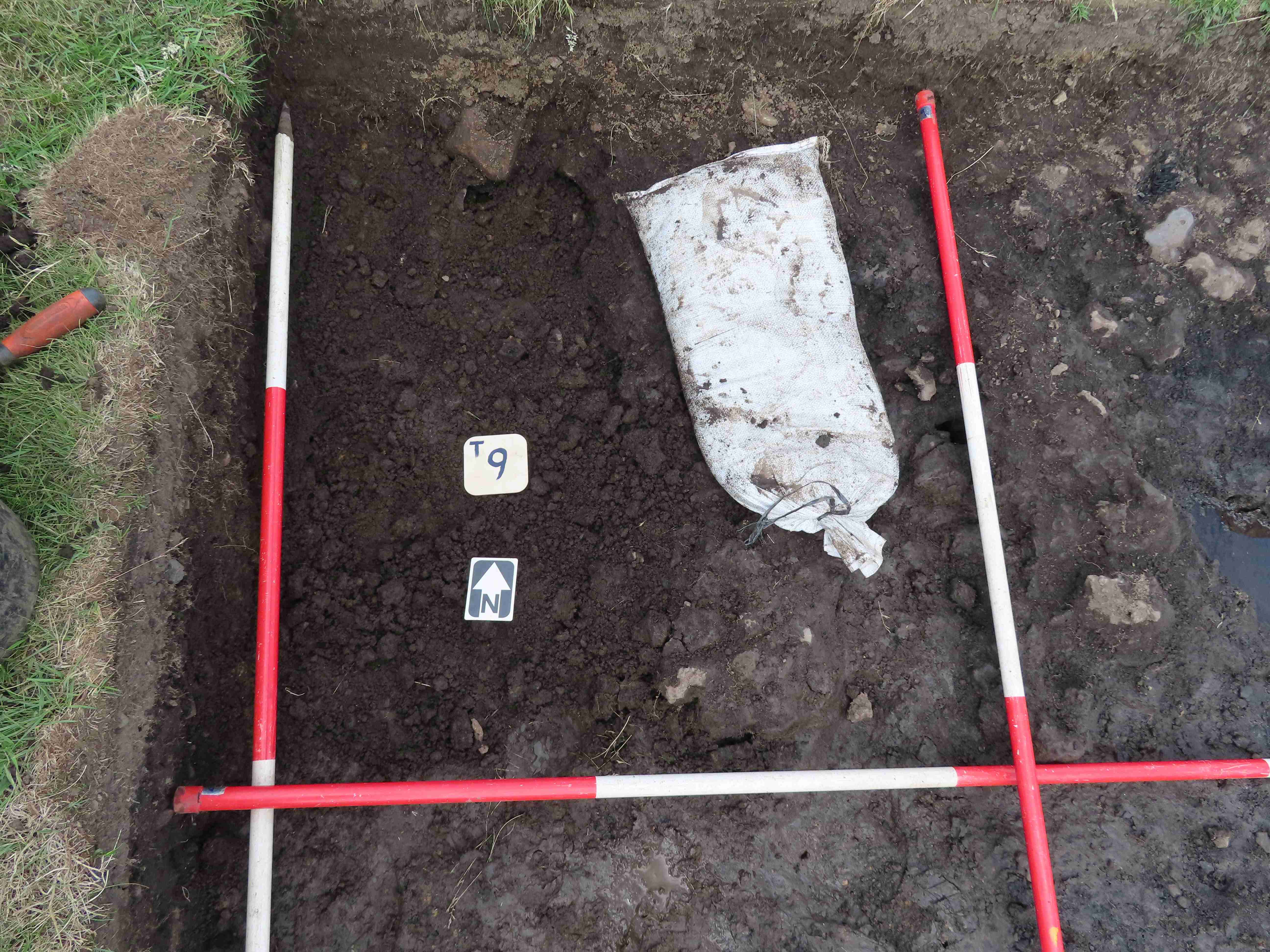
Photo 10
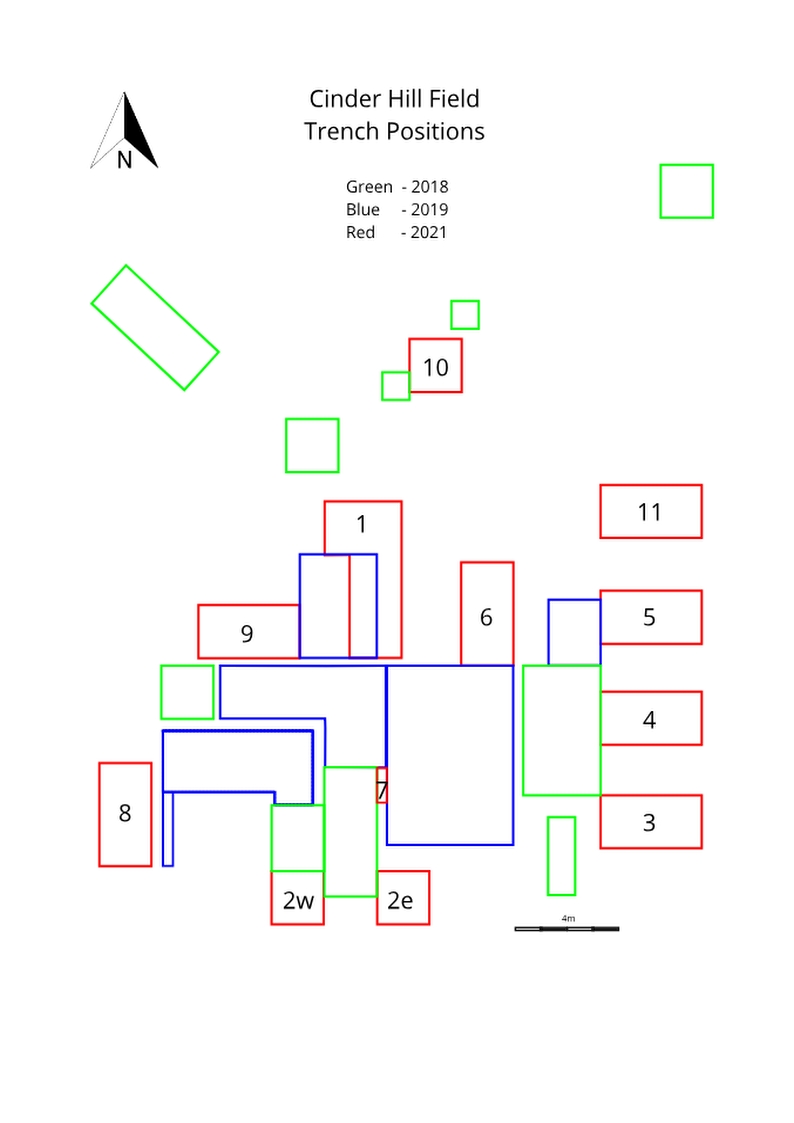
Trench Positions
HMHG Dig Report Thursday 15th July 2021
Weather Sunny and hot, no rain.
Trench 1
The profile of the northern face of the trench was recorded in preparation for possibly extending the trench to the north.
Work continued cleaning the exposed northern face of the furnace, together with the tapping channel and the tapping pit. Photos 15 July Nos.1 and 2. Once all the details have been recorded excavation of the furnace from the top down will be carried out. As most of the structure of the furnace is very brittle and the infill very dry and compacted excavation may take some time.
Trench 2 West
Work continued attempting to remove a compacted mixture of slag and small pebbles. As the natural ground layer has been reached in one section, only a few centimetres from the surface, it is unlikely that any meaningful archaeology will be found in this trench. Photo 15 July Nr. 3. However a very worn small sherd of medieval pottery was recovered from the northeast corner of the trench. As it is badly worn, no sharp edges and very scuffed, it has obviously been moved around in the ground a lot before it reached its final resting place, prior to being unearthed.
Trench 3
Further excavations were carried out in the eastern section of the trench. Photo 15 July No. 4. One small piece of post medieval pottery was recovered.
Trench 4
Work in this trench is proving very difficult due to the ground being heavily compacted and dry. The slag and stone layer peters out in the southwest section of the trench which may be an indication of archaeology in the immediate area or simply a red herring. Photos 15 July No.5 More of the red rust layer was exposed in a small section. Photo 15 July No. 6. If nothing of any significance is found over the next few digs this trench will probably be closed down.
Trench 5
Very much a repeat of trench 4; the ground is very hard and difficult to work so progress is slow.
Trench 6
While excavating the east end of the extension to this trench two pieces of gritty ware were recovered. The east end of the extension together with the northern section of the extension were excavated down to the natural. No further finds were recovered. This trench will be closed down once the exposed details have been recorded. Photos 15 July Nos. 7 and 8.
Trench 9.
Some interesting developments in this trench. In the northwest corner a section of what is considered to be a drain has been uncovered. A drain was uncovered in trench 4 in 2018 and this consisted of a packed clay base, a vertical side stone and a 45 deg. capping stone, so a cross-section of the drain resembled a right-angled triangle. It is suspected that this drain in trench 9 is a continuation of the drain discovered in 2018. Trench 9 will be extended to the west to investigate this drain further. Photo 15 July No. 9.
At the eastern end of the trench the cut extending from trench 1 was uncovered. It is currently full of charcoal ash and appears as the dark stain in photo 15 July No. 10. There is also a round charcoal filled patch to the north of the uncovered cut. This was originally thought to be a potential post hole. However, as the feature was very shallow there is some doubt as to its purpose as it is not deep enough for a post hole. Photo July 15 No. 11
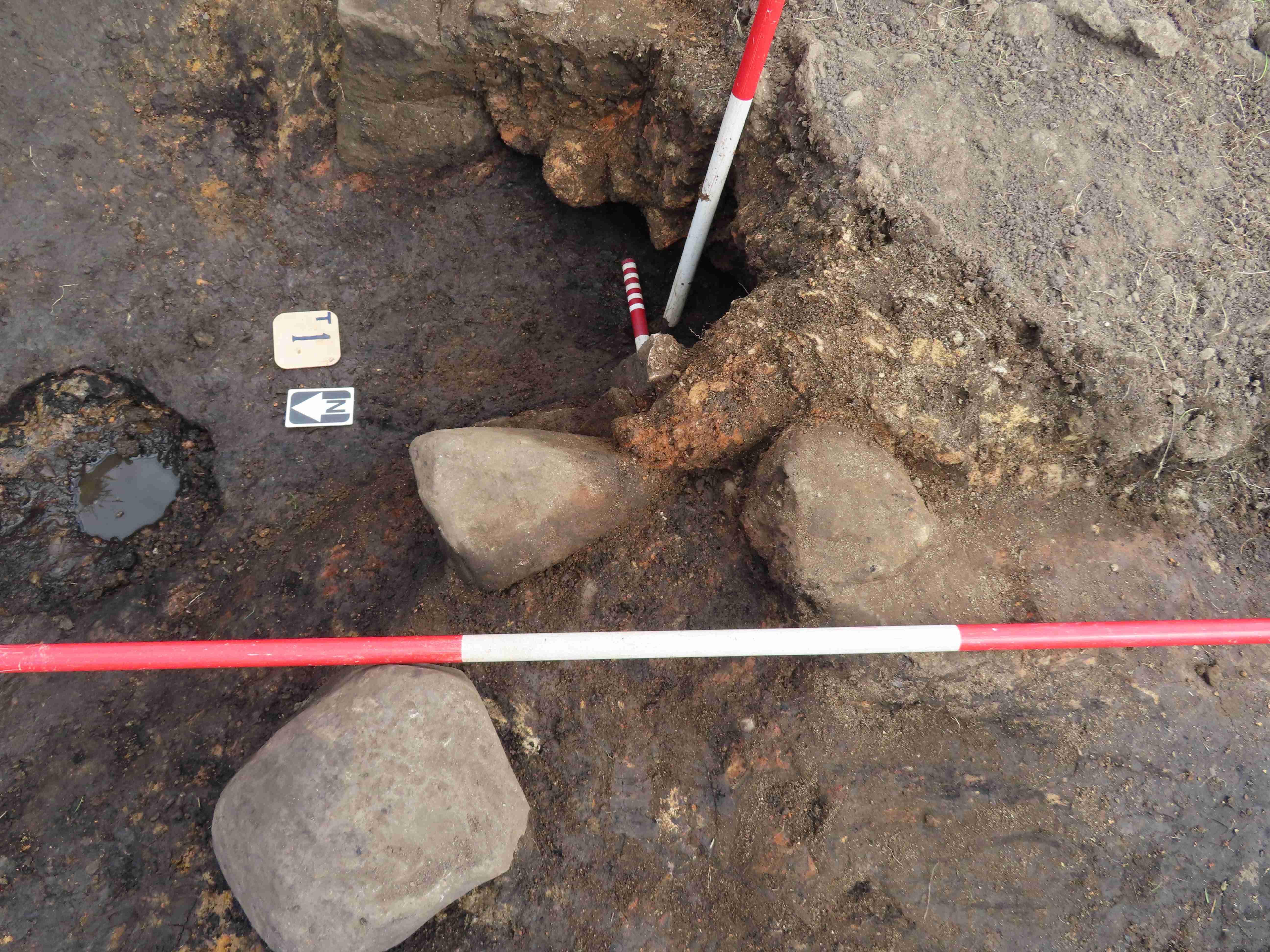
15 July No 1
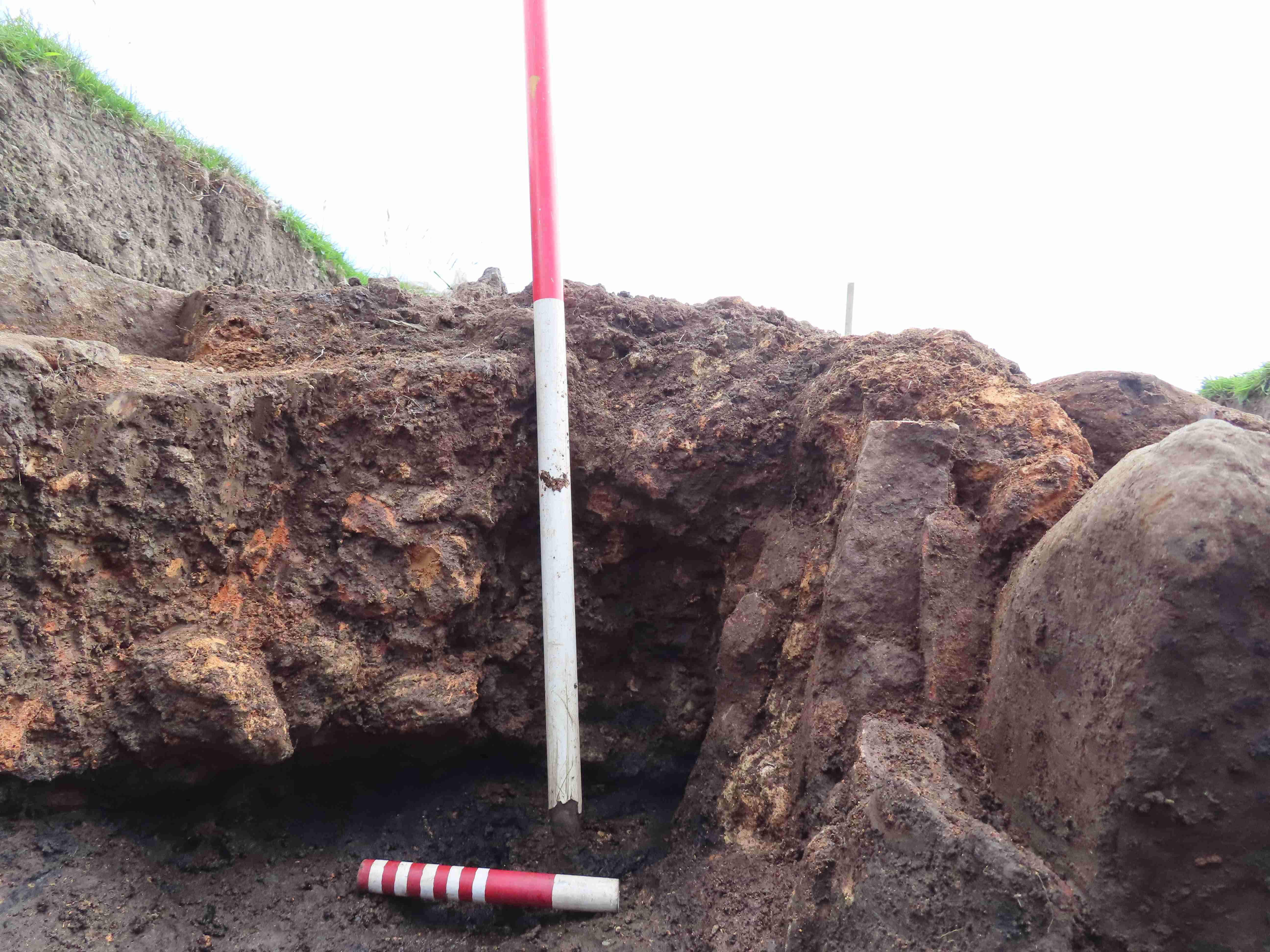
15 July No 2
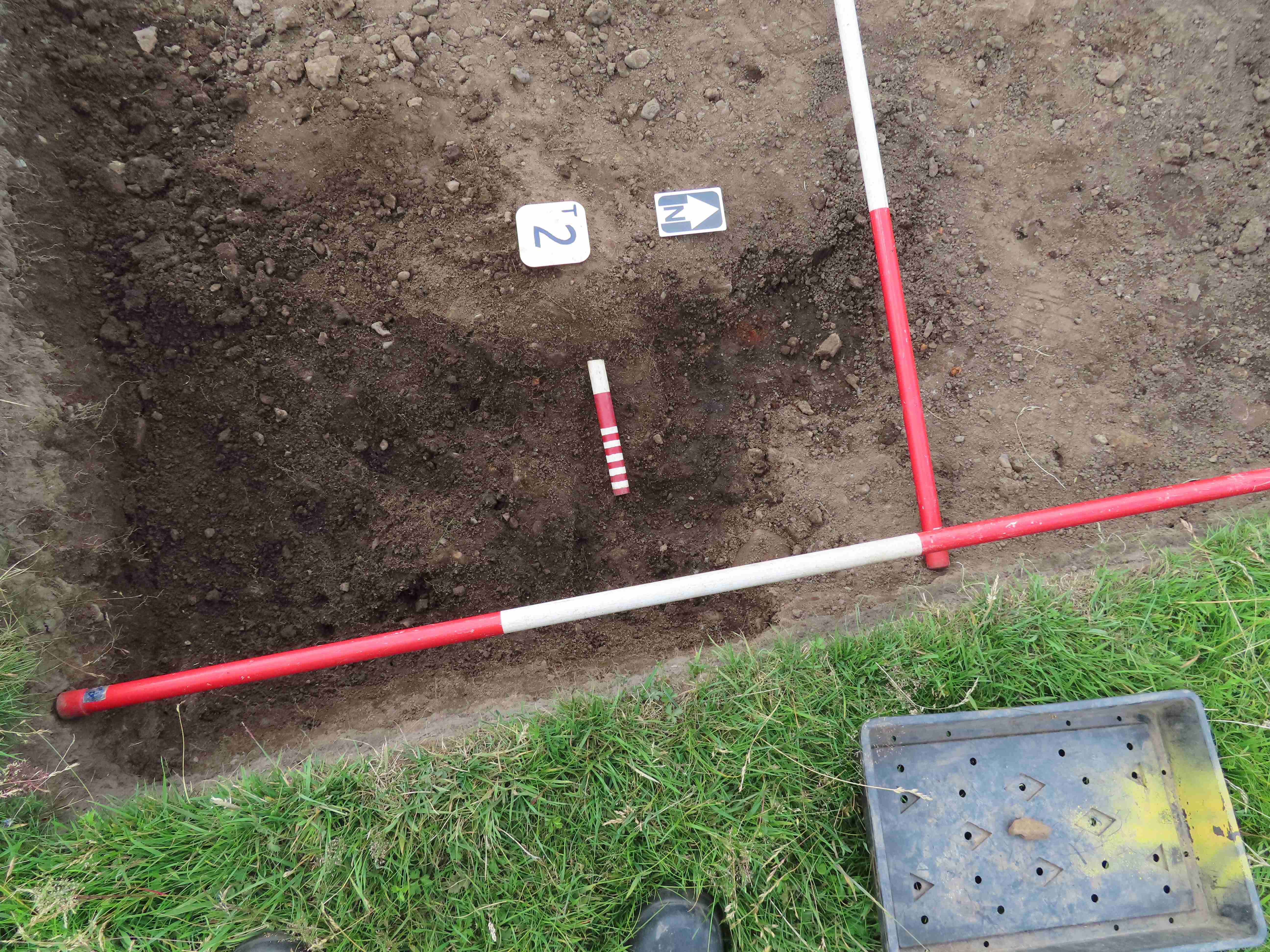
15 July No 3

15 July No 4
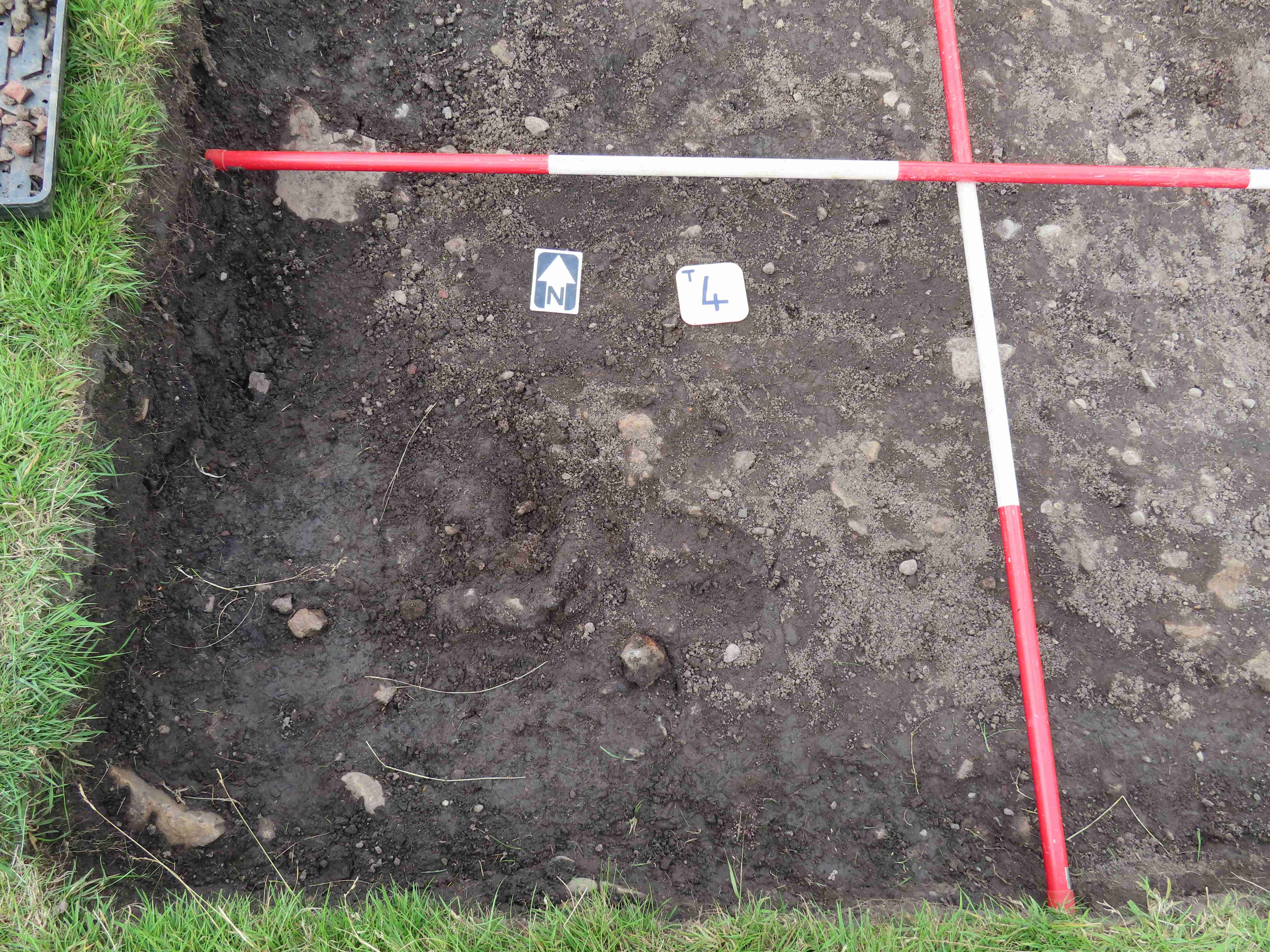
15 July No 5

15 July No 6

15 July No 7
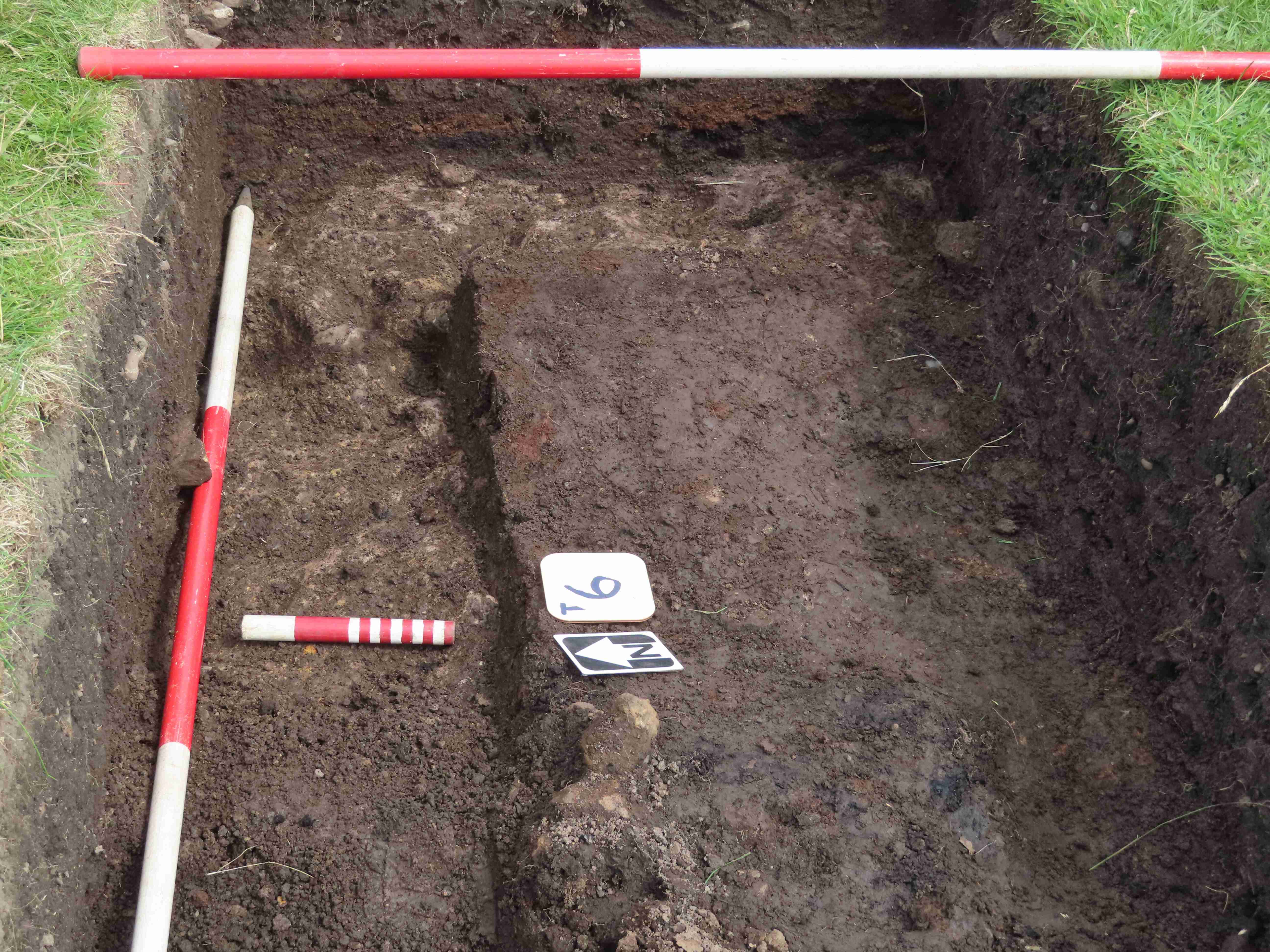
15 July No 8

15 July No 9
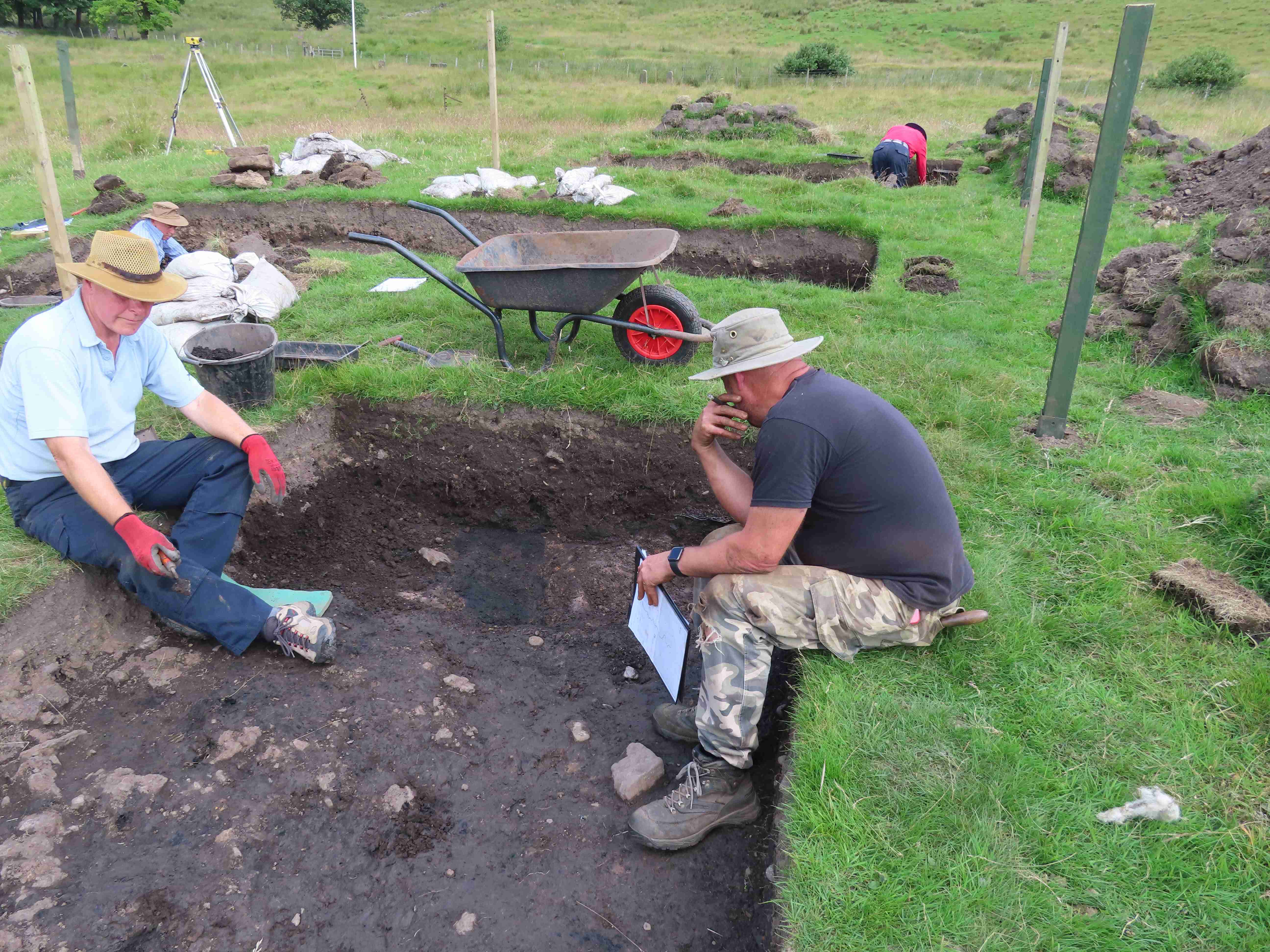
15 July No 10

15 July No 11
Weather overcast and raining
Due to the inclement weather, it was decided to restrict operations to one person excavating trench 3, which was reasonably water free due to good drainage, and the remainder of the group de-turfing a metre strip on the north, east and south sides of trench 1. This is in preparation to extend trench 1. Intention was to leave the site at midday.
Trench 3
In the short time available three sherds of gritty ware pot were recovered from the vicinity of the south wall of the trench. Fortunately, the three sherds were all from the same pot section and could be joined together. Interesting features on the pot are the two decoration grooves which would have run around the circumference of the complete pot. This feature has not been seen on any pottery previously recovered from the site. Photos 29 July, Nos. 1 & 2.
Trench 1
The 1-metre strip de-turfing operation went very smoothly, enabling us to complete the operation by 11:45hrs. Photos 29 July, Nos. 3 & 4.
Trench 5
The only good thing that can be said about a waterlogged trench - it can be used to clean the tools. Photo 29 July, no. 5.
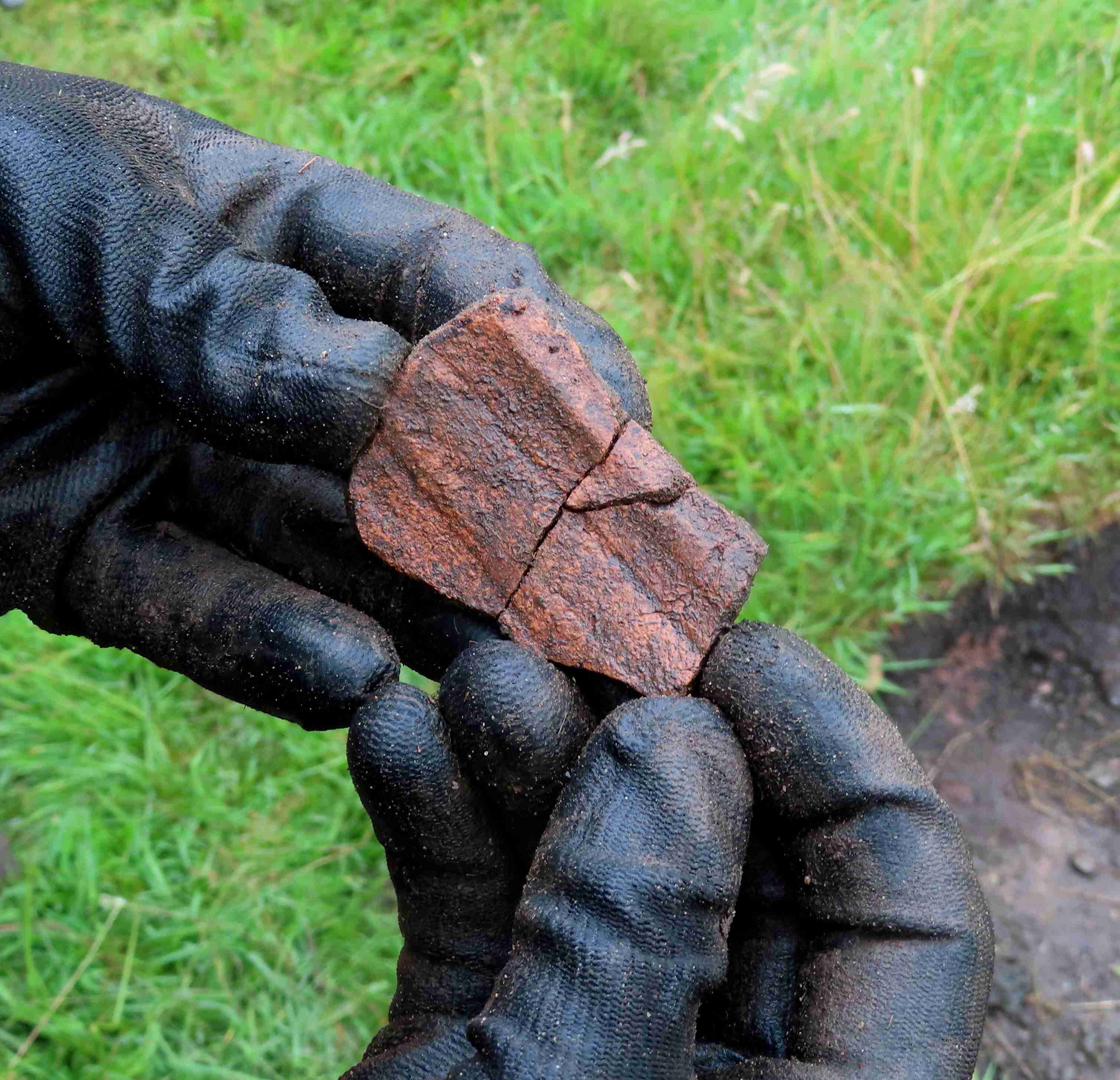
29 Jul No1
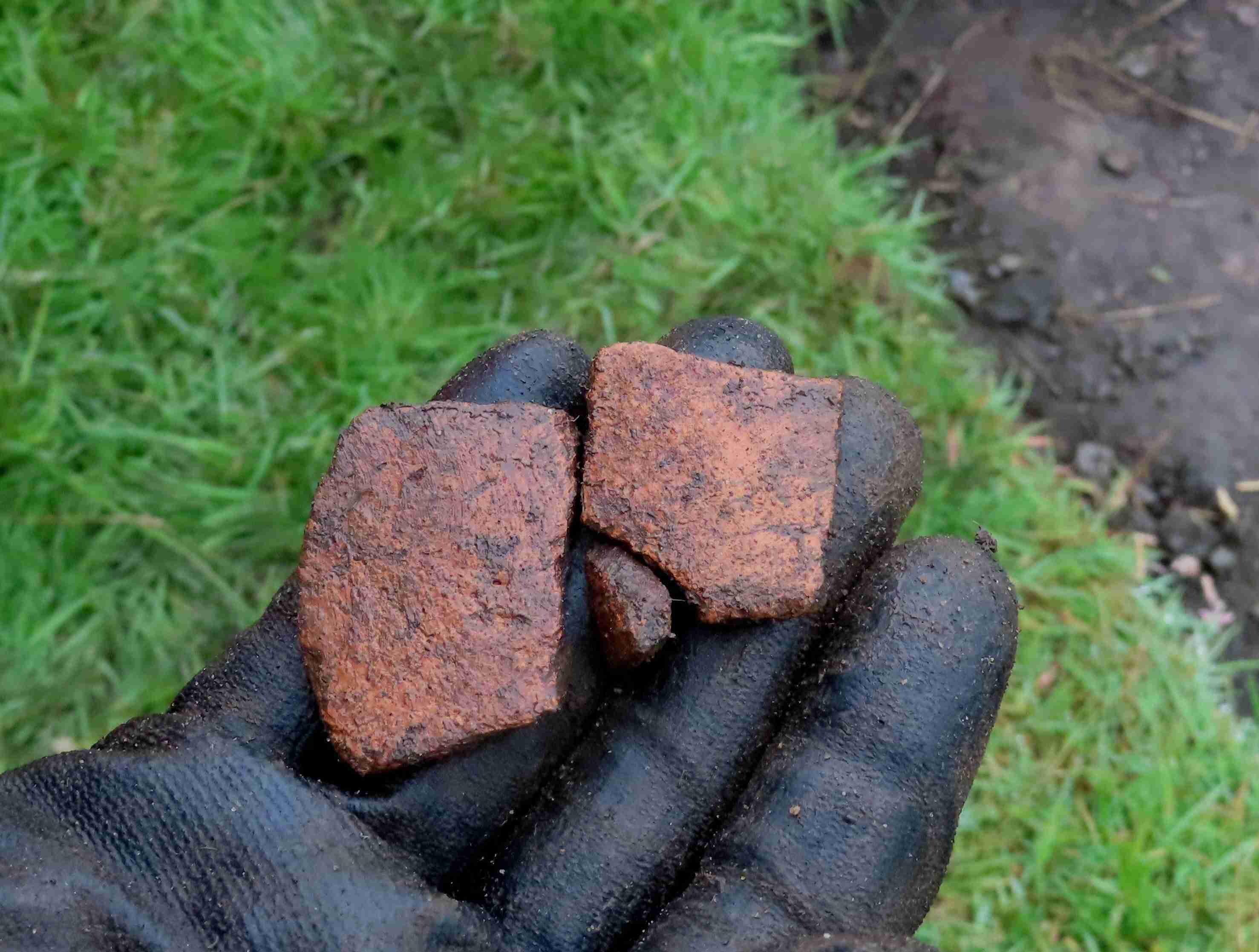
29 Jul No2
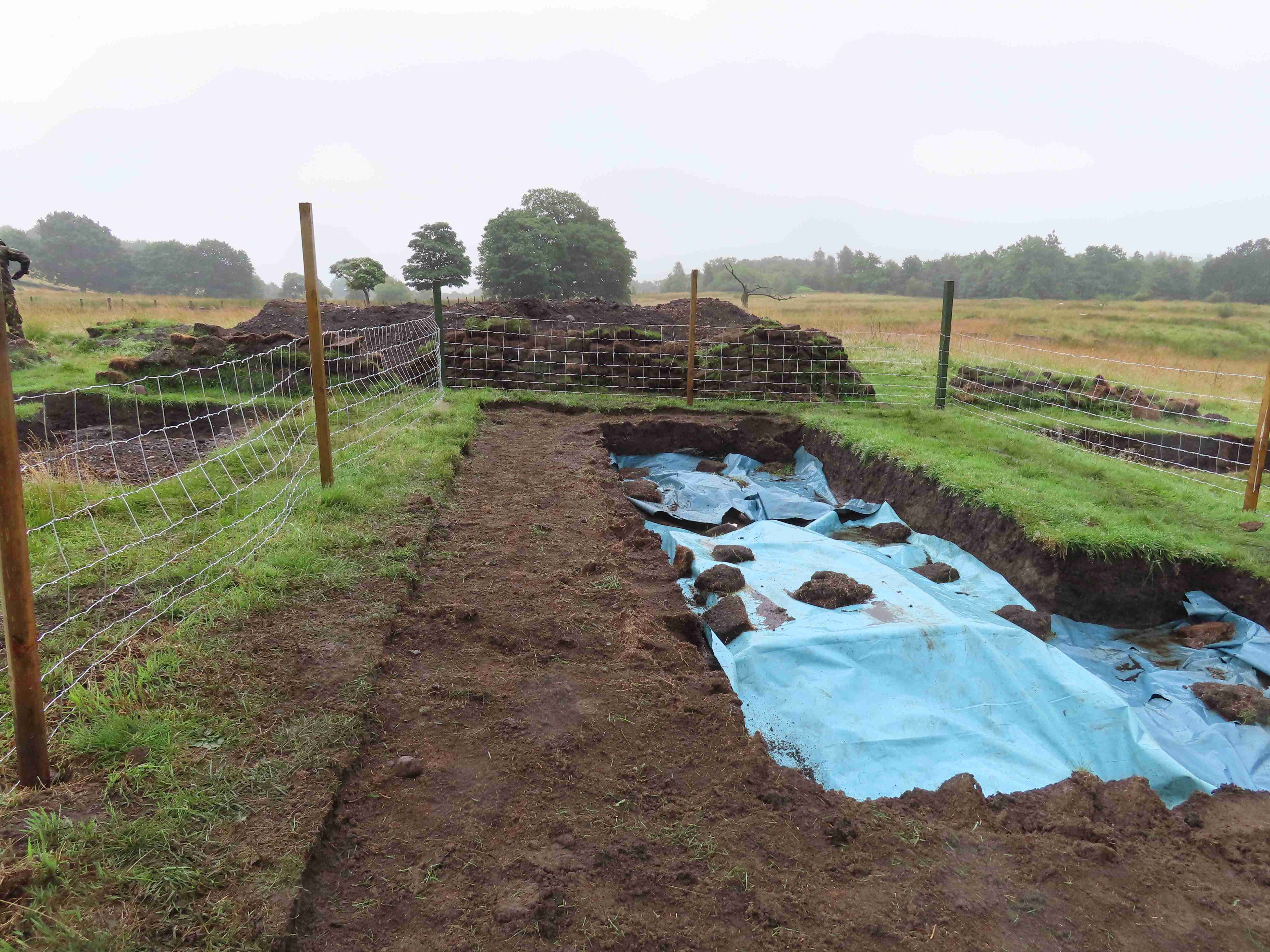
29 Jul No3
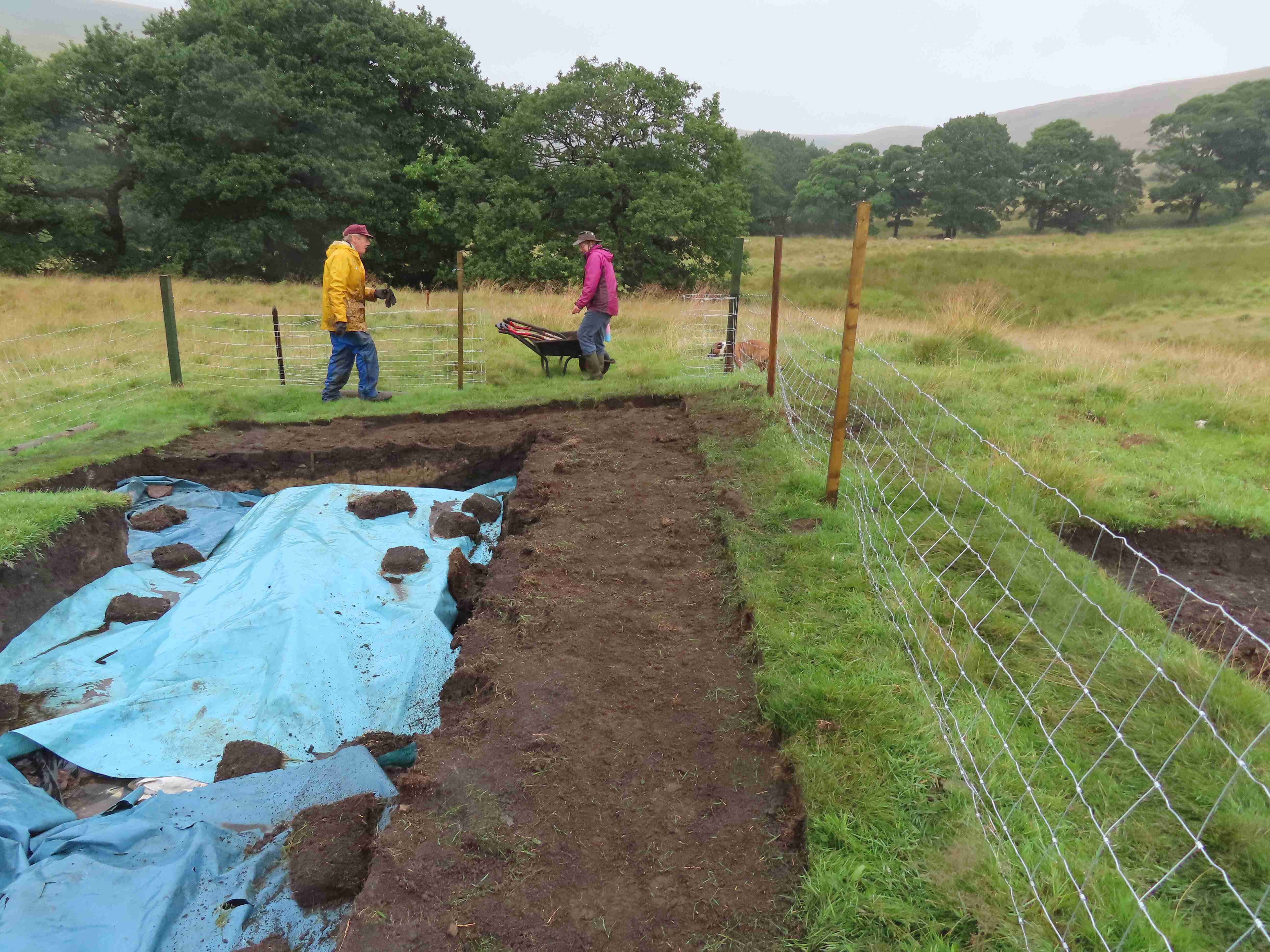
29 Jul No4
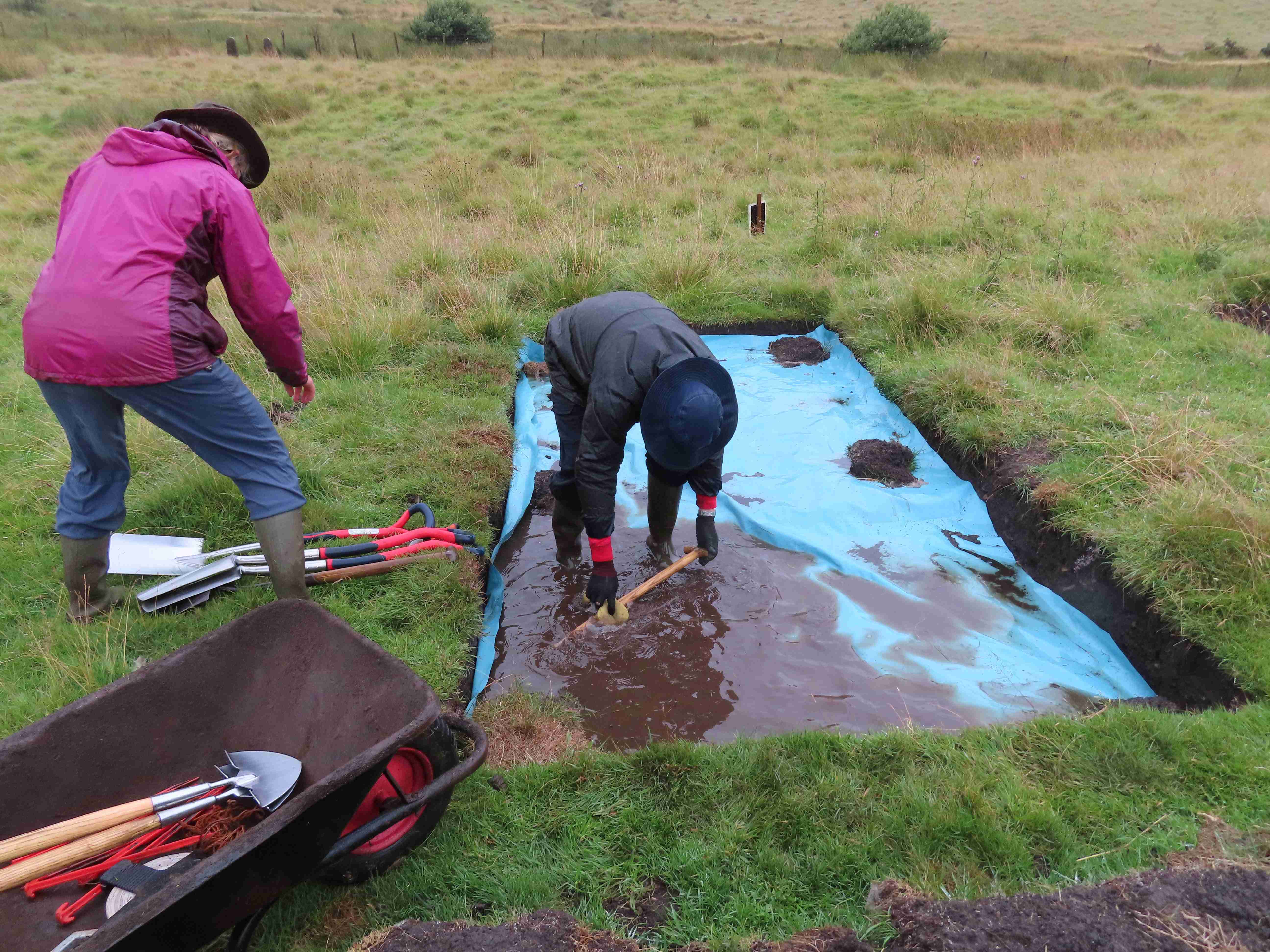
29 Jul No5
Weather: Overcast and dry in the morning until approx. 11:50hrs when the rain started. Work continued until the lunch break at 12:30 hrs. As it was still raining after the break, the decision was made to abandon the dig session.
Trench 1
During the last dig a metre wide section on the North, East and South sides of the trench was de turfed in preparation for extending the trench. Today work started on removing the topsoil, Photo 19 Aug No.1. The top of the photo is the north end of the trench where the topsoil has been removed to reach a clay layer. This clay layer extends down the left-hand side of the trench (East side) but is slowly rising resulting in a shallower layer of topsoil. At the bottom of the photo, the North end of the trench, a deeper section of topsoil has been removed revealing a compacted clay layer.
Photo 19 Aug No.2 shows this area looking North. Just to the left of the halfmoon of clay is a deposit of slag topped by a very thin layer of very loose sandy clay. To the left of the slag is a very wide band of deposited compacted clay. If you can zoom in on the picture the structure will become clearer. The archaeology of the northeast corner of the trench consists of a very complicated deposit of different materials in different contexts and is going to be very difficult to unpick. There is a large deposit of slag in the corner under the halfmoon clay deposit which may extend some considerable distance downwards and to the Northeast. It is going to be very interesting excavating this area. Could it lead to another bloomery? Hopefully it will.
A number of medieval pottery sherds were recovered from all areas being worked on.
Trench 2 West
This is proving to be quite an interesting trench. Photo 19 Aug No. 3. On the right-hand side of the photo, the south face of the trench, the compacted slag layer has been removed to reveal a layer of light coloured clay. It is interesting to note that the slag layer was so compacted that the mattock was bouncing off the slag, making very little impression on it. Just to the left of the cleared area there is a narrow strip of very compacted material running east to west, which will need further investigation to ascertain its composition. To the left of the strip is the continuation of the compacted slag layer. At the moment the reason for the slag layer is unknown. It may just be a deposit which has become compacted due to foot and cart traffic, or it could be part of the trackway running east to west down to Red Brook. Further investigations will be carried out to try and identify its purpose. Eventually the slag layer will be removed down to the natural level to ascertain whether there are any post holes in the natural. If there are, then this will prove the slag is a much later deposit. The trench was originally opened, in this location, to try and find post holes which may have been utilised to support a cover for the first bloomery.
A couple of medieval pottery sherds were recovered from the trench.
Trench 9
Neil attempted to record this trench. Steady progress was being made until the rain started which literally put a dampener on his work, so he called it a day. Once the trench has been recorded the intention will be to back fill it and close it down.


Photo 19 Aug No 3
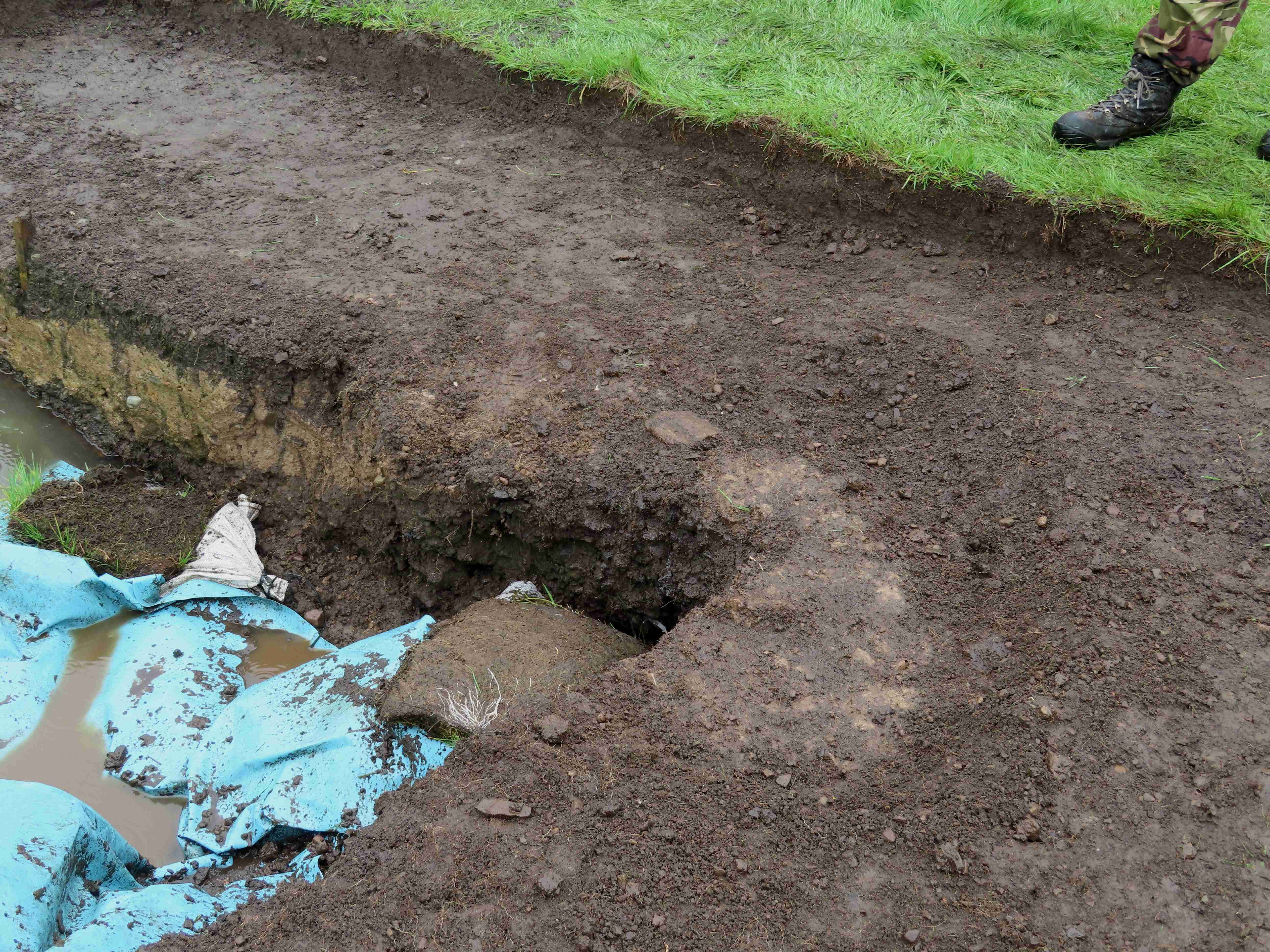
Photo 19 Aug No 2

Photo 19 Aug No 1
HMHG Dig report Saturday and Sunday 21st and 22nd August 2021
Weather
Saturday - Overcast and warm. Light rain in the morning, stopped around 12:00 hrs., afternoon was dry
Sunday - Overcast until approx. 10:30hrs, sunny for the rest of the day, very warm, no rain
Trench 1
Work continued removing the topsoil from the extended south, east and north faces of the trench.
Most of the southern section has not produced anything of archaeological interest. In the Northeast corner, however, there are some unusual features appearing which hopefully will become clearer. Earlier, in the pre- extension period, a large negative feature was uncovered in this southeast corner of the trench. It was thought that this would extend into the current extension. These new features are only a few centimetres east and higher than this negative feature, so raises some interesting questions. There are also two largish stones which have been subjected to high temperatures, sitting one on top of the other, which may or may not be fused together. Hopefully this corner can be sorted out at next Thursday’s dig. Unfortunately, once further excavations are carried out we may find something of interest one day, which turns out to be very mundane the next. See Photos 22 Aug No 1 and 22 Aug No 2.
Excavation of the eastern extension is progressing slowly without any significant features being revealed. There are, however, plenty of opportunities for this lack of features to be reversed as the excavations get closer to the bloomery. Photo 22 Aug No 3.
Continued work on the southern end of the trench extension has removed all the topsoil from the spread of compacted yellowy orange deposited clay. Originally it was thought that this clay would extend further to the north. However there is a very uneven intrusion extending into the clay which can be seen in photo 22 Aug No 4. If the yellowy orange clay is deposited, one would expect the boundary between it and the intrusion to be a fairly straight line, unless there is something man-made further to the north which is later than the deposited clay and has intruded on it.
Trench 2 West
At close of play on Thursday 19th August there was a possibility that the compacted slag formed a trackway from east to west to Red Brook. Unfortunately, this proved not to be the case; the slag appears to be loose remnants from the construction of the track way. It was also hoped that there may have been one or more post holes under the slag. Unfortunately, this proved not to be the case. There was just the grey natural clay under the slag.
As trench 2 West, together with 2 East, have proved to be barren of any archaeological features they have been closed down and are in the process of being back filled.
Trench 5
Approximately a third of the eastern section of the trench needed to have topsoil removed. This is an interesting trench in that a large number of medieval gritty wear pot sherds have been recovered from it since it was opened. The final third of the trench did not disappoint as another large number of sherds were recovered. Photo 22 Aug No 5. The whole of this trench only has a couple of centimetres of topsoil left before the natural grey clay is reached, therefore a couple of days good work should see this trench completed. Hopefully there will be more medieval sherds lurking in the remaining topsoil.
Trench 9
This trench has been completed and is in the process of being backfilled.
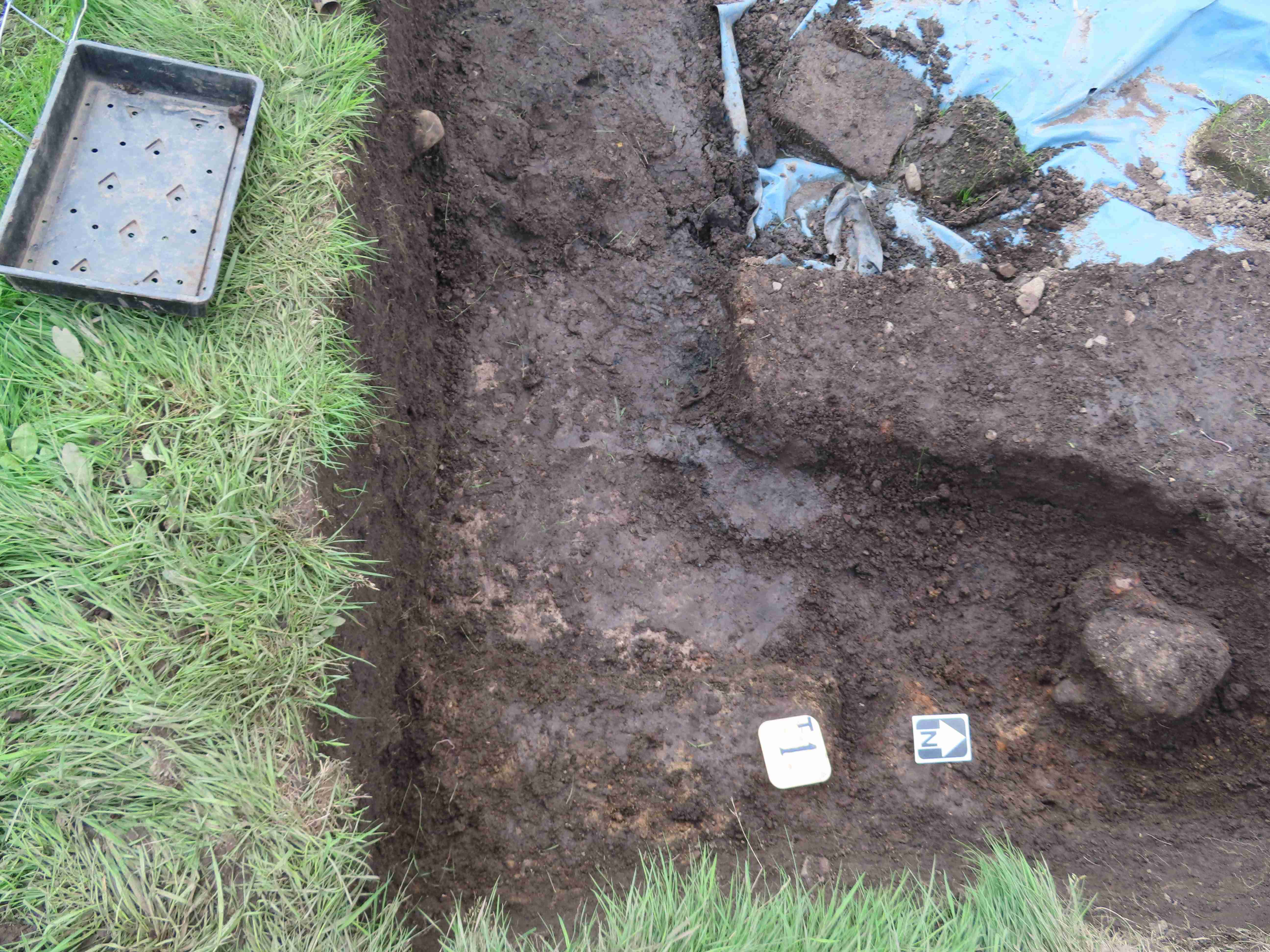
Photo 22 Aug No 1

Photo 22 Aug No 2
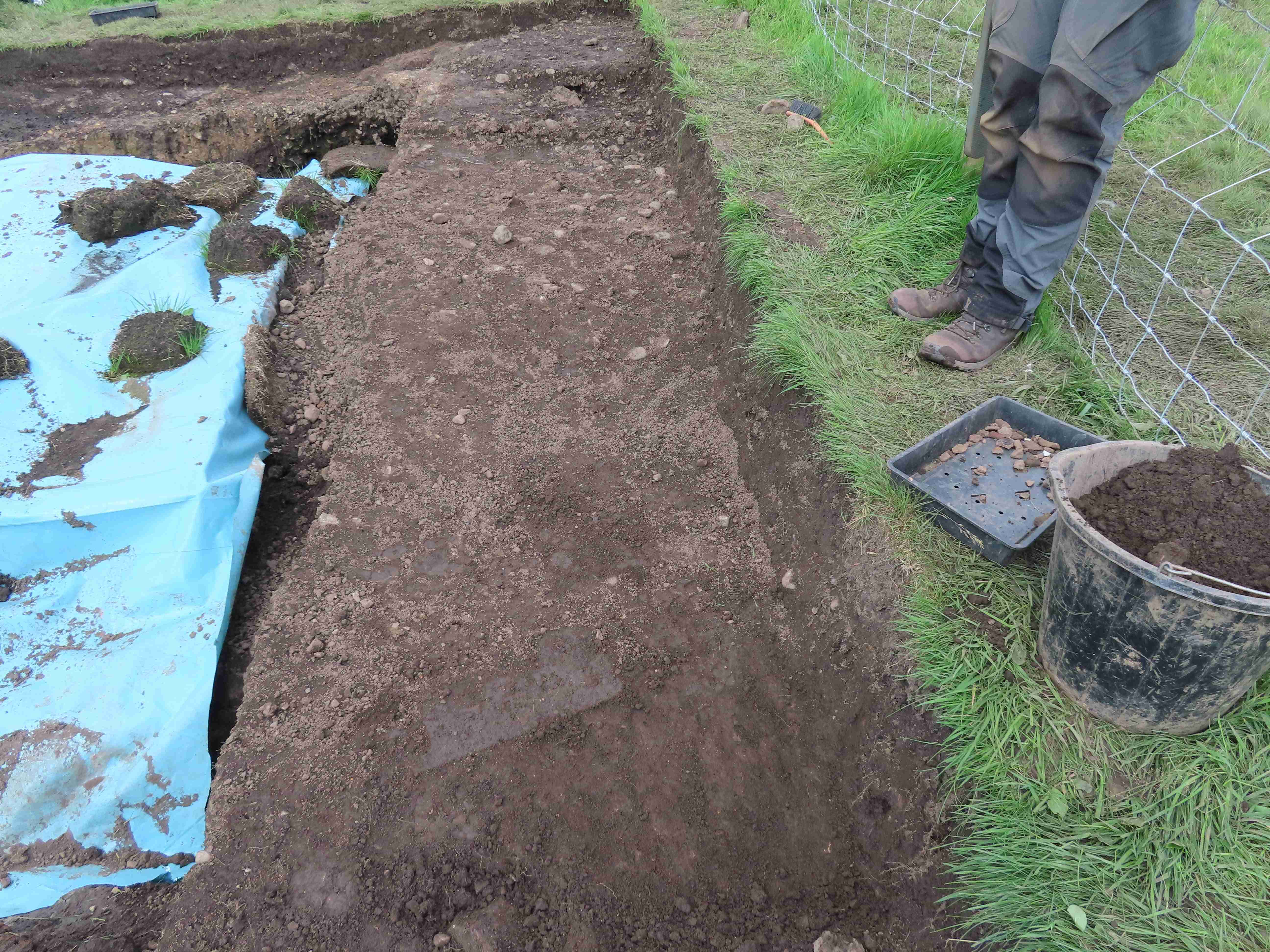
Photo 22 Aug No 3

Photo 22 Aug No 4
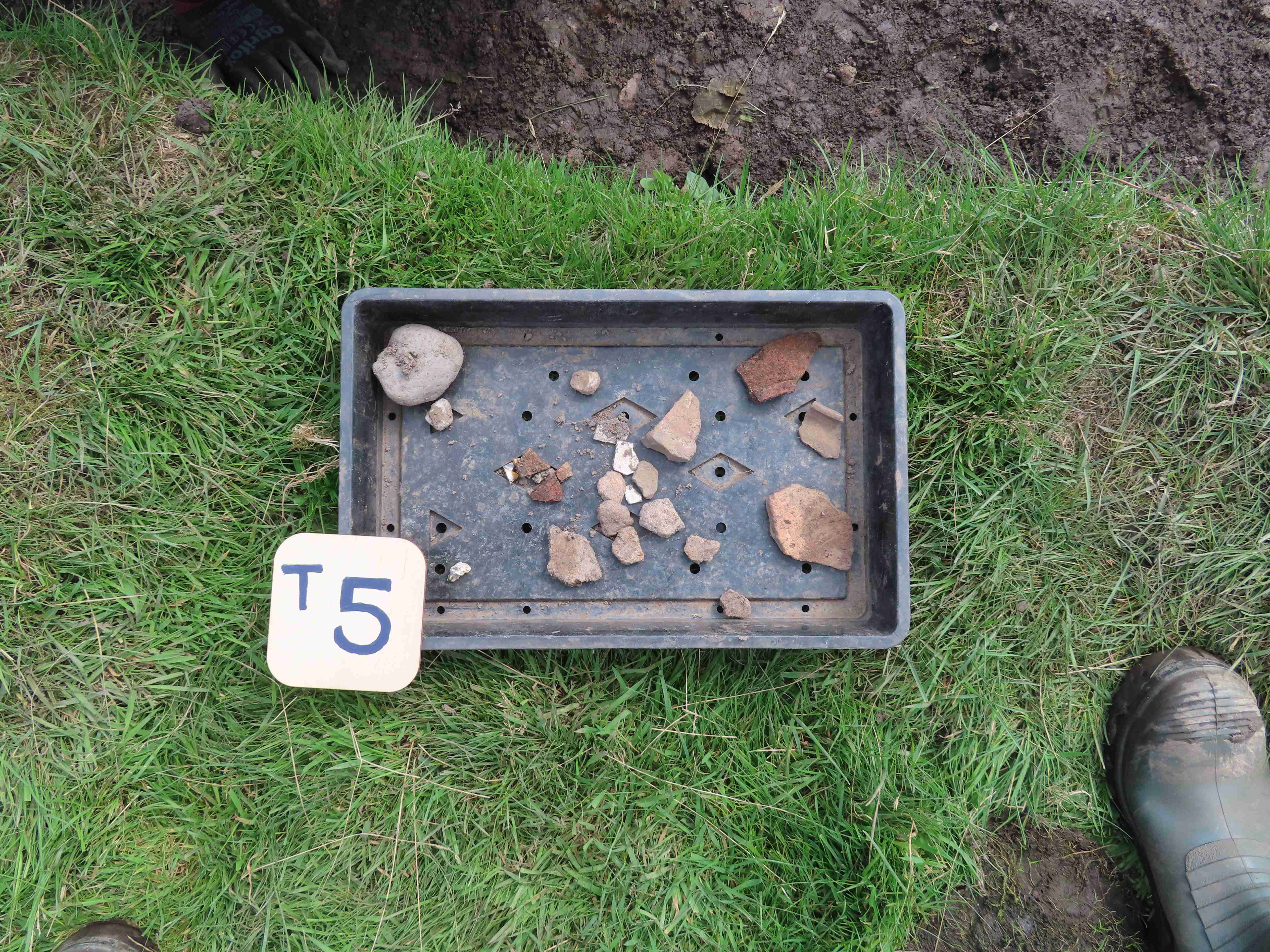
Photo 22 Aug No 5
Weather sunny and warm with cooling breeze
Trench 1
Southeast corner. Work continued removing the topsoil from the underlaying archaeology. At the moment it is still difficult to extrapolate what is happening in this section. There are a number of separate deposits of clay, some large stones and a large accumulation of what appears to be hammer scale mixed with clay. Due to the complexity of this section work is progressing in a controlled manner. Photos Aug 26 Photos 1 and 2.
A couple of meters to the north is the trench or drain which runs from east to west through the trench. This was excavated down to the natural and has proved to be very deep. There is still some speculation as to the purpose of this feature, due to it being deep and relatively narrow and it does not appear to be stone lined as a normal field drain would be. This item would collapse if the edges were stood on and, as it is so narrow, it is unlikely to have been stone lined. Even if it has stone coverings it would still be vulnerable to damage. Photo Aug 26 Photo 3. There is the added problem at the moment that water keeps seeping into the drain making further investigations difficult.
Eastern edge of the trench. Work on this section is particularly interesting as it is in the vicinity of where the furnace bellows would have been positioned. It is hoped that the archaeology of the bellows position will be sufficiently intact to indicate how and where the bellows may have been situated, the possible type and how they were operated. As this area is particularly important the excavation has to be carried out with precision and as a consequence takes time. Phone Aug 26 Photo 4.
North end of the trench. The large deposit of clay was removed and from the resultant steep slops it is obvious it was put there to level this particular section off, but is it contemporary with the furnace working? Photo Aug 26 Photo 5. At the end of the day a negative feature became apparent which has the same width as the trench or drain mentioned above. Is it another drain? If it is, then the purpose of two deep drains either side of a furnace is going to be subject of some very interesting discussions.
Trench 5
Although it is not as spectacular visually as trench 1 it is proving to be a spectacular location for finding medieval gritty ware pottery sherds Photo Aug 26 Photo 6. One very nice piece of lead glazed medieval pot was recovered. This is only about the third sherd of glazed pot to be recovered out of all the sherds. Photo Aug 26 Photo 7. Photo Aug 26 Photo 8 is of a large section of fractured flat stone with signs of heating, just visible where the stone goes under the side of the trench. If this proves to be a domestic fireplace it will help to raise the status of the site. On the other hand, it may be associated with another furnace or prove to be completely inconsequential.
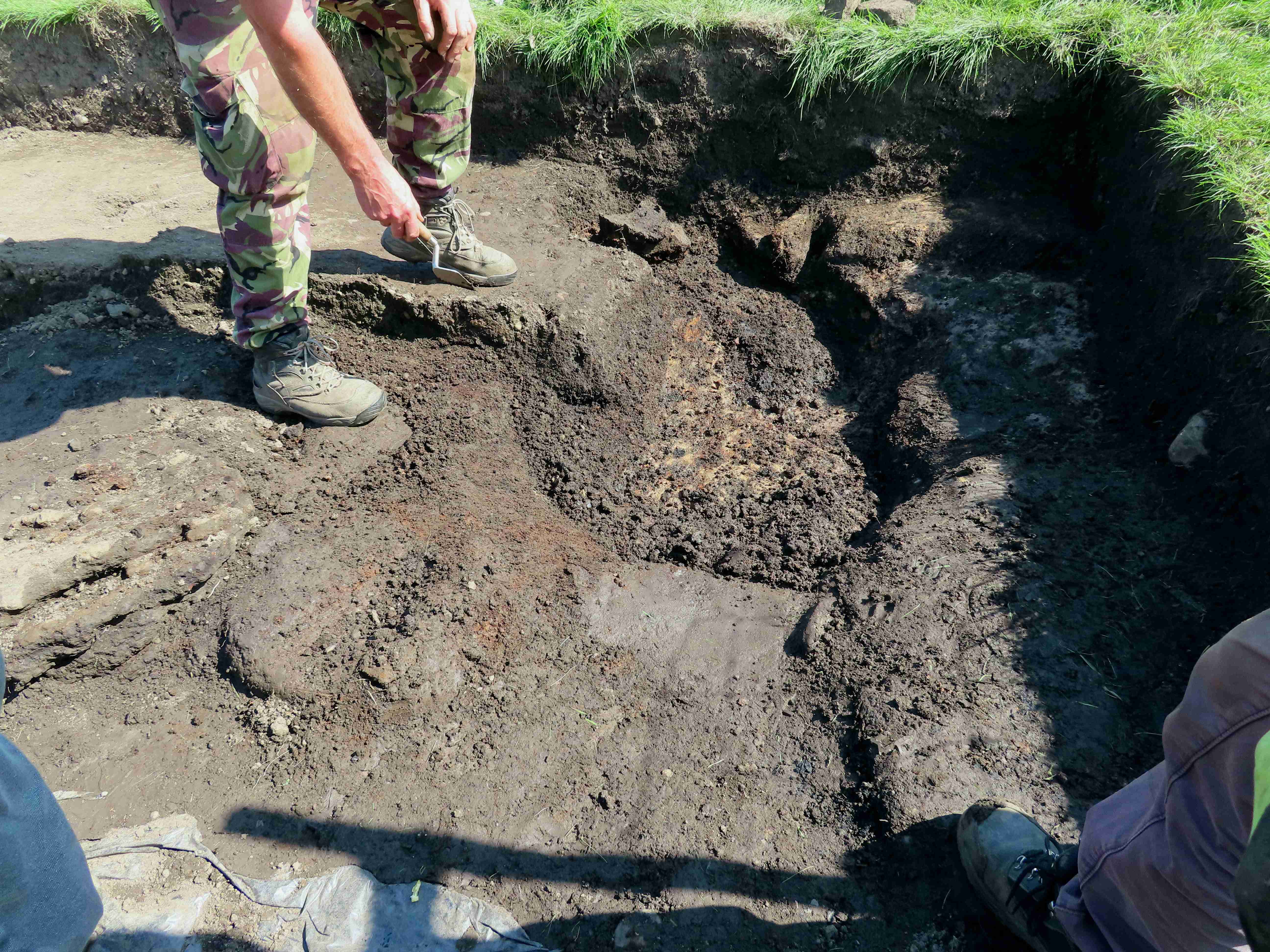
August 26th Photo 1

August 26th Photo 2
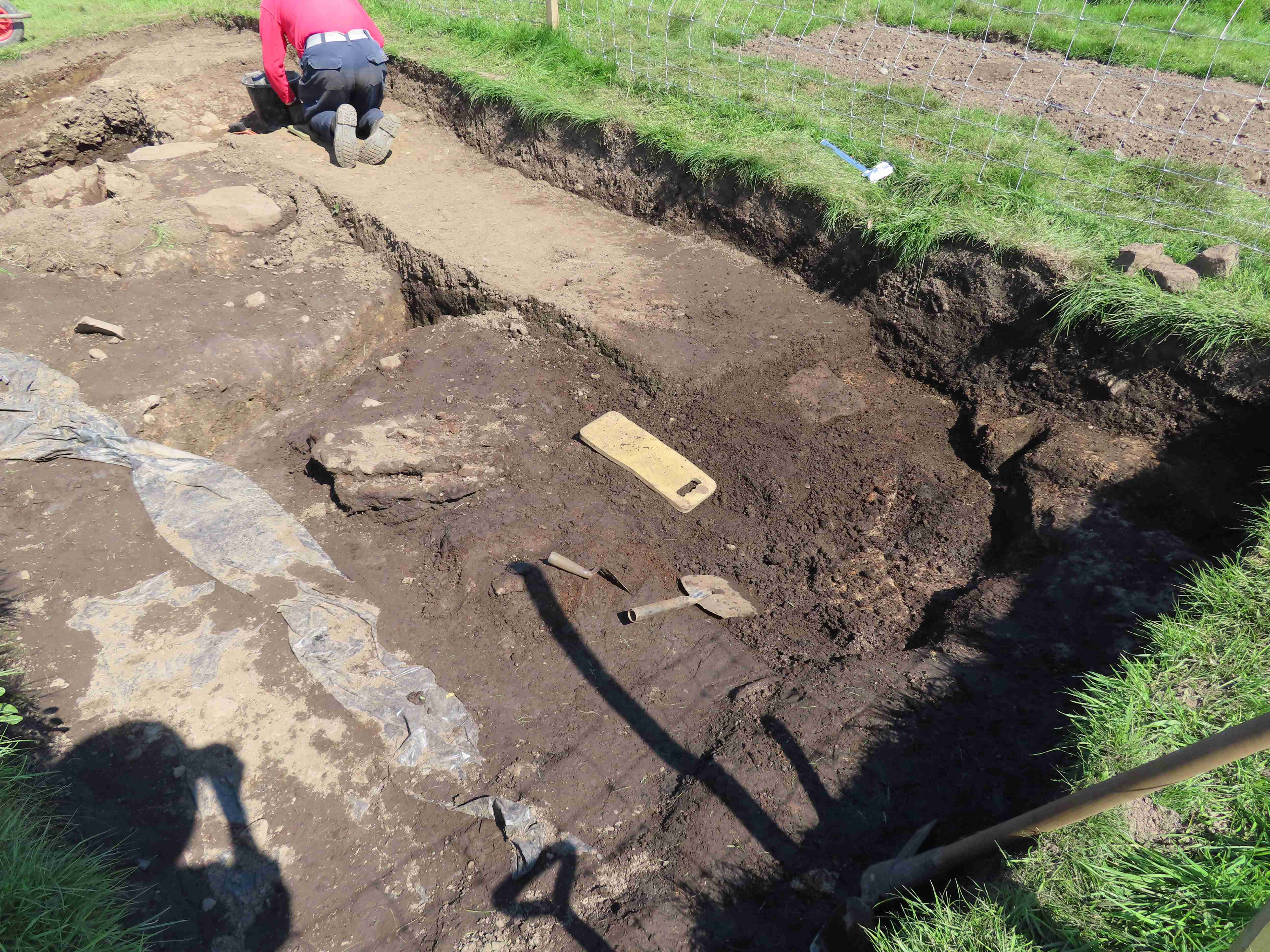
August 26th Photo 3
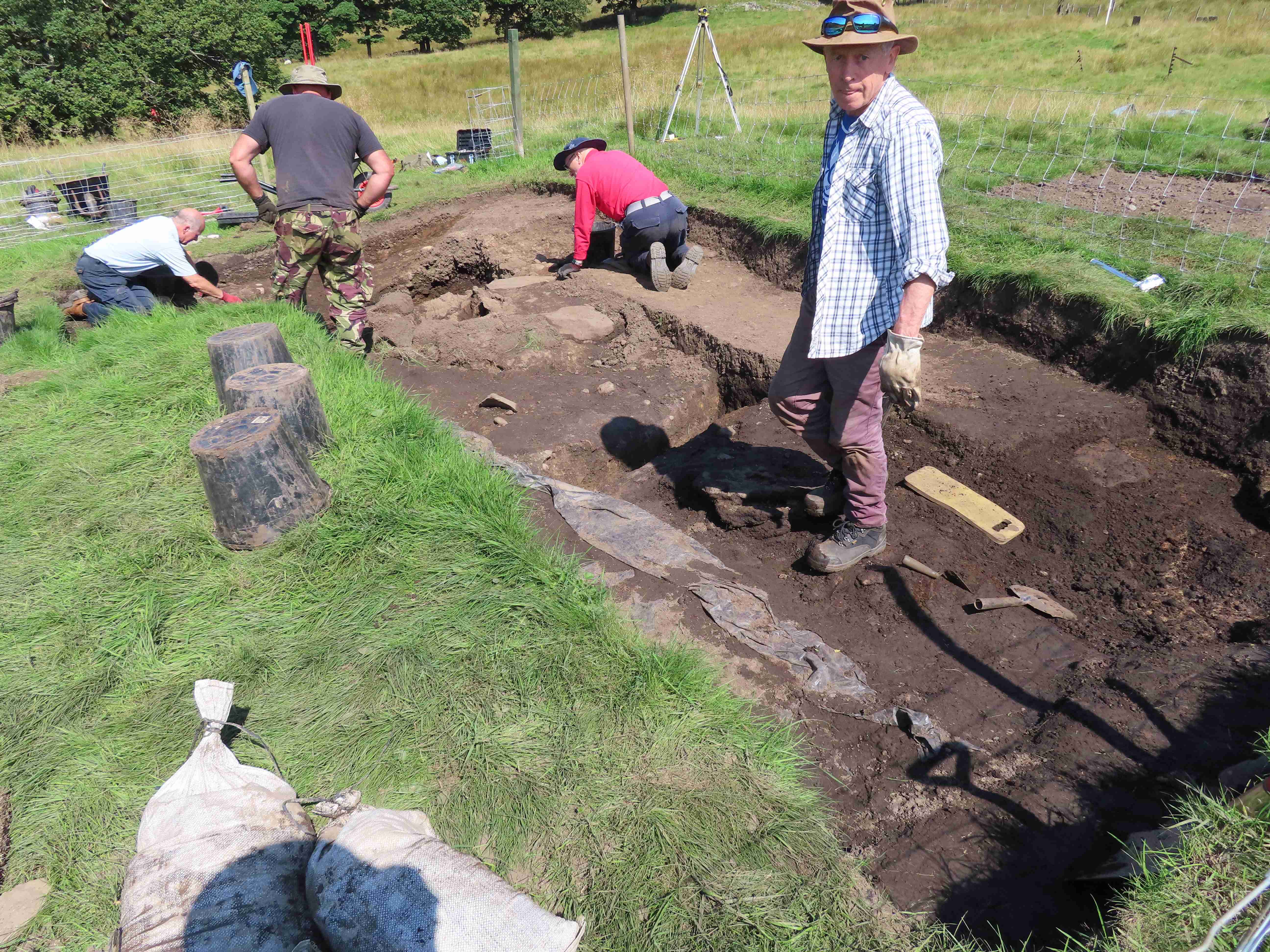
August 26th Photo 4

August 26th Photo 5
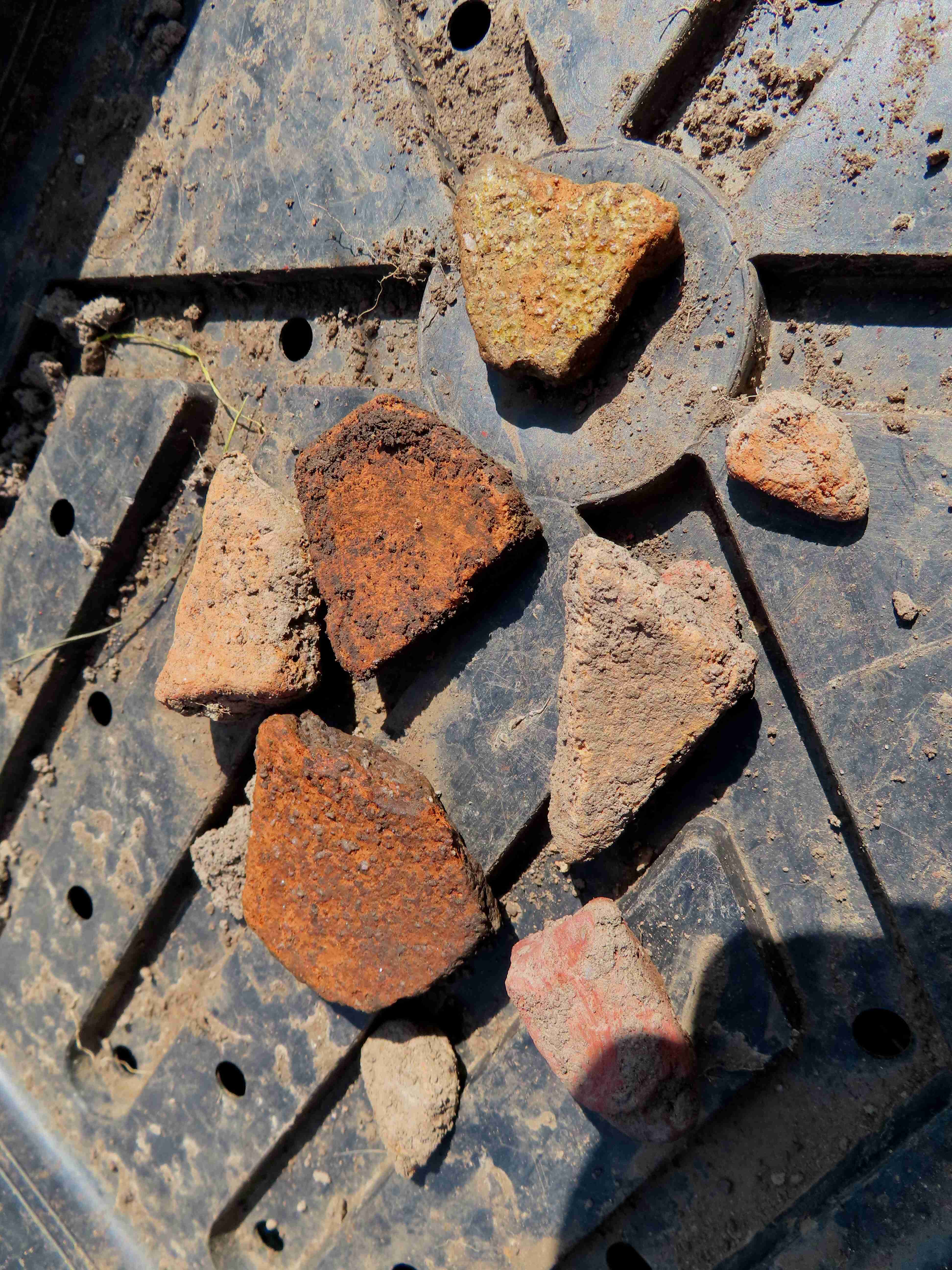
August 26th Photo 6
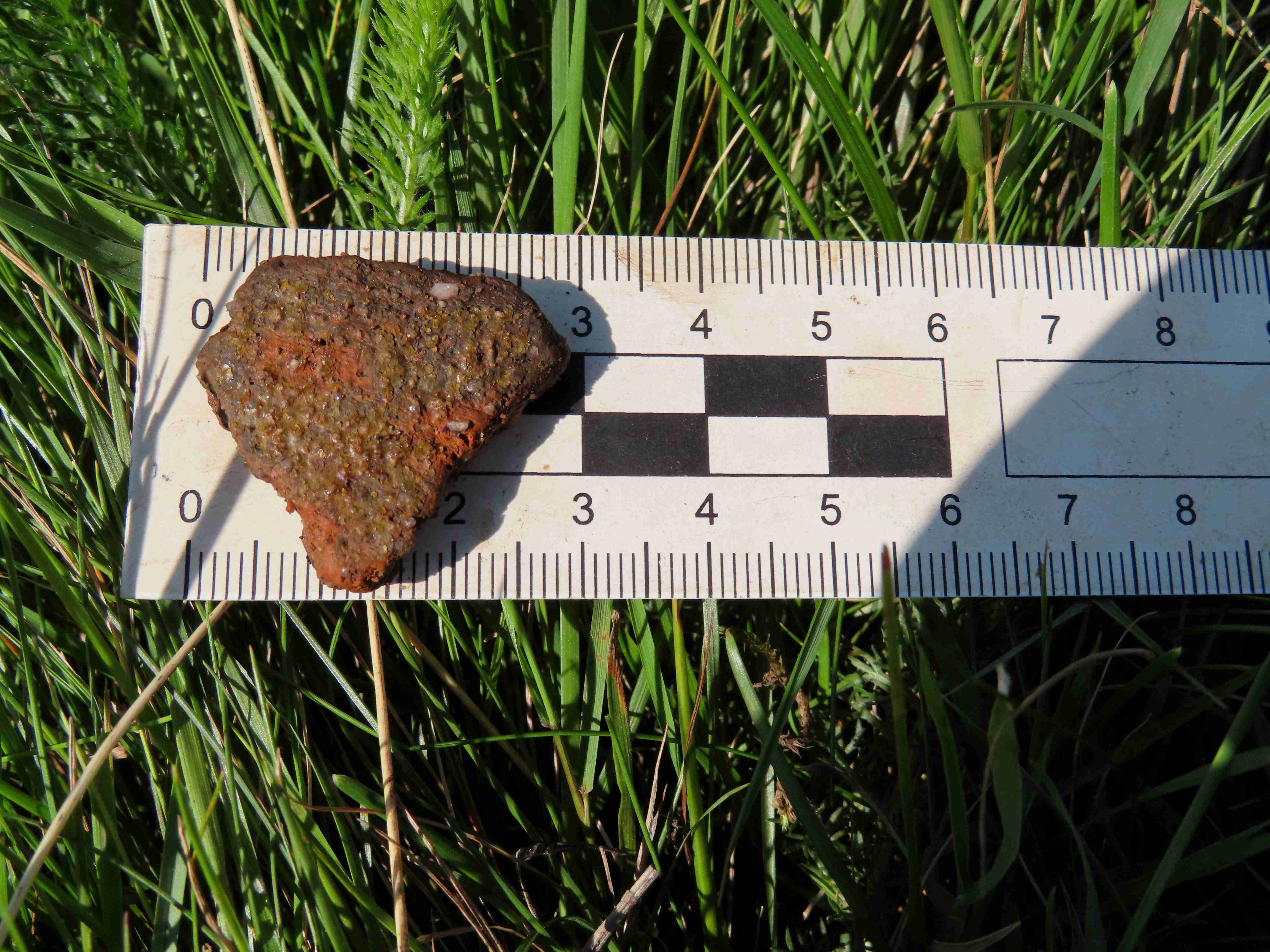
August 26th Photo 7
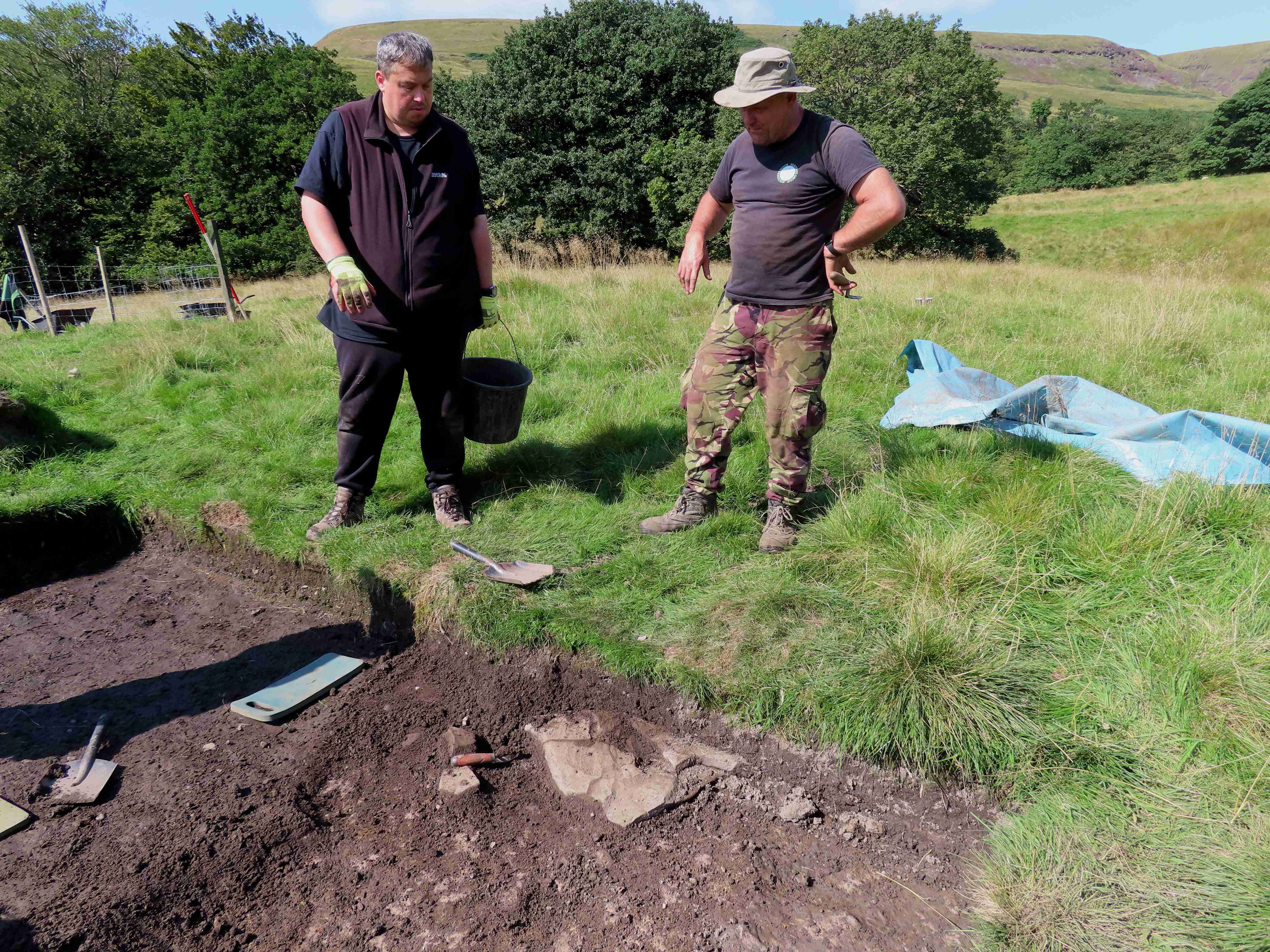
August 26th Photo 8
HMHG dig report Saturday and Sunday 28th and 29th August 2021
Weather sunny and warm, no rain
Trench 1
There have been some very interesting developments over the two days.
The backfill of the deep trench to the south of the bloomery was found to contain an infilled post hole. Photo Aug 29 No 1. This obviously means that the trench would have been decommissioned prior to the post hole being dug. Continued excavation of the topsoil and clay to the extension east and north has revealed that the trench curves around behind the bloomery structure. Photo Aug 29 No 2.
The negative feature to the north of the bloomery, uncovered on Thursday 26th August and which appeared to have the same open dimensions as the south trench, was proven to be another ditch. This ditch extends eastwards and southwards into the eastern extension to trench 1 and joins up to the southern trench to the east of the bloomery. Photo Aug 29 No 3. It is interesting to note the southern trench is relatively neatly cut while the southern trench is ragged. Some stones from the bloomery have fallen into the southern trench.
From current observations, now that the trench arrangement has been revealed, it would appear the bellows position is in a very well-preserved state of repair. There are no signs of any major disruption to the eastern side of the bloomery where the bellows would have been sited. Photo Aug 29 No. 4.
The purpose of the trench is currently unknown. Studying documentation and information relating to other bloomery sites in the UK may provide an answer.
Trench 4
Continued excavation commenced in the southwest corner of the trench where previous observations had indicated something of interest may exist. What was uncovered was a patch of very heavily baked ground, indicating that this area had been subjected to very high temperatures. Photo Aug 29 No. 5. Initially, before the size of the area was completely revealed, it was suspected it may be where the iron ore was prepared by roasting in preparation to feeding into the bloomery. Unfortunately, once the extent of the feature was revealed this theory had to be discounted. Current thinking is that it has domestic origins.
Over the two days only a few pieces of medieval pottery were recovered; two of the more impressive pair of pieces are shown in Photo Aug 29 Photo 6.
Trench 5
During Saturday morning excavations a large number of medieval gritty wear pottery sherds were recovered, mainly from the southern side of the trench; Photo Aug 28 Photo 7. Interestingly most of the sherds in trench 4 were from the north side of the trench, while in trench 5 the southern side produced the pottery. This would perhaps indicate that there will be more pottery in the 2 metre strip between the two trenches.
The large flat stone uncovered on Thursday 26th, with signs of heating on it was uncovered by excavating a 1 metre by 1 metre extension to the trench around it. Photo Aug 29 Photo 8. Unfortunately, the stone was not part of a domestic fire or bloomery. It was a solitary stone sitting on the natural surface; an unusual feature as nothing like this has previously been excavated on the site. Its purpose remains unknown. It is possible that a similar stone may be found later and provide a clue to their purpose.
Work on this trench is now complete, so has been closed down and will be backfilled.
Interesting finds from trench 1 were a worked flint and a buckle. Photos Aug 29 Photo No 9
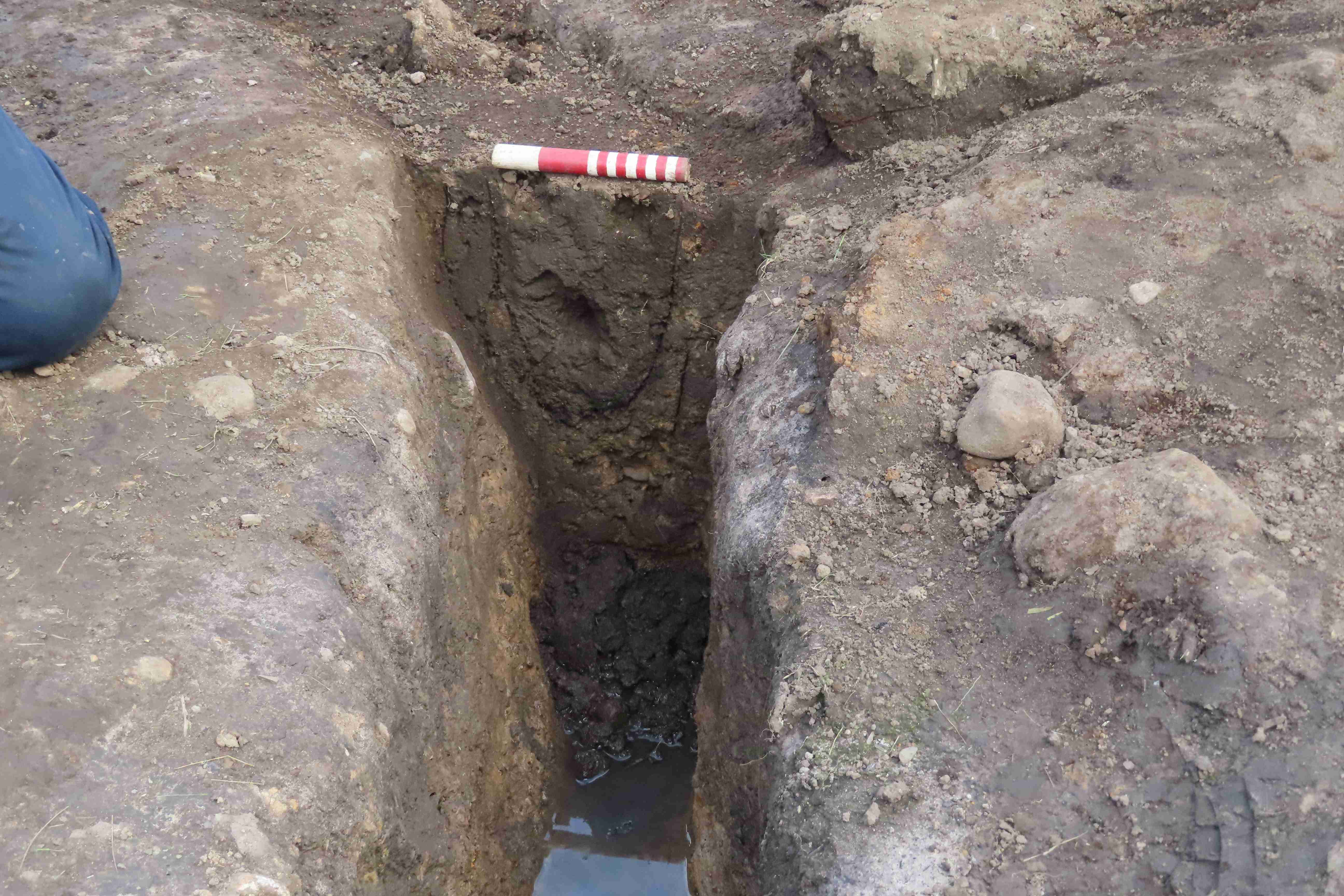
Aug 29 No 1
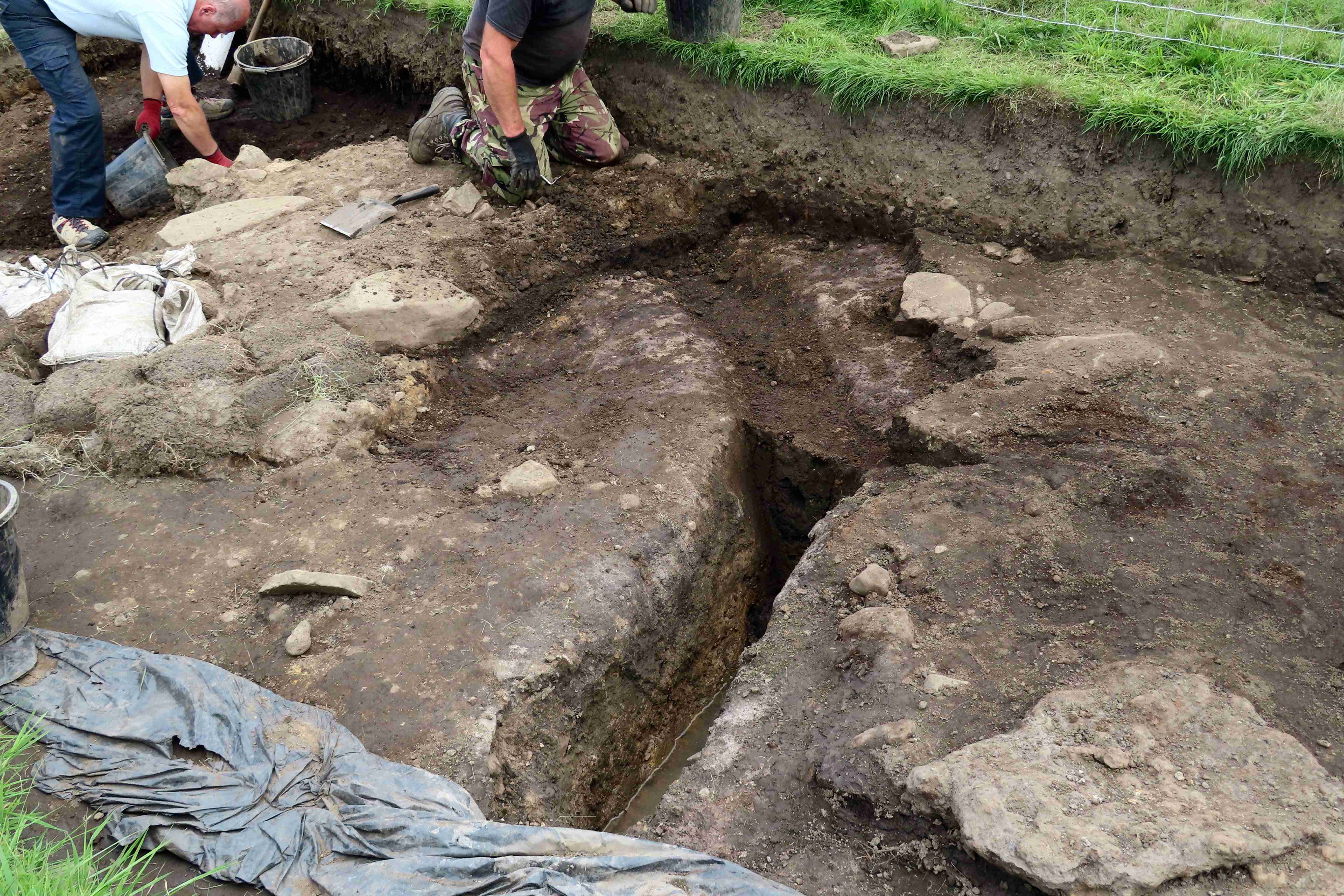
Aug 29 No 2
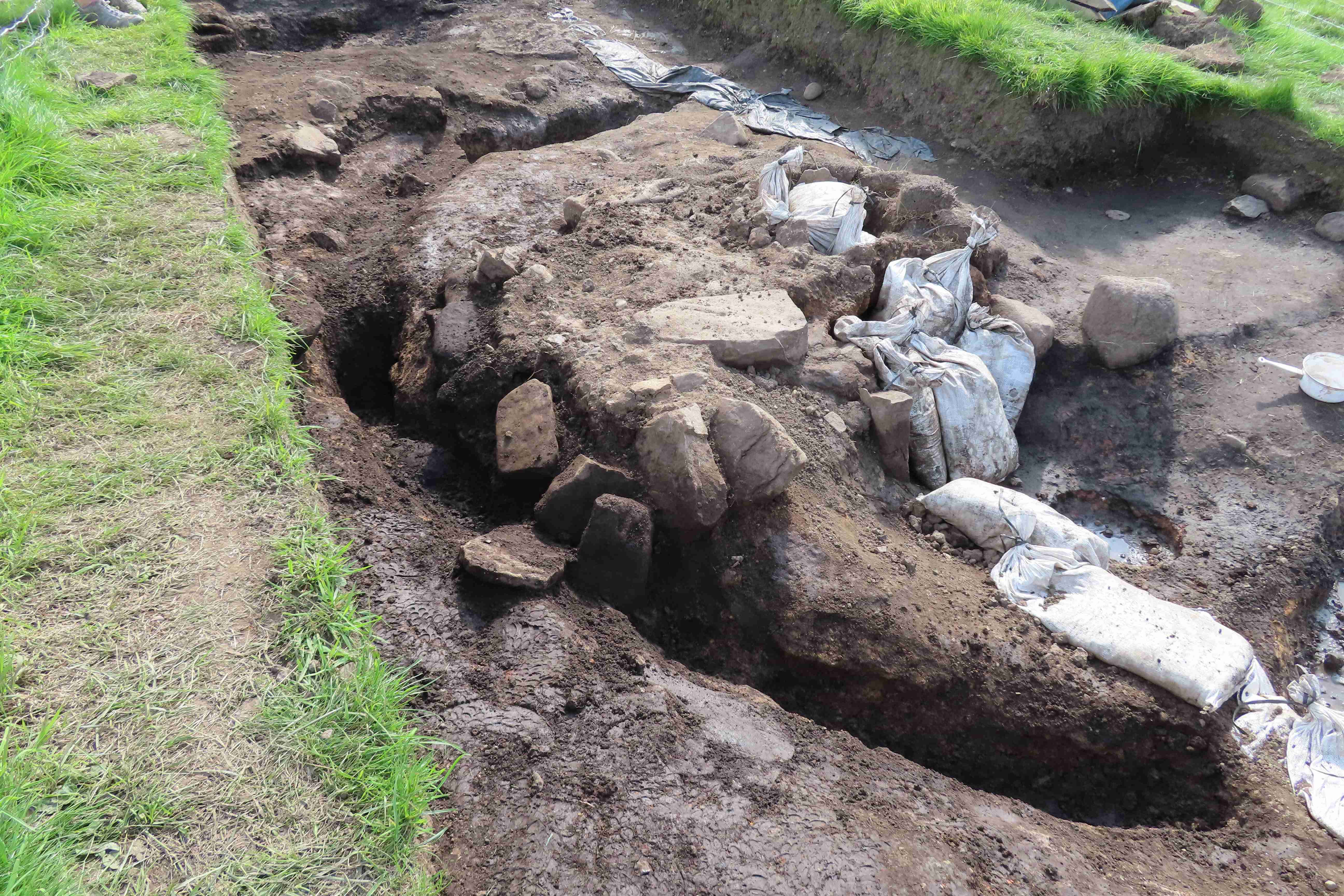
Aug 29 No 3
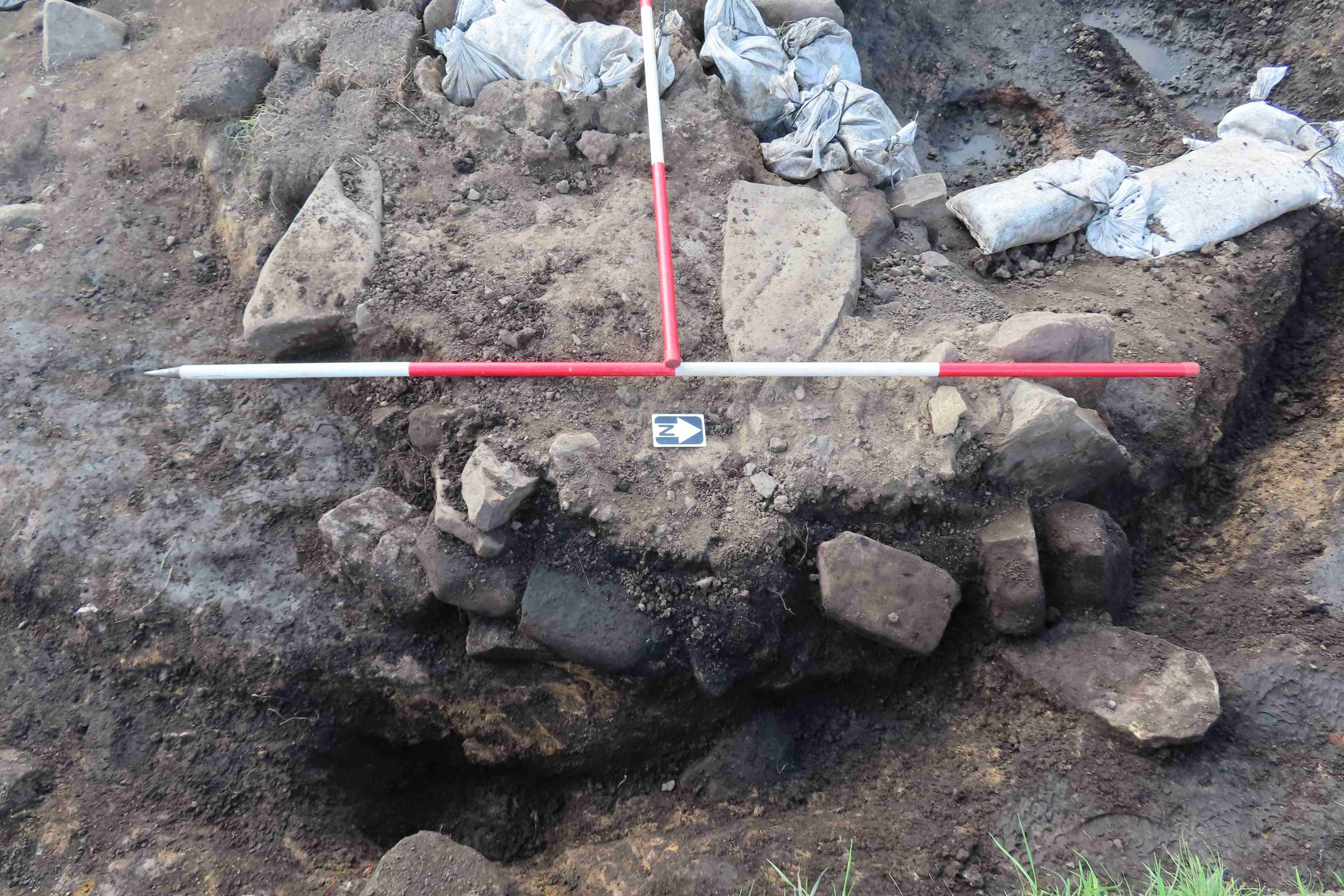
Aug 29 No 4
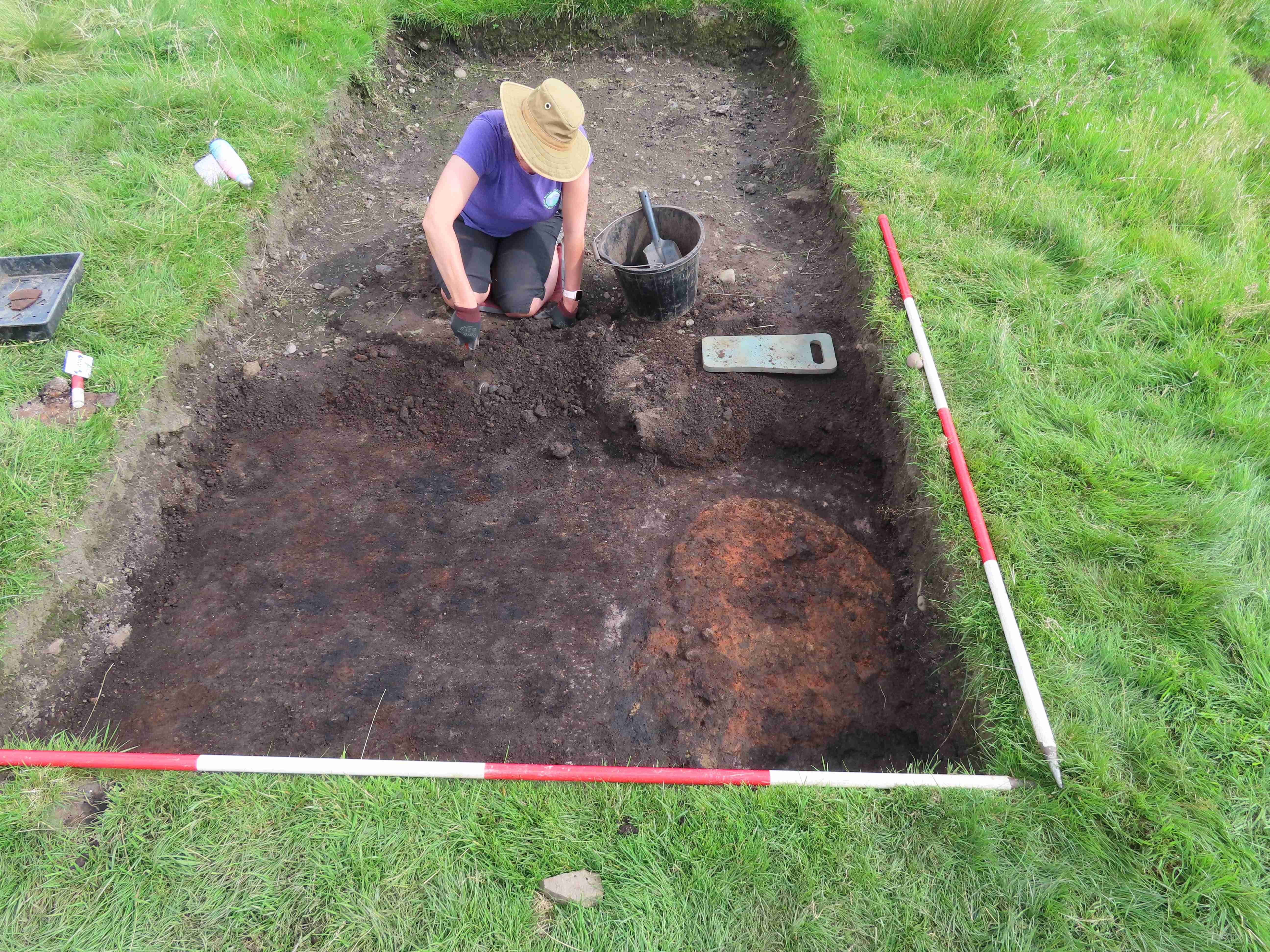
Aug 29 No 5
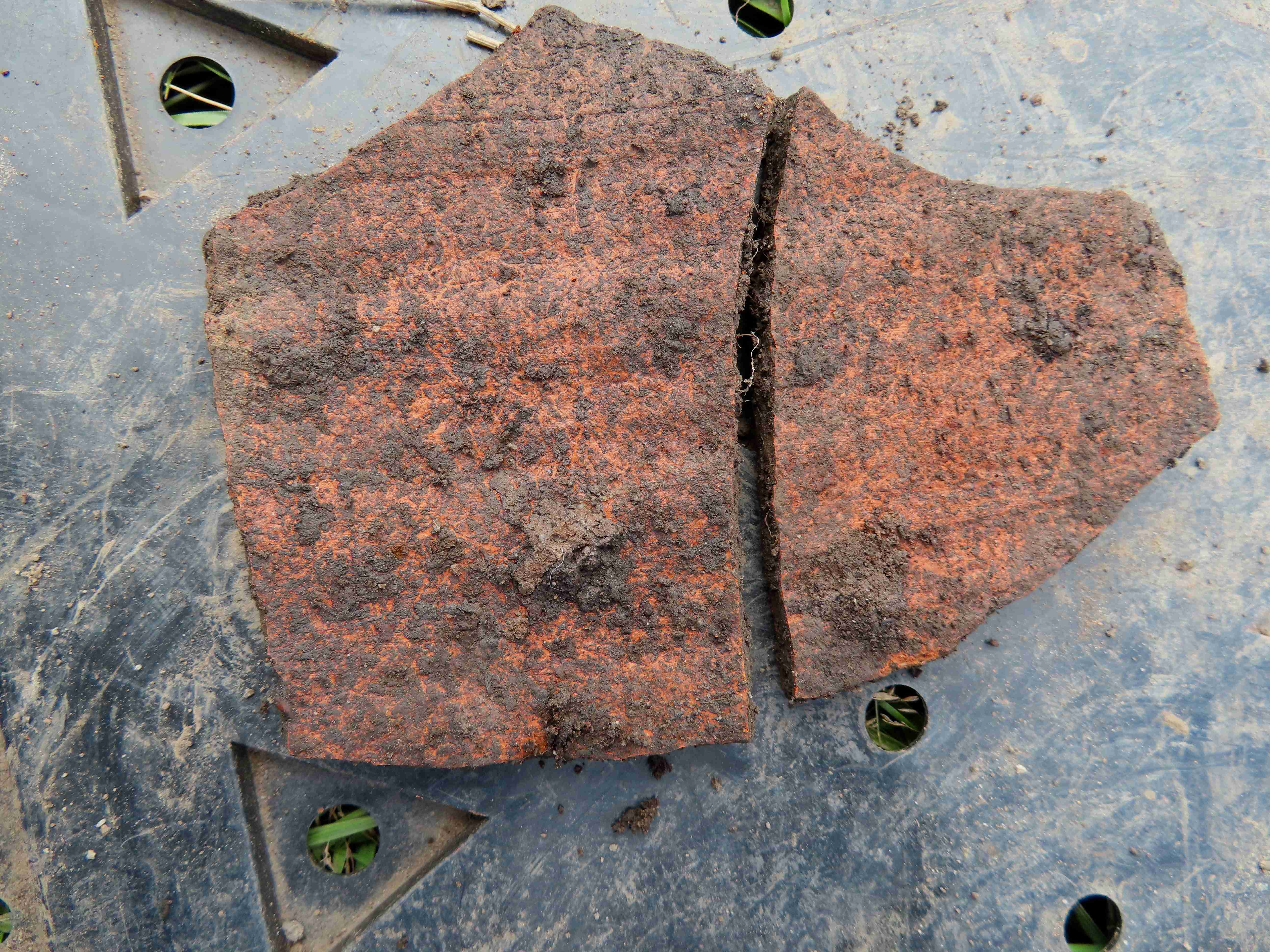
Aug 29 No 6

Aug 29 No 7
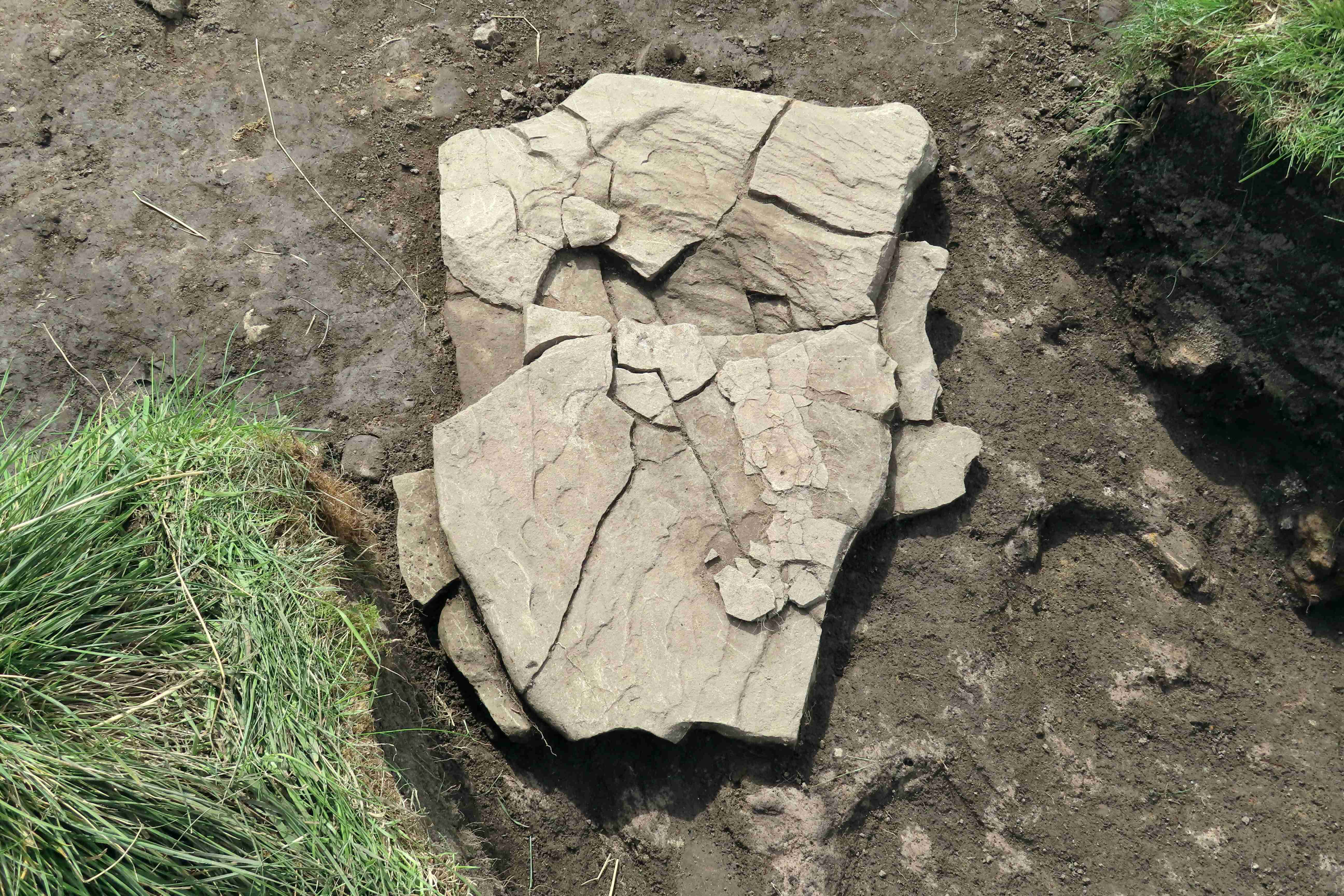
Aug 29 No 8

Aug 29 No 9
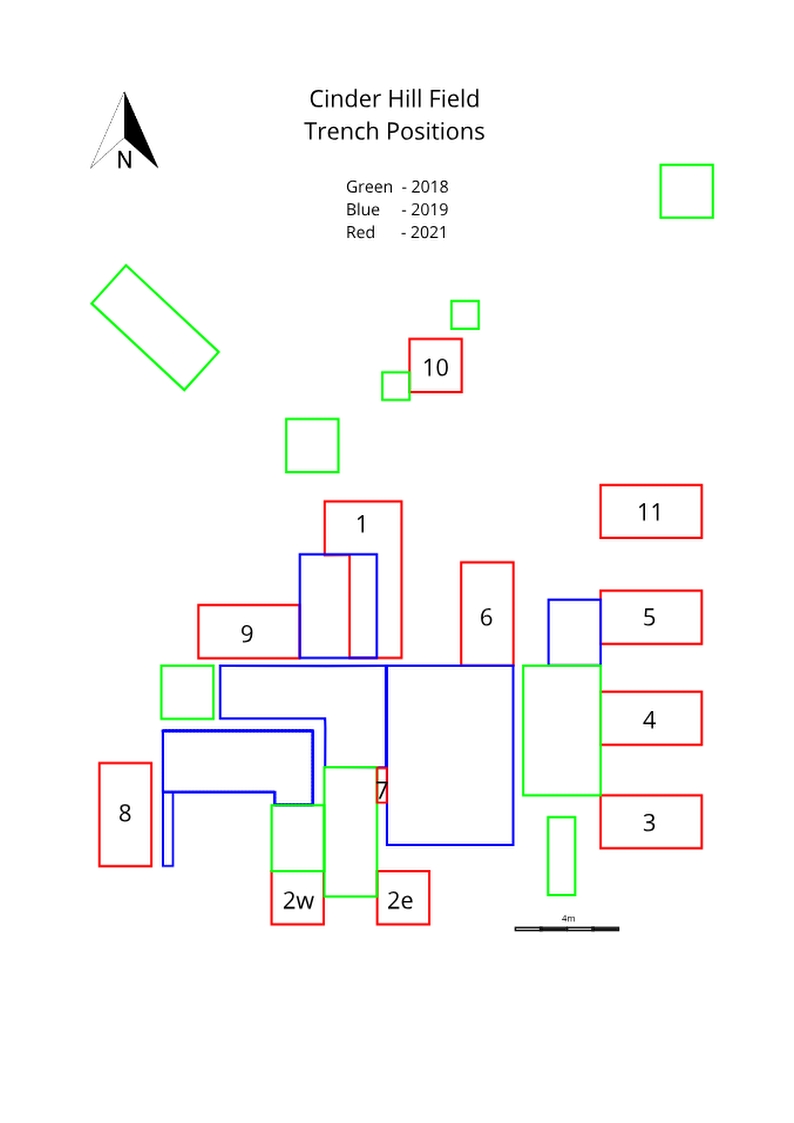
Trench positions
Weather. Overcast and cool, no rain
Ian Miller, Assistant Director, Salford Archaeology visited the dig for a couple of hours in the morning. He and Neil discussed the current archaeology work on Cinder Hill, with particular interest being paid to the bloomery and the trench arrangements in trench 1. Ian advised that he had not seen examples of a furnace with a trench arrangement before so was unable to offer an explanation. He did, however, say that he would make enquiries with colleges to try and source some relevant information for us.
Trench 1.
Work continued in the southern end of the trench on the clay lined circular depression which contains some unusually shaped clay deposits. By the end of the day the full extent of the depression and contents were visible, but unfortunately no one is any the wiser as to the purpose of the depression or clay deposits. Photo 23 Sept No 1. There is a strong possibility, however, that additional related archaeology exists under the wall of the trench extending eastwards. This will have to be investigated in 2022.
South end trench 1: apparent post hole.
The apparent post hole which was evident in this trench was further investigated. Initially, after the removing of most of the infill, it looked to be a possible post hole or more probably a stake hole. Photo 19 Sept No 2. Unfortunately, after removing the remainder of the infill, the depression bore no conventional resemblance to either a post or stake hole. Photo 19 Sept No 3.
Northern end trench 1
Initially this trench appeared to be very poorly constructed in that the sides of the trench were very irregular compared to the southern trench. It soon became apparent that the trench was as well constructed as its counterpart and appears to be as deep. Photo 23 Sept No 4. Both trenches will need to be fully excavated to the point where they join - in the vicinity of the east wall of the trench behind the bloomery - before any further theories as to their purpose can be considered.
Large excavated hole at the west end of northern trench.
The large depression at the end of the northern trench has still not been successfully explained. There is a possibility that the archaeology associated with this item extends in a westerly direction under the west wall of the trench. Time may remain this season to extend the trench by a short amount to test this hypothesis. If not, it will have to be tackled next season. Photo 23 Sept No 5
Trench 3
Work continued excavating the trench down to the natural. A number of small sherds of medieval pottery were recovered. Photo 23 Sept No 6. Another good day’s work on this trench should see it completed. Photo 23 Sept No 7
Additional work involved continuing to backfill trench 5 and re turfing trench 6.
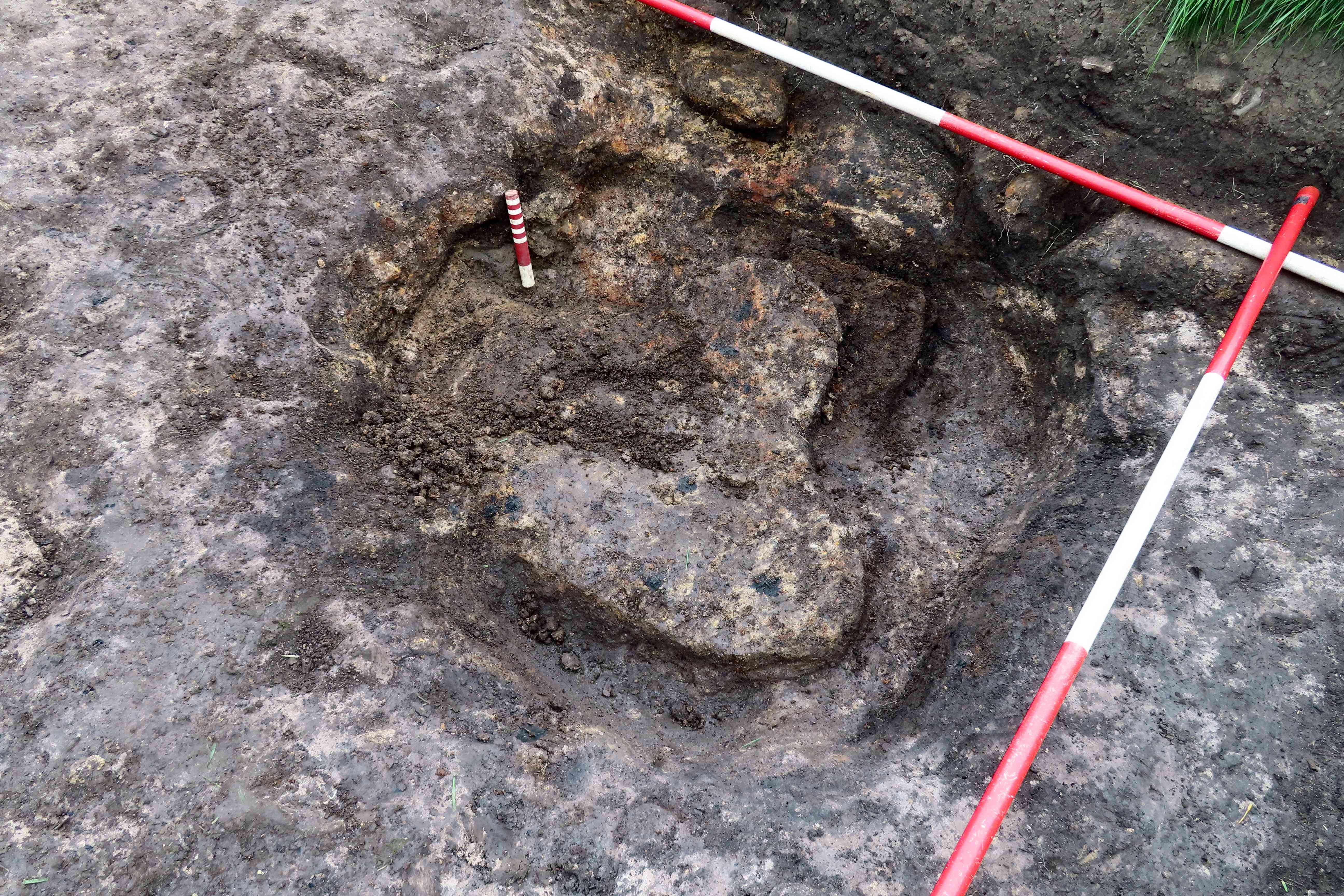
23 Sept No. 1

23 Sept No. 2
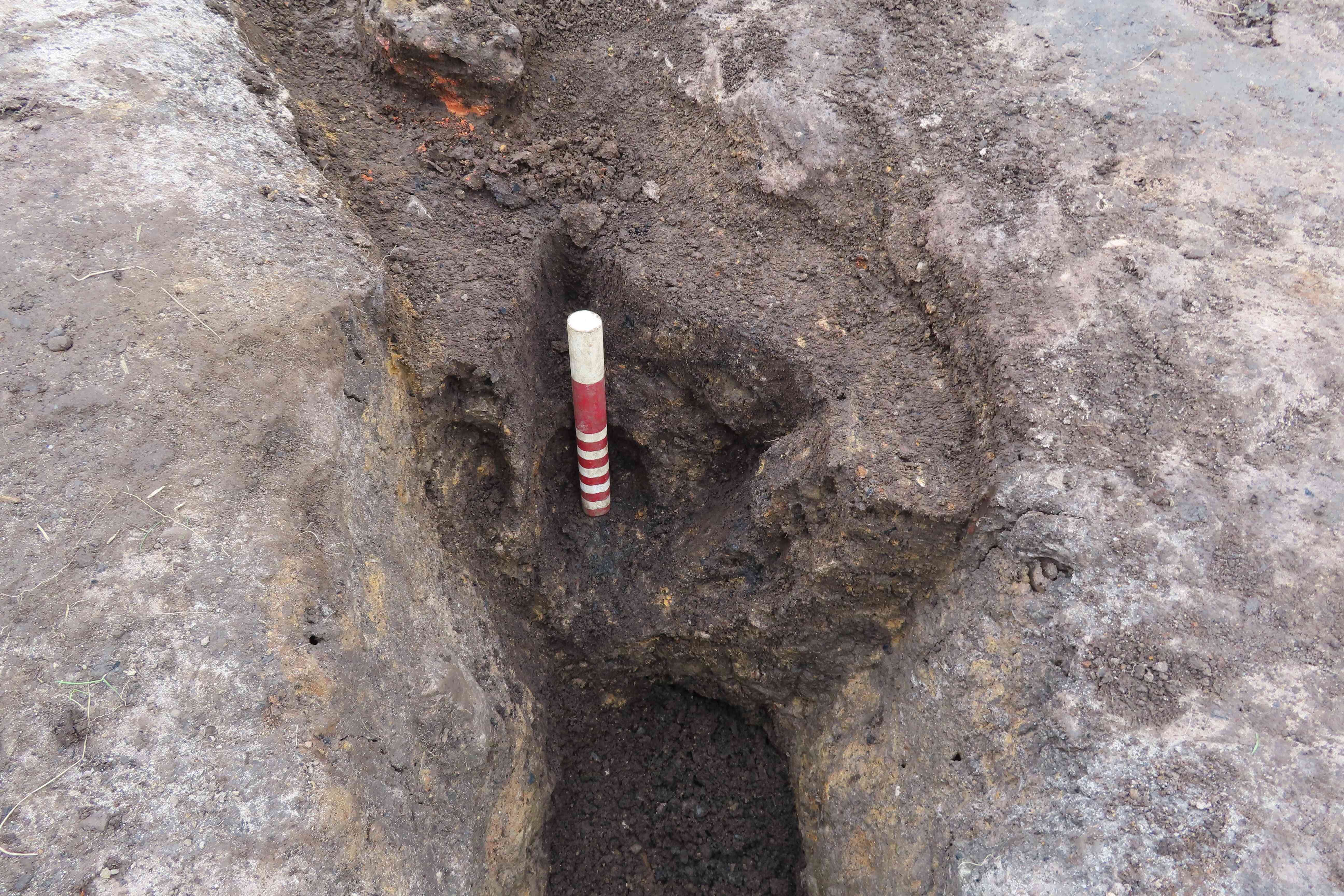
23 Sept No. 3
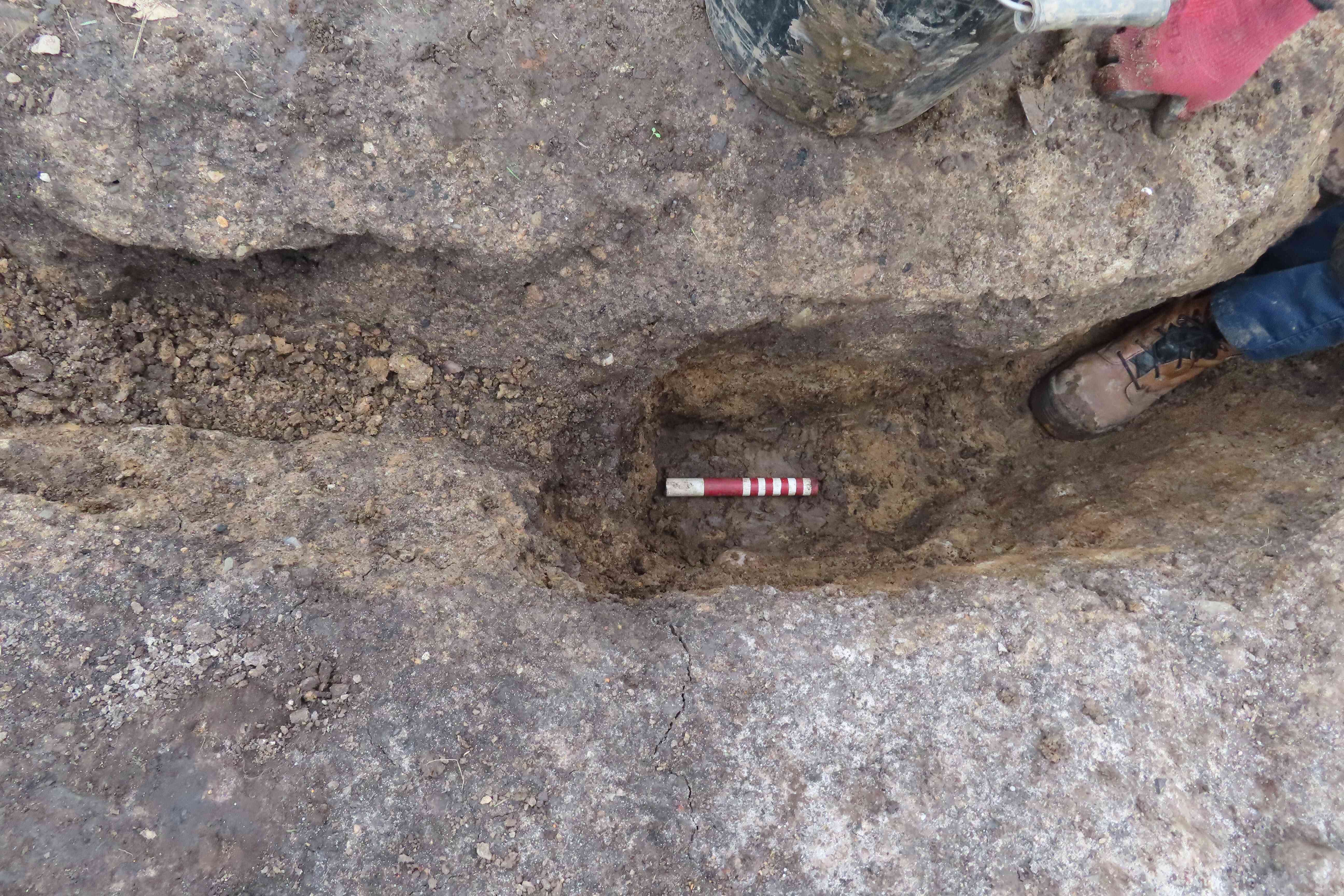
23 Sept No. 4
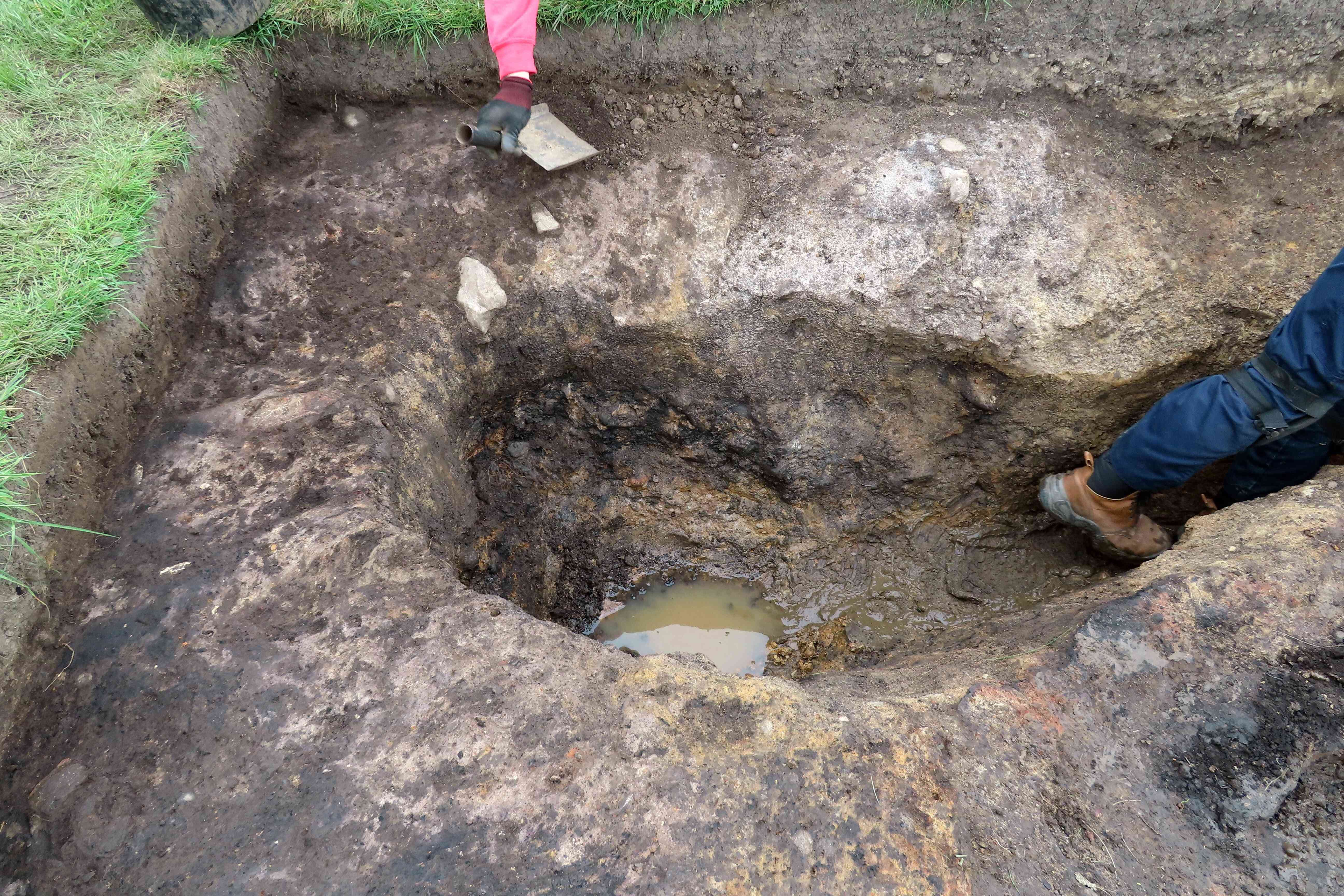
23 Sept No. 5
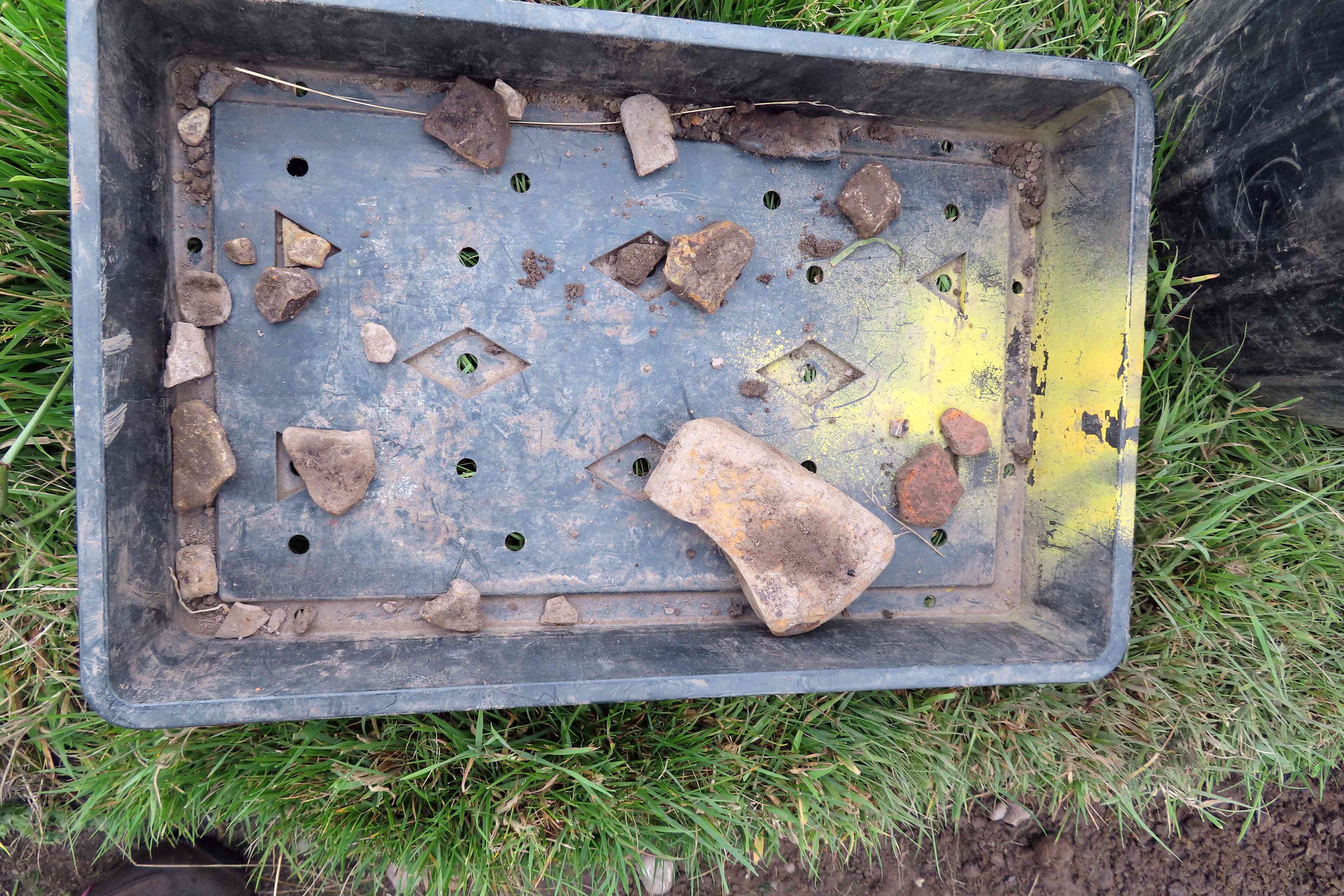
23 Sept No. 6
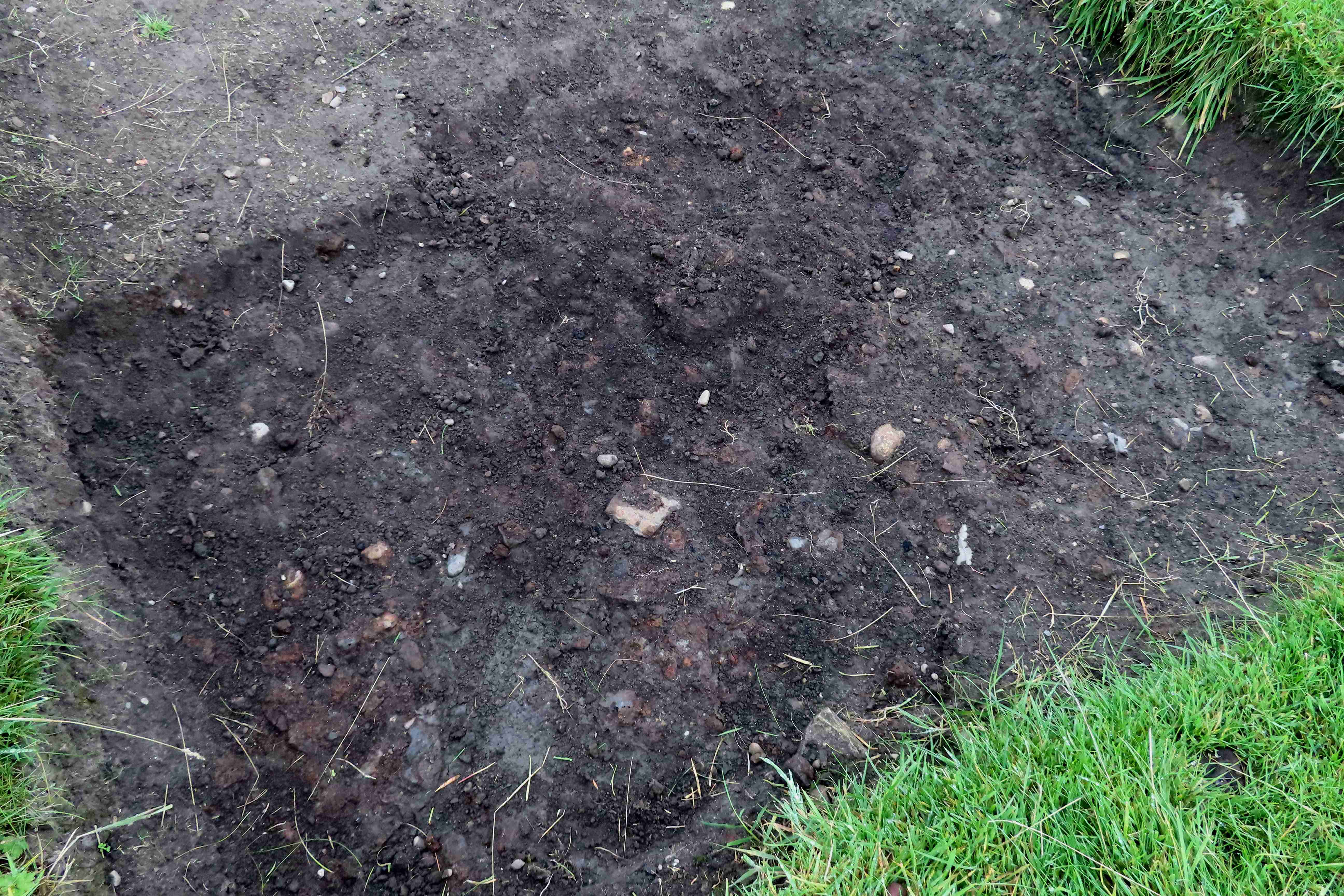
23 Sept No. 7
Weather, overcast with light rain showers
Trench 1
As Neil had a lot of recording to do in the trench the amount of work carried out in the trench was restricted.
Southern end. Work continued in the southern end of the trench on the clay lined circular depression which contains some unusually shaped clay deposits. After recording, the clay deposits were removed together with the few remnants of loamy surface soil. What was left was a very distinctive circular depression with a partial lip on the western perimeter. This lip may be found to exist around the remainder of the depression once it has been cleaned. Photo Sep 25 No 1. The reddish brown clumped material in the photo is granular in texture but quite fragile; pieces can easily be broken off. At the moment the constituents of the material are unknown, although it could be something like rusted hammer scale mixed with clay. Photo Sept 25 No 2. The purpose of the depression is currently unknown.
The other work carried out in the trench was to excavate the highest point in the ‘U’ shaped trench surrounding the bloomery. The purpose was to see if there was an inlet of some type which could possibly have channelled water into the ‘U’ drain. This supposition was subsequently dashed, as no inlet of any description was located. Photo 25 Sept No 3. This just makes the purpose of the ditch more difficult to determine, if it ever will be.
The rain made Neil’s job of recording very difficult at times. Photo 25 Sep No 4 is an example of the lengths to which the plebs have to go to ensure the gaffer gets his drawings completed.
Trench 3
The work on this trench is taking longer than anticipated. The southwestern section of the trench consists of deposits of very hard layers of slag which are difficult and time consuming to clean. The eastern and northern sections of the trench, at the moment, clears down to a clay surface intermingled with a variety of stones and pieces of slag. Unfortunately, there is a strong possibility that the slag layer runs under this clay layer so the clearing of the trench may take a lot longer than initially anticipated. Photo 25 Sep No 5.
The dig planned for Sunday the 26th had to be cancelled due to the Ironman competition making travelling to the army camp virtually impossible.
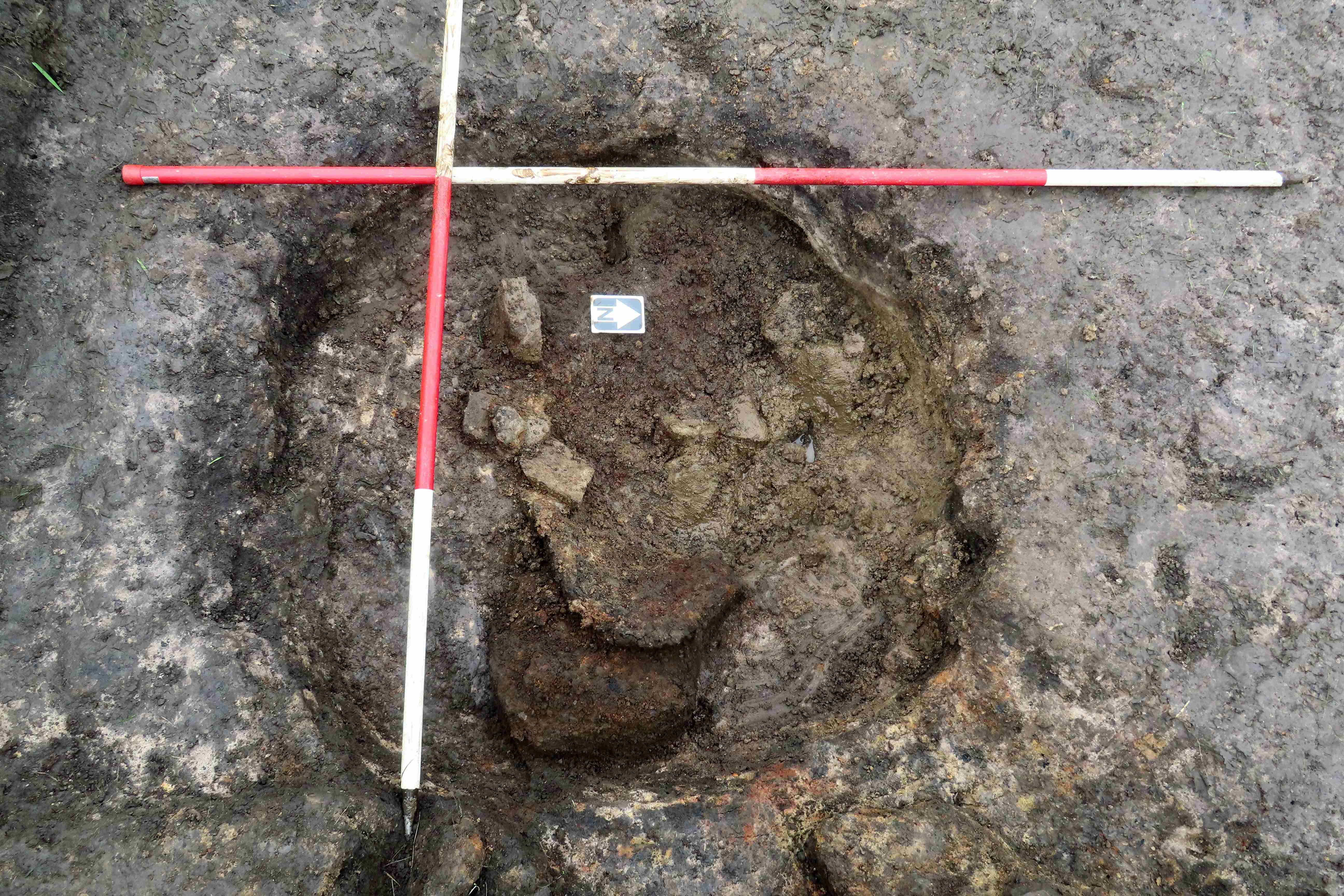
Sept 25 No. 1
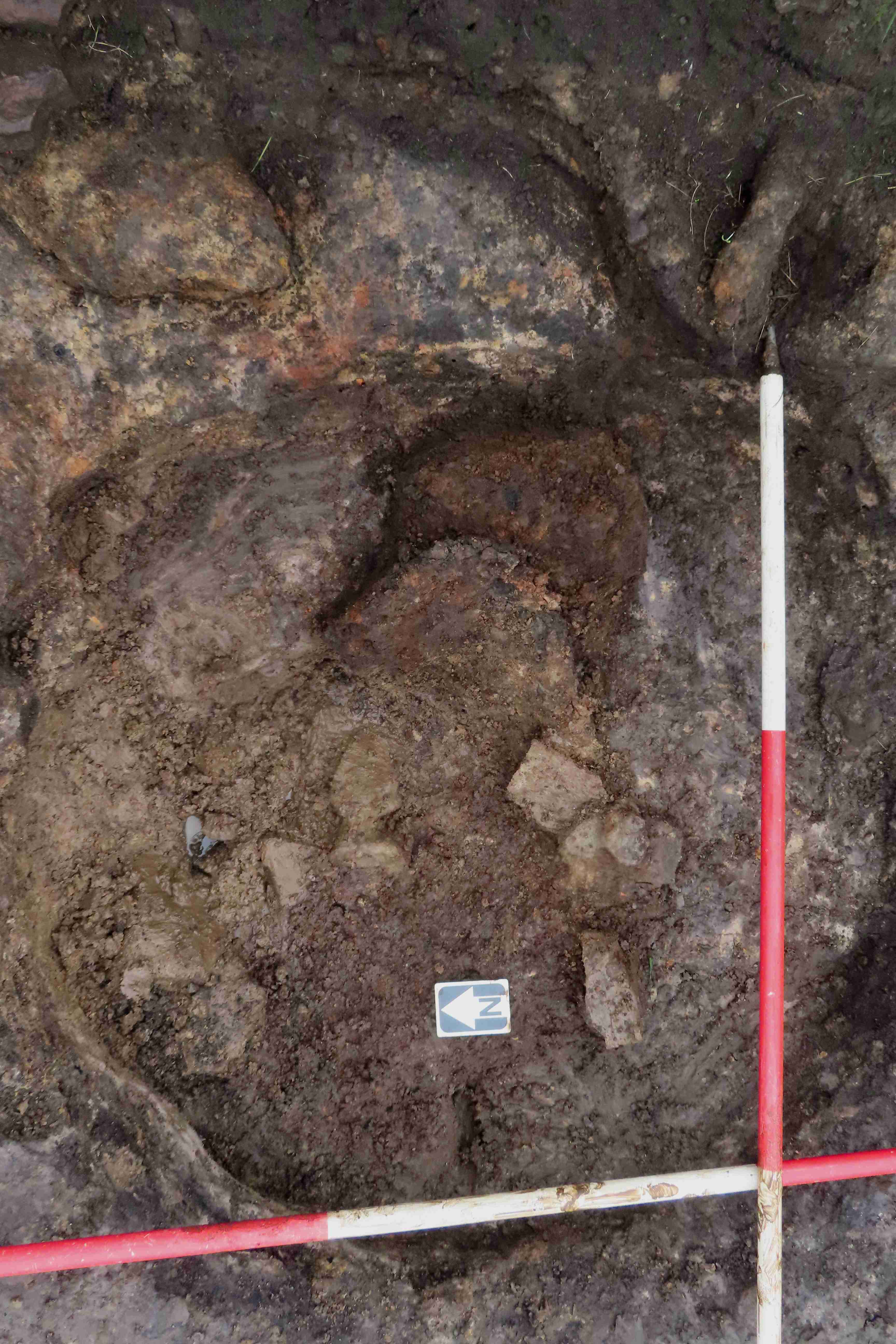
Sept 25 No. 2
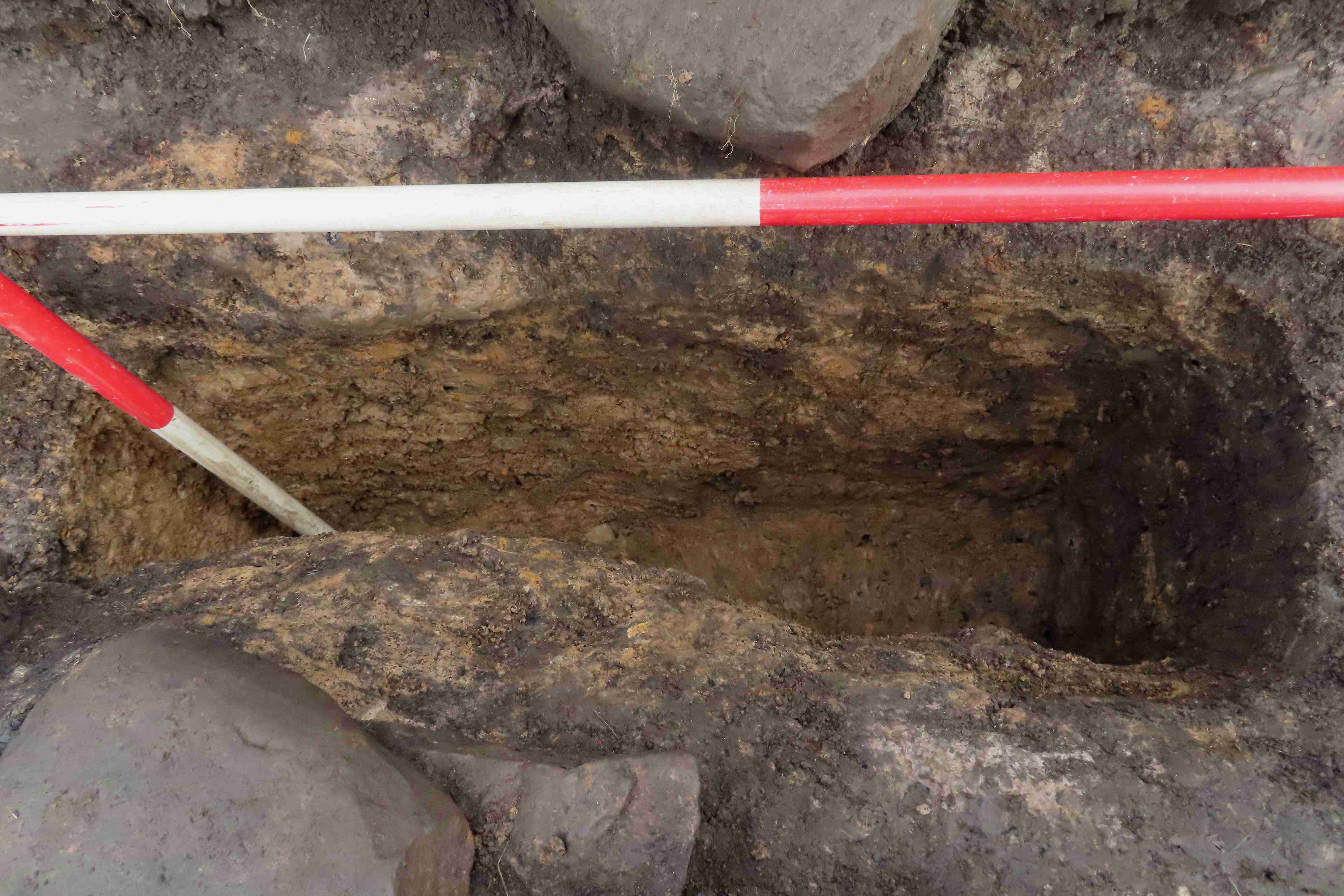
Sept 25 No. 3
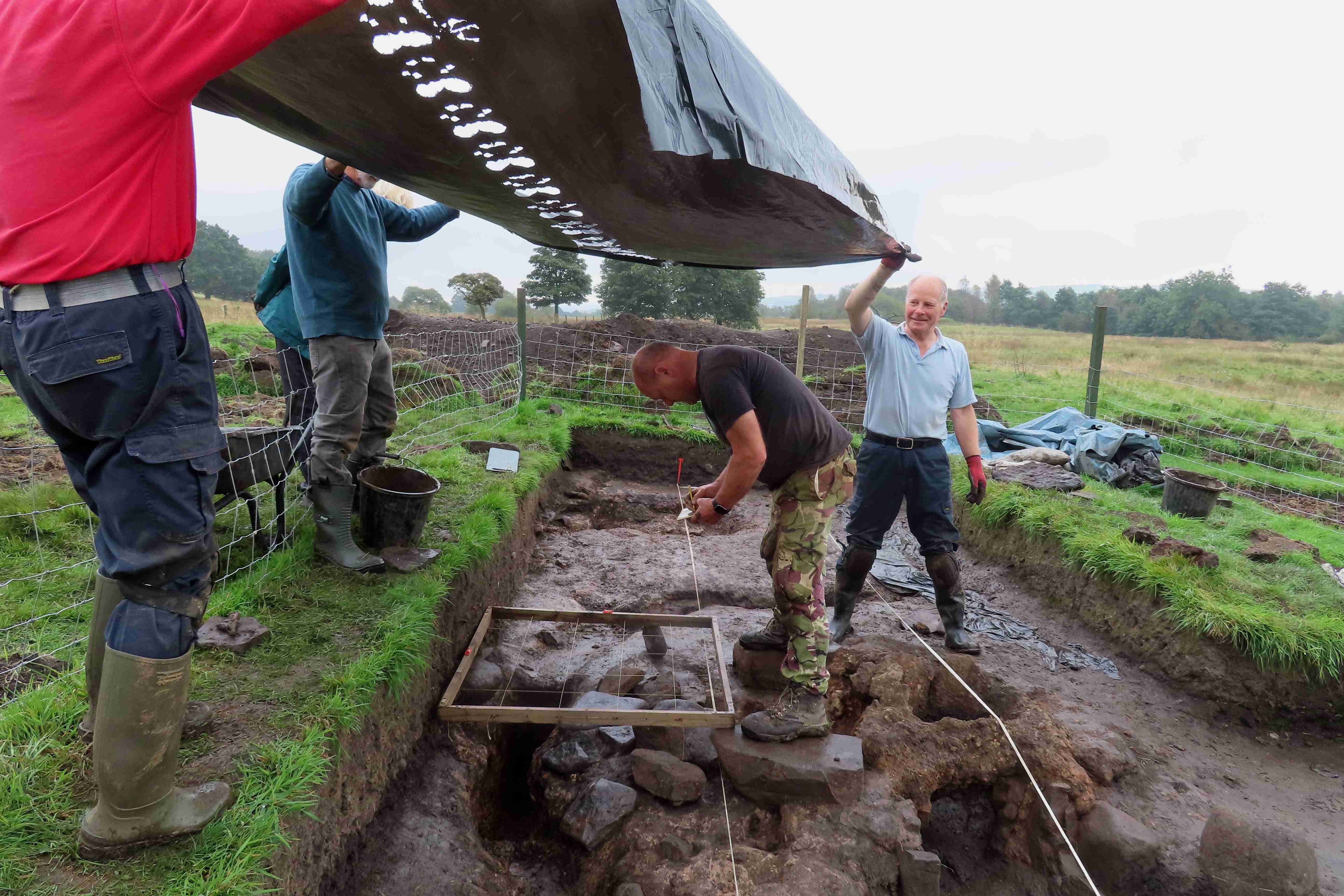
Sept 25 No. 4
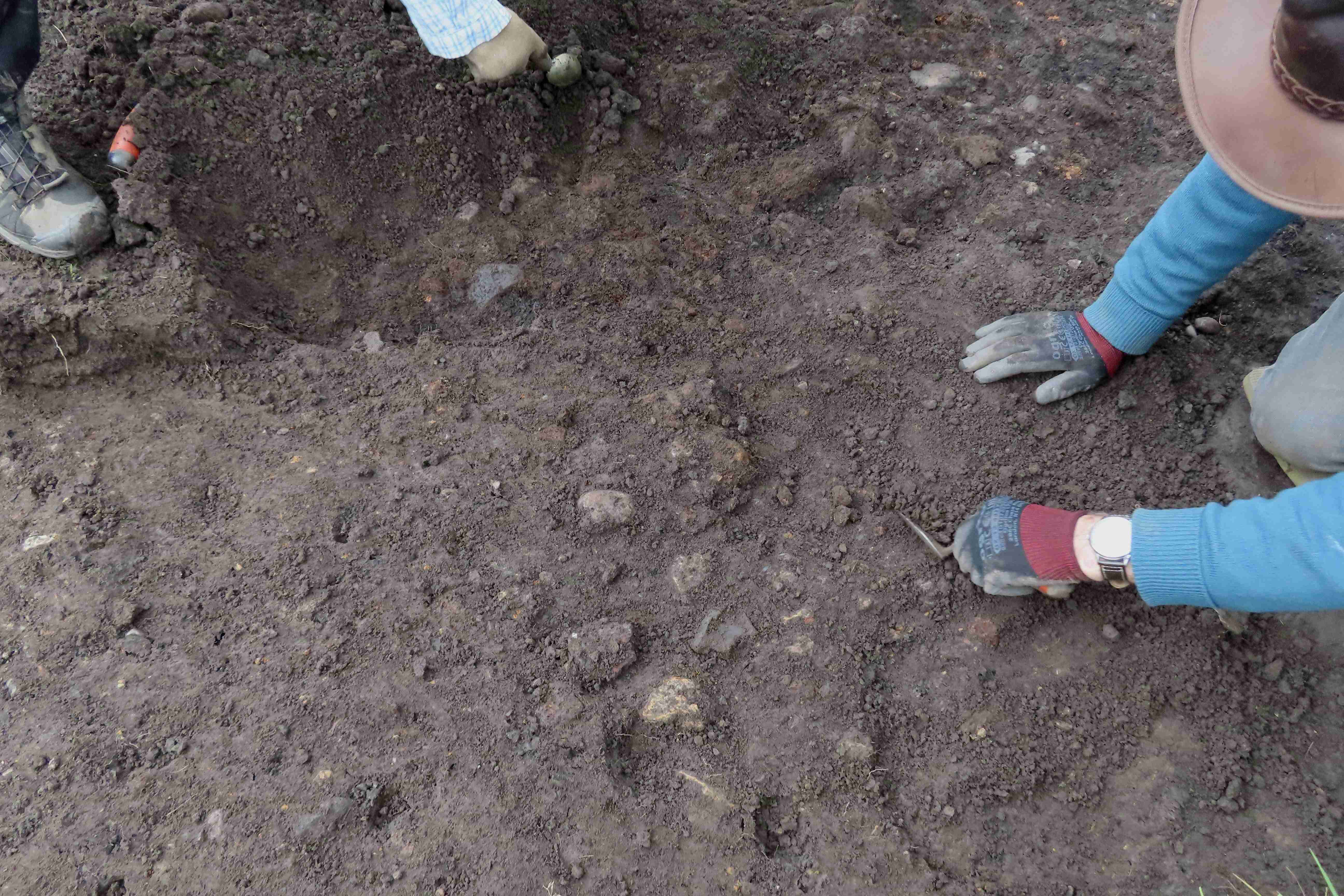
Sept 25 No. 5
Weather overcast, warm with threat of rain.
After the heavy rain since the last dig we were a bit apprehensive about the amount of water that would be in the trenches. We were not disappointed; they were full to the gunwales. It took a lot of work bailing them out before work could commence.
Trench 1
As Neil had a lot of recording to do in this trench, photo 7 Oct No 1, very little other work was carried out.
Due to the wet weather some slippage of the sides of the ‘U’ shaped trench had collapsed. Initially attempts were made to clear the collapsed clay out of the trench but, as the base of the trench could not be readily identified, this task was abandoned to prevent further damage. Photo 7 Oct No 2.
Trench 3
Unfortunately, due to the rain, this trench suffered the same fate as trench 1, i.e. it held a lot of water which had to be bucketed and sponged out. Unfortunately, even after cleaning the trench out, water was still seeping in making excavation very difficult. Although a lot of mud was removed it was not easy, due to the wet conditions, to get a clear view of what has been exposed. Photos 7 Oct Nos 3 and 4. Hopefully the weather in the run up to next Thursday will be dry so it will be easier to inspect the work carried out.
Backfilling
Backfilling of trench 4 continued carried out by 2 of HMHG navigators. Photo 7 Oct No 5.
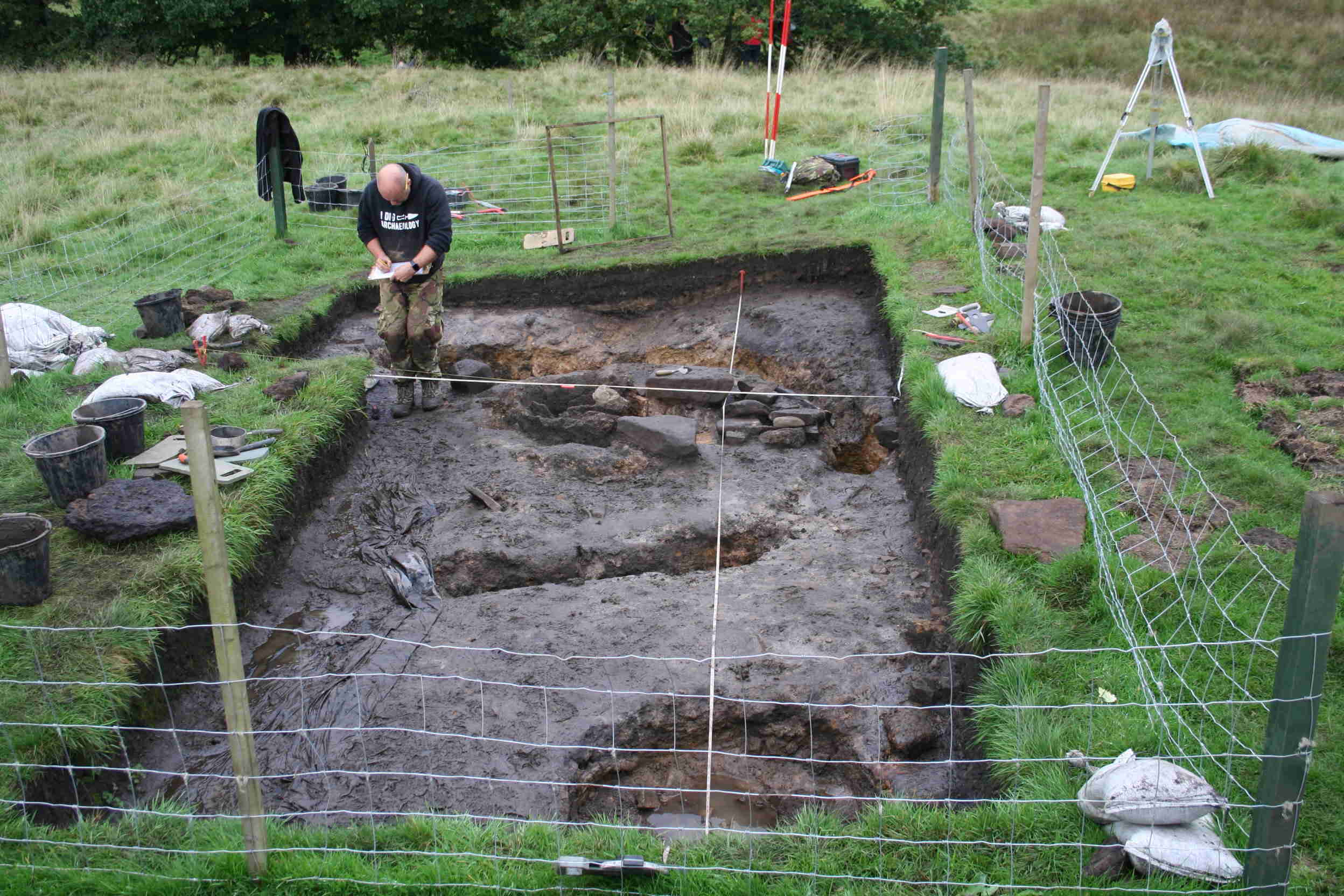
Photo 7 Oct No 1
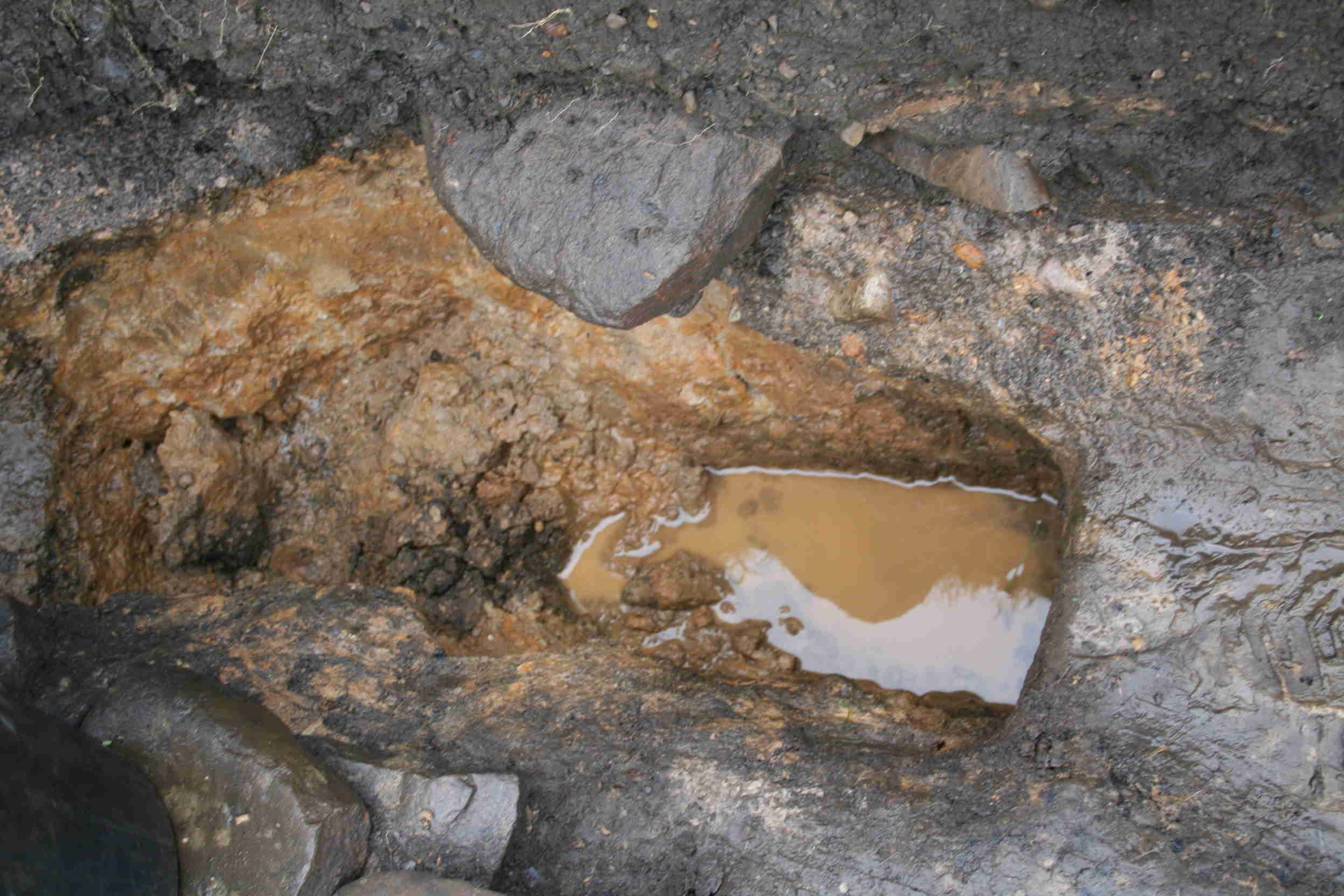
Photo 7 Oct No 2
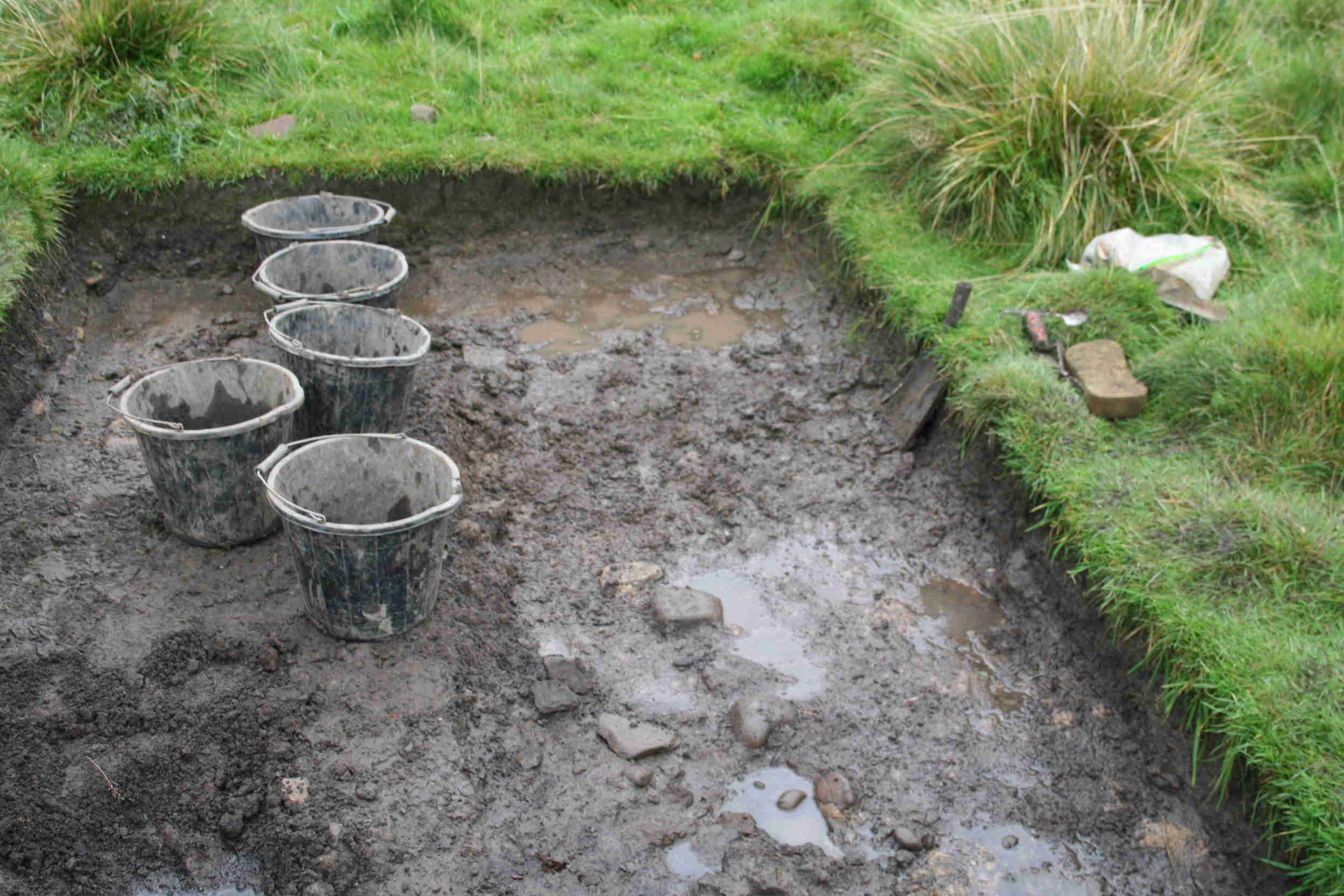
Photo 7 Oct No 3

Photo 7 Oct No 4
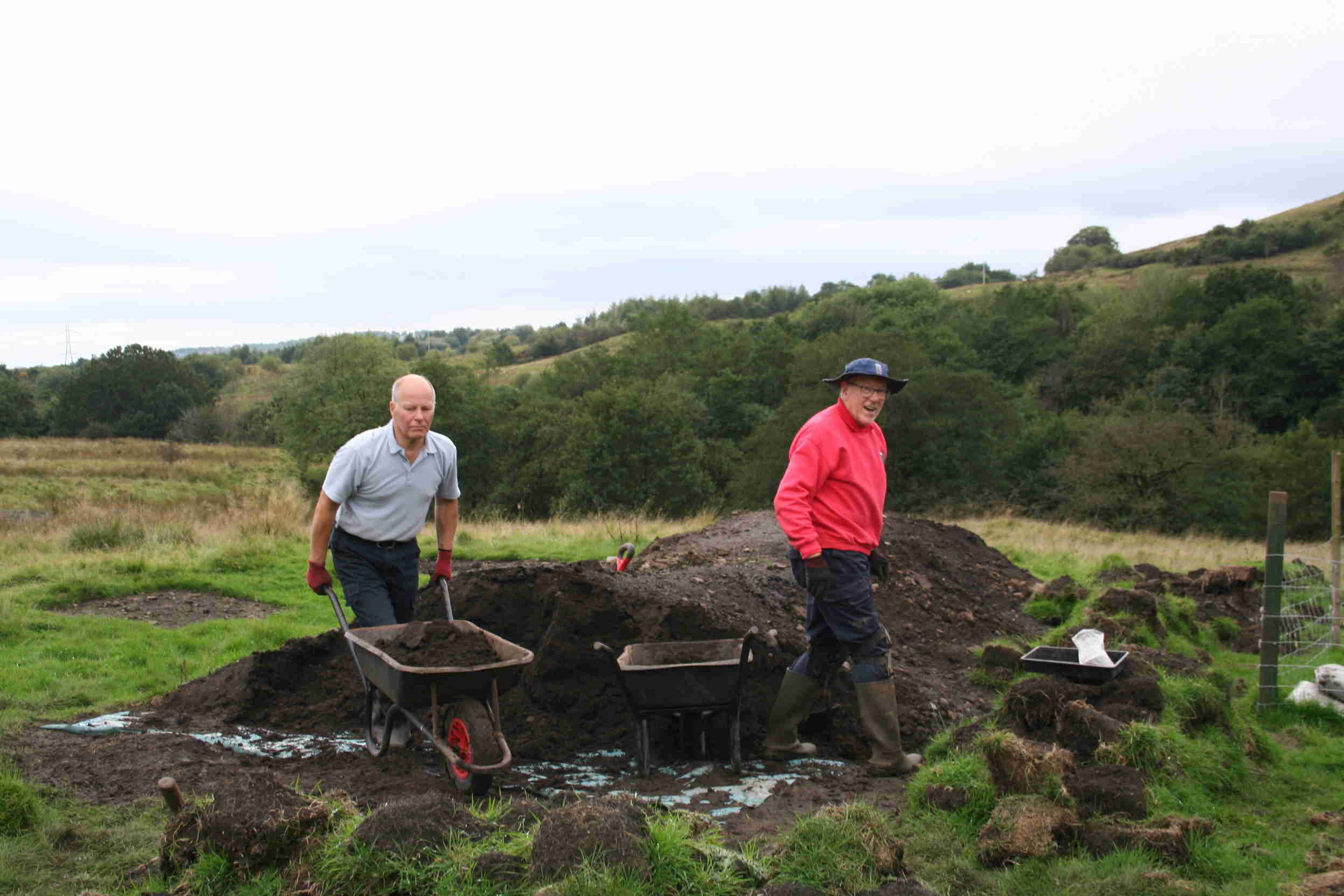
Photo 7 Oct No 5